Inbox and Environment News: Issue 601
October 15 - 21, 2023: Issue 601
Bilgola Plateau Probus Club 1st Birthday
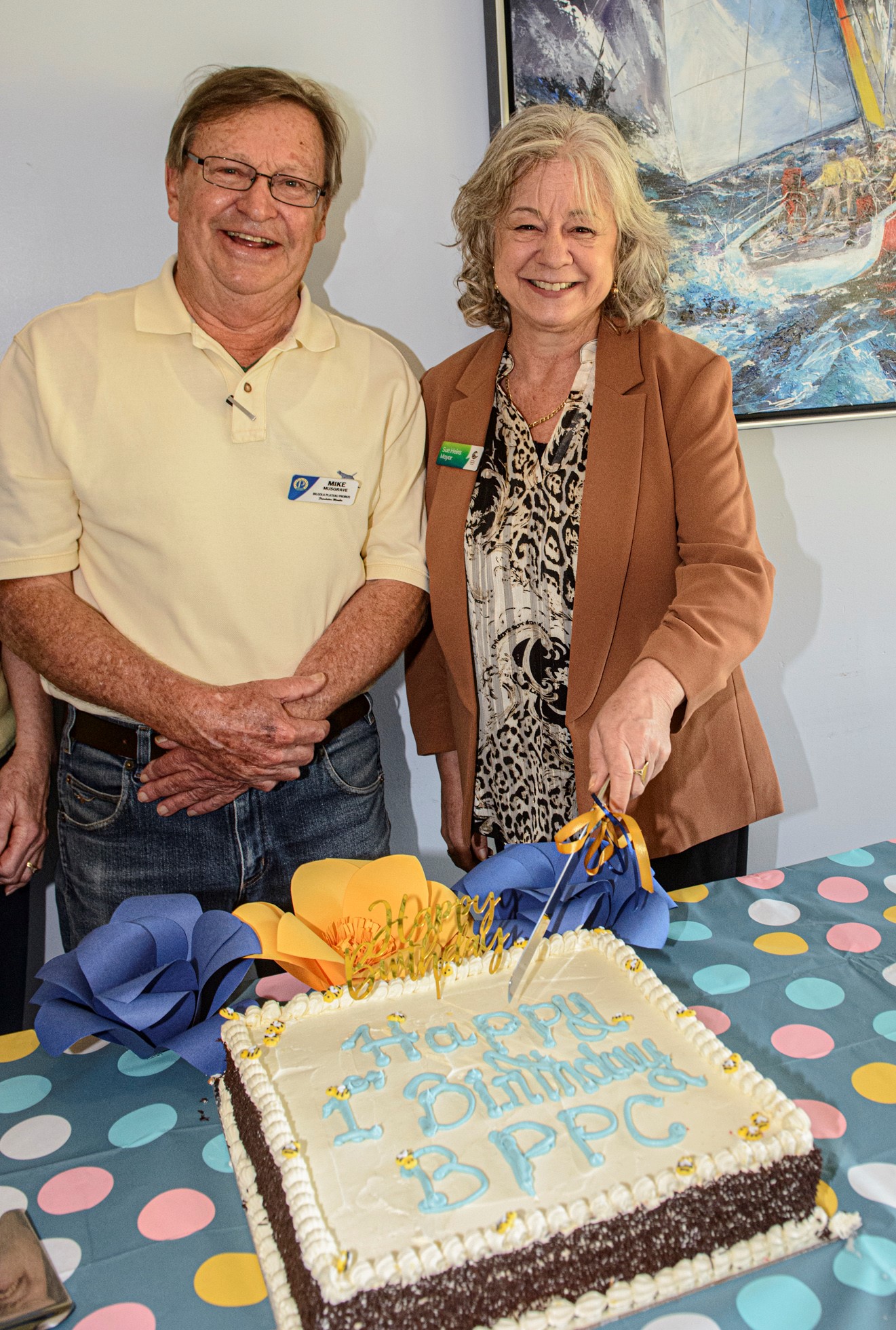




National Immunisation Program – Changes To Shingles Vaccination From 1 November 2023
- people aged 65 years and older
- First Nations people aged 50 years and older
- immunocompromised people aged 18 years and older with medical conditions including:
- haemopoietic stem cell transplant
- solid organ transplant
- haematological malignancy
- advanced or untreated HIV.
Are You Prepared To Manage Older Peoples’ Health During Heatwaves?
- residential aged care
- home and community care.
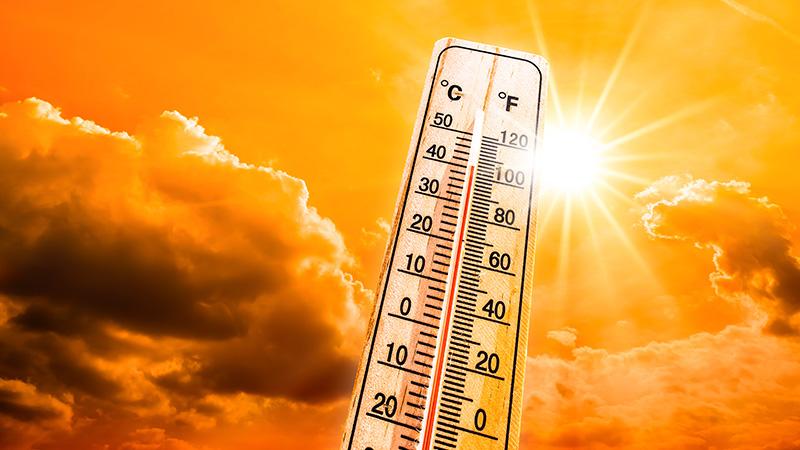
COTA Australia Marks Ageism Awareness Day, Calls For Greater Government Action On Ageism
Campaign Draws Attention To Ageism
- 68% of all over-50s agree “ageism against older people is a serious problem in Australia”. It was 73% for respondents aged 60-69.
- 74% of all over-50s believe Australia is “not doing enough to raise awareness of ageism and fight against it”.
- 58% of over-50s want “a government campaign to raise awareness about ageism and its effects”.
- People in their 60s are the most likely older Australians to have experienced ageism in the past year.
- 36% of over-50s agree with the statement that, “people have assumed I cannot understand or learn new technology”. It was 50% for those aged 90 and over.
- 21% of over-50s say, “People have insisted on doing things for me that I am capable of doing on my own.” It was 35% for over-90s.
- 28% of 50-59-year-olds say, “My applications for jobs have been rejected because of my age.”
- 25% of those in their 50s and 60s say, “I have been made to feel like I am too old for my work.”
- 8% of 50-59-year-olds say, “I have been denied health services or treatment because of my age”, but that figure leaps to 20% among those 90+.
- 28% of over-50s say, “I have been ignored or made to feel invisible.”
- 11% say, “Doctors and healthcare workers talk past me to my companion or carer.” That figure is 27% among those aged over 90.
Manly-Warringah Choir: Tidings Of Comfort And Joy

‘Equal Social Rights For SEXES’: in the 1930s, the Australian Women’s Weekly was a political forum

The Australian Women’s Weekly, the first Australian magazine dedicated solely to the interests of women, turned 90 this year. The magazine is known for its coverage centred around the home and child-rearing, but the early editions of the Weekly also created a space for Australian women to engage with politics through the lens of womanhood.
Since its first edition in June 1933, the Weekly has provided Australian women with a forum to learn, discuss and debate a range of issues. Its coverage throughout the 1930s reveals how the magazine negotiated the tension between conservative and progressive viewpoints on women’s involvement in political affairs.
The Weekly And The 1930s
The magazine’s first editor, George Warnecke, developed a prototype for a publication tailored to female readers after studying women’s interests. He wanted it to be “distinctly Australian [and] appeal across age groups”.
The Weekly was immediately popular. The initial estimated print run of 50,000 copies increased to 121,162 copies. By the end of 1939, the Weekly had a circulation of 445,000.
Originally launched as a “forty-four-page black and white newspaper”, it sold for two pence and followed traditional newspaper formatting, printed in broadsheet columns. It appealed to female readers with engaging images of womanhood – the first issue’s cover story was on Sydney women’s fashion.
However, the paper quickly moved away from this format towards a cover centred on a single evocative image. This change can be seen throughout August and September 1933, when the images on the front cover became increasingly prominent. Eventually, they took over the whole page.
Inside, the paper covered fashion, beauty, homemaking, entertainment – and current affairs. The first edition’s other cover story reported on a recent conference of the Women Voters’ Federation in Adelaide under the headline “Equal Social Rights for SEXES”.
In early issues, political topics were primarily addressed in the “Points of View” column on the editorial page, which acted as a forum for the editorial team to provide short critical commentaries on issues they deemed important to Australian women.
This space included readers’ responses. Another dedicated column, “So They Say”, provided space for readers to discuss previous articles, current affairs and social issues.

Politics And The Home
The Weekly’s coverage and reader contributions on current affairs created a platform for women to dissect political topics. But it balanced the tension between conservative and progressive viewpoints on women’s involvement in politics to cater to their commercial audience.
In a March 1934 editorial, Warnecke declared “this paper knows no politics” and “most women are not specially politically minded”. Women’s sphere of influence, he argued, was the household.
But Warnecke implied that women could still influence society and culture. They were outside formal institutions, but could shape the nation politically in other ways: “public opinion starts off as private opinion, and this is formed in the home”.
The editorial suggested that the Weekly’s coverage was not “non-political”, as one reader, Miss Clarke, interpreted. Rather, the paper managed to establish a forum for both conservative and progressive ideological viewpoints by claiming to separate the social from the political.
An example of this can be seen in the editorial “Women and Democracy”, published on July 14 1934, which showcased the political influence women held over their families:
The fact is that, though [women] may not take a public part in politics, the Australian woman exercises a potent influence at election times, not only because of her voting power, but because of the high esteem in which her opinion is held by the male members of her household.
Warnecke also defended women’s right to vote: “there has never been any serious question of the Australian woman being in an ‘inferior’ position because of her sex”, he argued.
Australian Women’s Political Interest
Although the Weekly often framed political debate through social and cultural lenses, there was still ample traditional political reportage in early editions. This is evident in feature articles, occasional columns and reader contributions that asserted the importance of women’s engagement with political institutions.
Mrs V. Cantwell’s October 1933 contribution positioned her against a fellow reader, identified by the initials A.S., who had declared that women were not interested in politics. Cantwell retorted:
The improved conditions of women and children to-day, as regards social services, general health, etc., are directly attributable to the fact that women are taking an increased and creditable interest in public affairs.
Cantwell’s contribution illustrated the progressive view of modern Australian women. Written in response to another reader, her piece illustrates the Weekly’s willingness to foster dialogue and debate.

Historian Hannah Viney developed the notion of “feminised politics” to describe the way “the threads of the domestic and the politics that were interwoven” in the Weekly’s coverage in the 1950s. Here we can clearly see that the Weekly allowed readers “politically minded, politically ambivalent or somewhere in between” a forum to engage with political coverage in the 1930s as well.
Towards the end of the decade, as war in Europe began to appear inevitable, Weekly readers were eager to understand the extremist ideologies that threatened world peace. This is apparent in Miss M. Muir’s reader contribution published on August 12, 1939, under the headline: “Need knowledge of foreign politics”.
Muir believed fewer than one in 50 Australian women understood what the Nazi, fascist and communist movements stood for. She proposed the Education Department supply paper lectures to Australian women “on possible political dangers”.
“We should not leave the knowledge of modern foreign politics only to the men,” she argued.
The publication of Muir’s piece in a highlighted box in the “So They Say” column implies the paper’s agreement.![]()
Zara Saunders, PhD Candidate, Australian Catholic University
This article is republished from The Conversation under a Creative Commons license. Read the original article.
Please Look Out For Wildlife During This Spring Heat

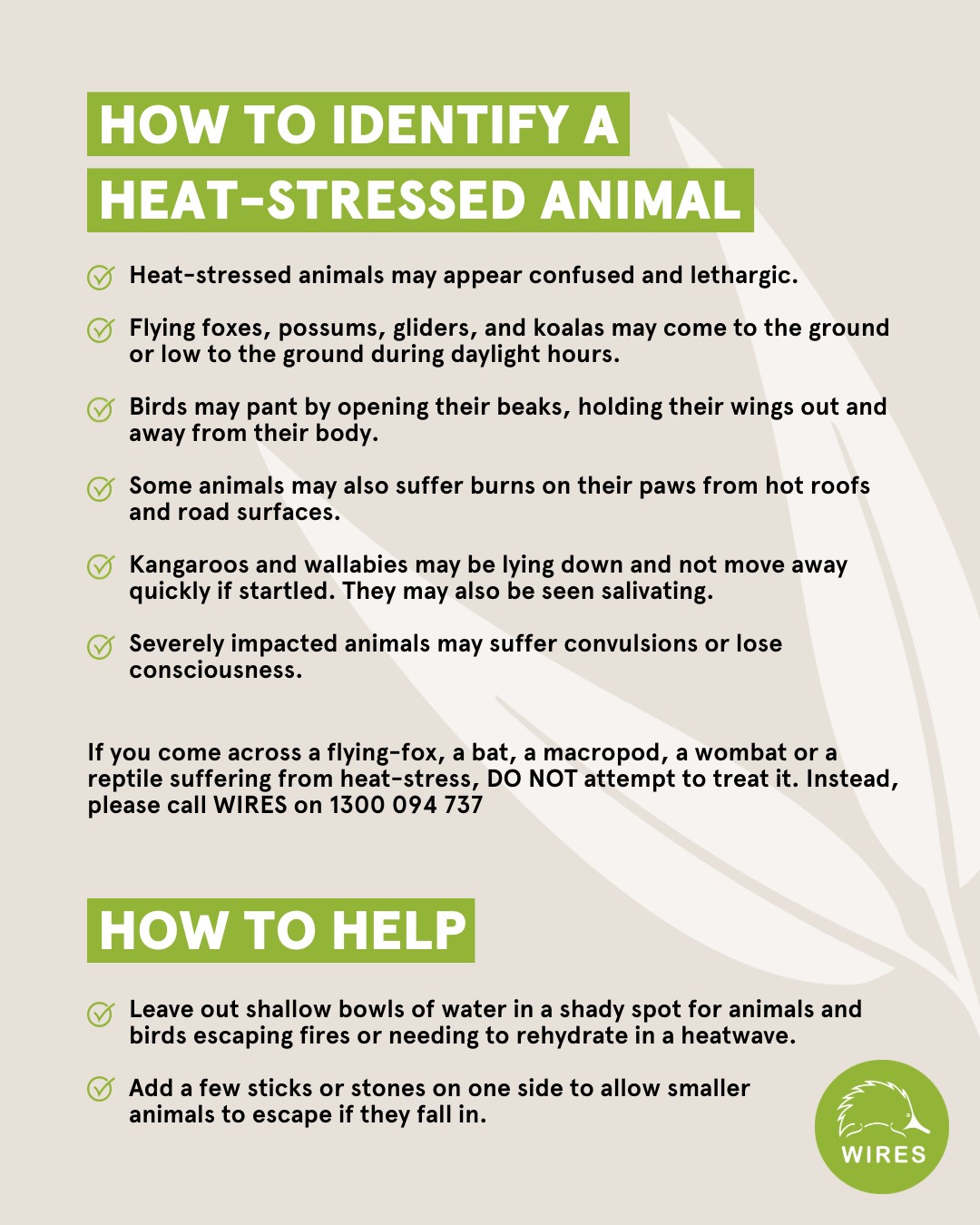
Picnic For Nature
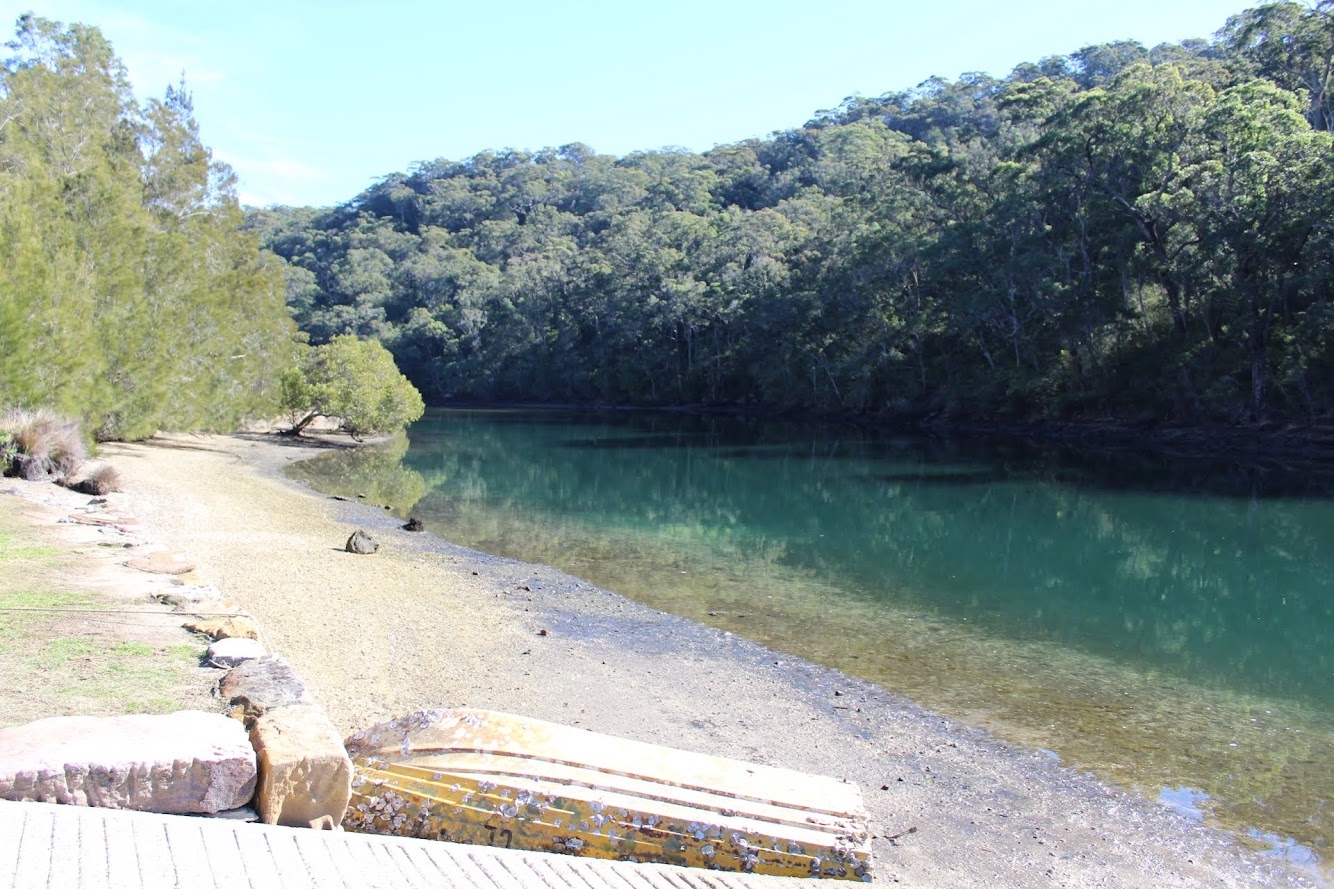
Bushwalk Fundraiser
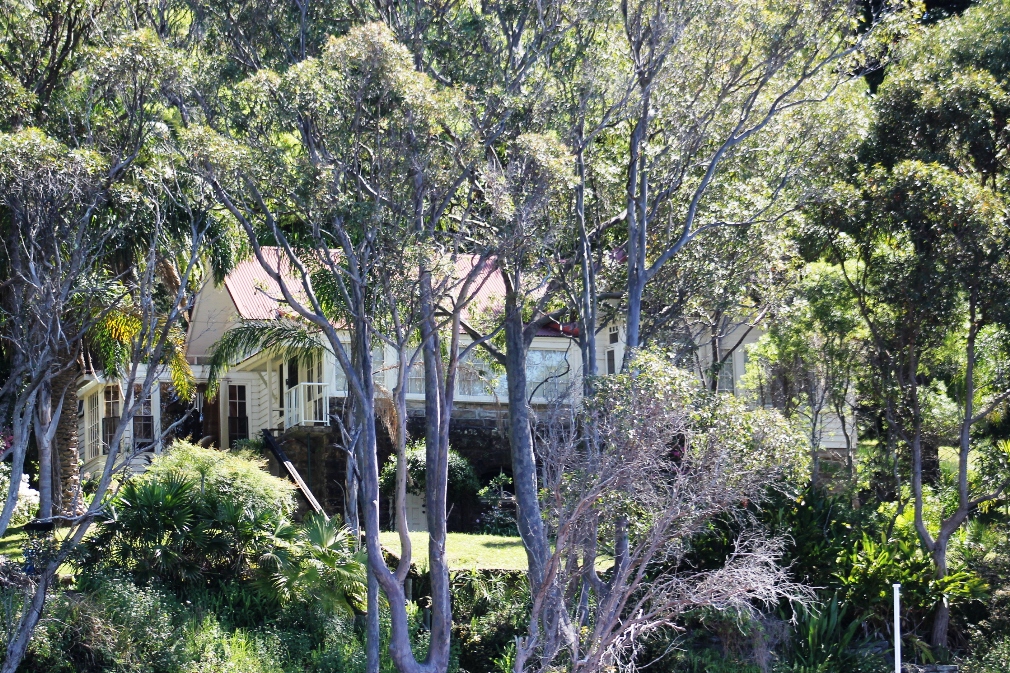
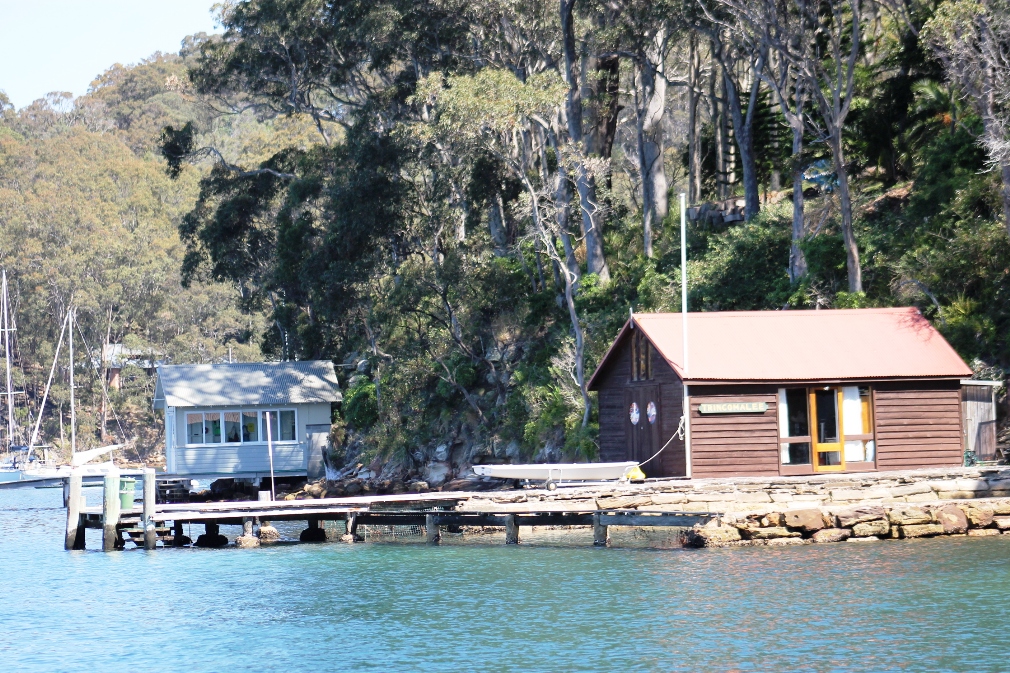
- Friday 10 November
- Friday 8 December
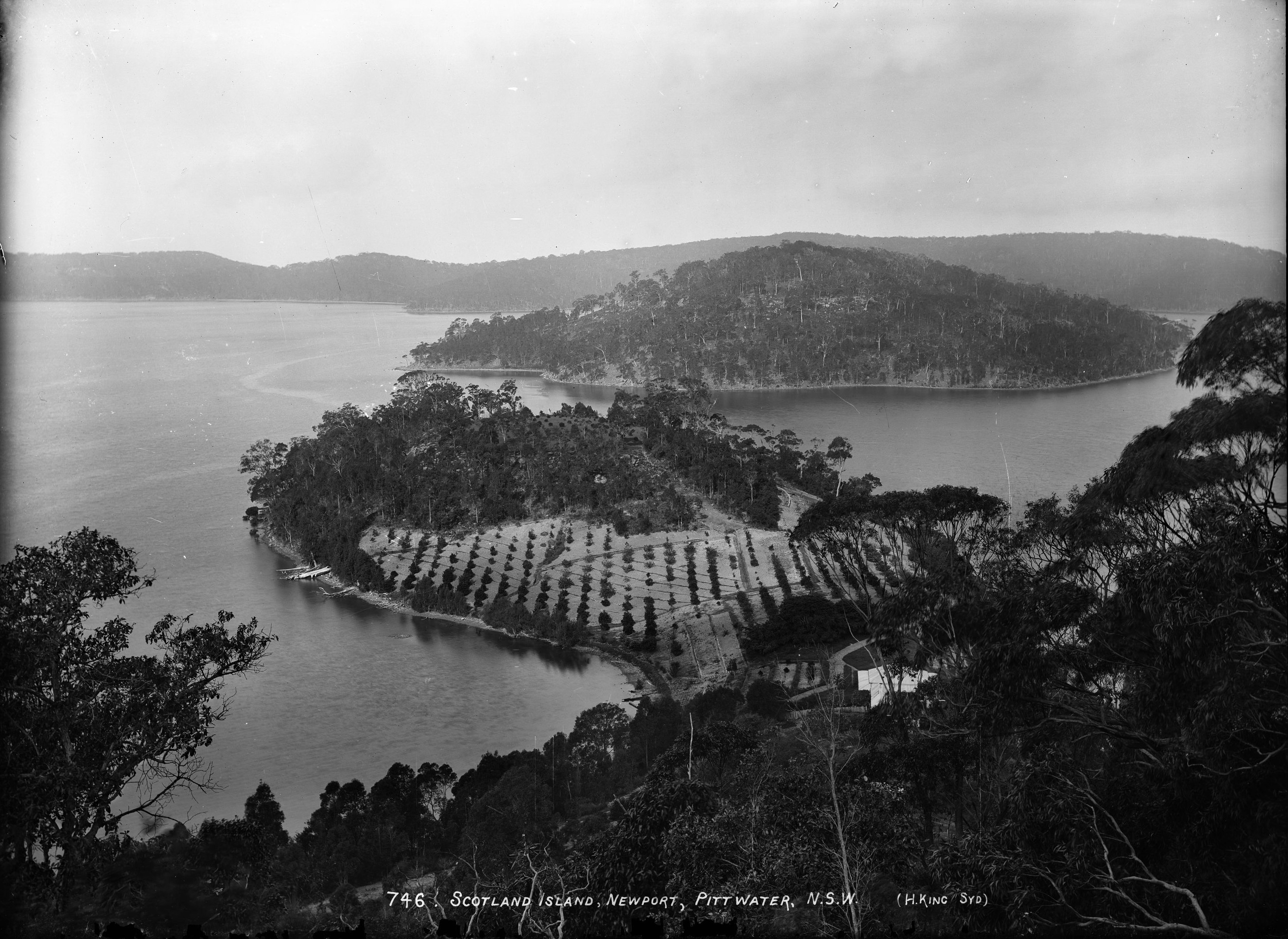
'Scotland Island, Newport, Pittwater, N.S.W.', photo by Henry King, Sydney, Australia, c. 1880-1886. and section from to show cottage on neck of peninsula at western end with no chimneys through roof. From Tyrell Collection, courtesy Powerhouse Museum
𝗞𝗶𝗺𝗯𝗿𝗶𝗸𝗶 𝗥𝗲𝘀𝗼𝘂𝗿𝗰𝗲 𝗥𝗲𝗰𝗼𝘃𝗲𝗿𝘆 𝗖𝗲𝗻𝘁𝗿𝗲 𝗶𝗻𝘃𝗶𝘁𝗲𝘀 𝘁𝗵𝗲 𝗰𝗼𝗺𝗺𝘂𝗻𝗶𝘁𝘆 𝘁𝗼 𝗼𝘂𝗿 𝗢𝗽𝗲𝗻 𝗗𝗮𝘆 𝟮𝟬𝟮𝟯 𝗮𝘁 𝗧𝗵𝗲 𝗛𝗨𝗕 - 𝗞𝗶𝗺𝗯𝗿𝗶𝗸𝗶.
Highlighting the four resident not-for-profit organisations: Peninsula Seniors Toy Recyclers, Bikes4Life, Boomerang Bags Northern Beaches - Kimbriki, Reverse Garbage and their dedicated volunteers.
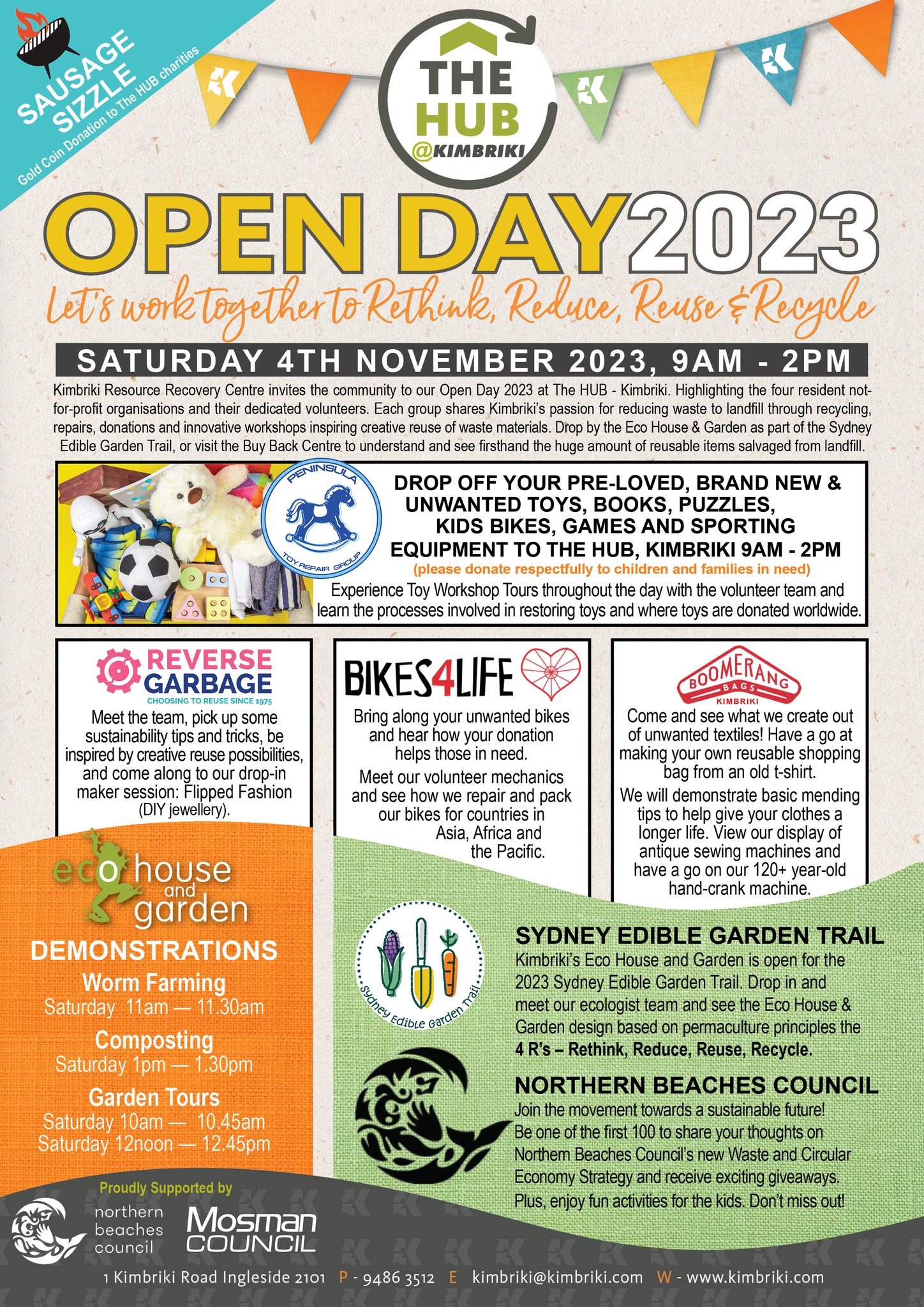
Palmgrove Park Avalon: New Bushcare Group Begins
 Palmgrove Park Avalon is a remnant of the Spotted Gum forest that was once widespread on the lower slopes of the Pittwater peninsula. This bushland’s official name and forest type is Pittwater and Wagstaffe Endangered Ecological Community, endangered because so much has been cleared for suburban development. Canopy trees, smaller trees and shrubs, and ground layer plants make up this community. Though scattered remnant Spotted Gums remain on private land, there is little chance of seedlings surviving in gardens and lawns. More information HERE
Palmgrove Park Avalon is a remnant of the Spotted Gum forest that was once widespread on the lower slopes of the Pittwater peninsula. This bushland’s official name and forest type is Pittwater and Wagstaffe Endangered Ecological Community, endangered because so much has been cleared for suburban development. Canopy trees, smaller trees and shrubs, and ground layer plants make up this community. Though scattered remnant Spotted Gums remain on private land, there is little chance of seedlings surviving in gardens and lawns. More information HERE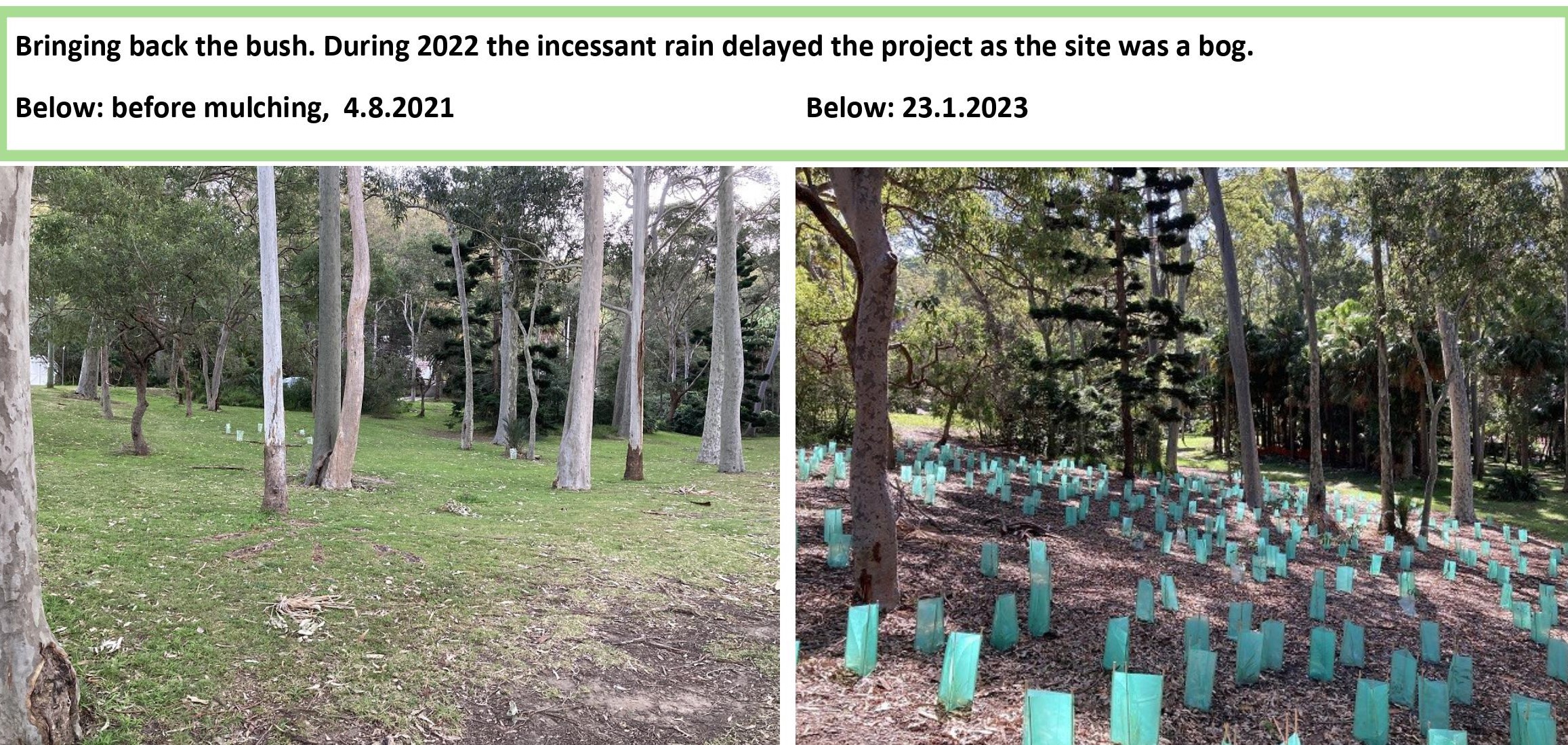
Sydney Wildlife Rescue: Next Rescue And Care Course Commences October 28

PNHA Guided Nature Walks 2023
Our walks are gentle strolls, enjoying and learning about the bush rather than aiming for destinations. Wear enclosed shoes. We welcome interested children over about 8 years old with carers. All Welcome.
So we know you’re coming please book by emailing: pnhainfo@gmail.com and include your phone number so we can contact you if weather is doubtful.
The whole PNHA 2023 Guided Nature Walks Program is available at: http://pnha.org.au/test-walks-and-talks/
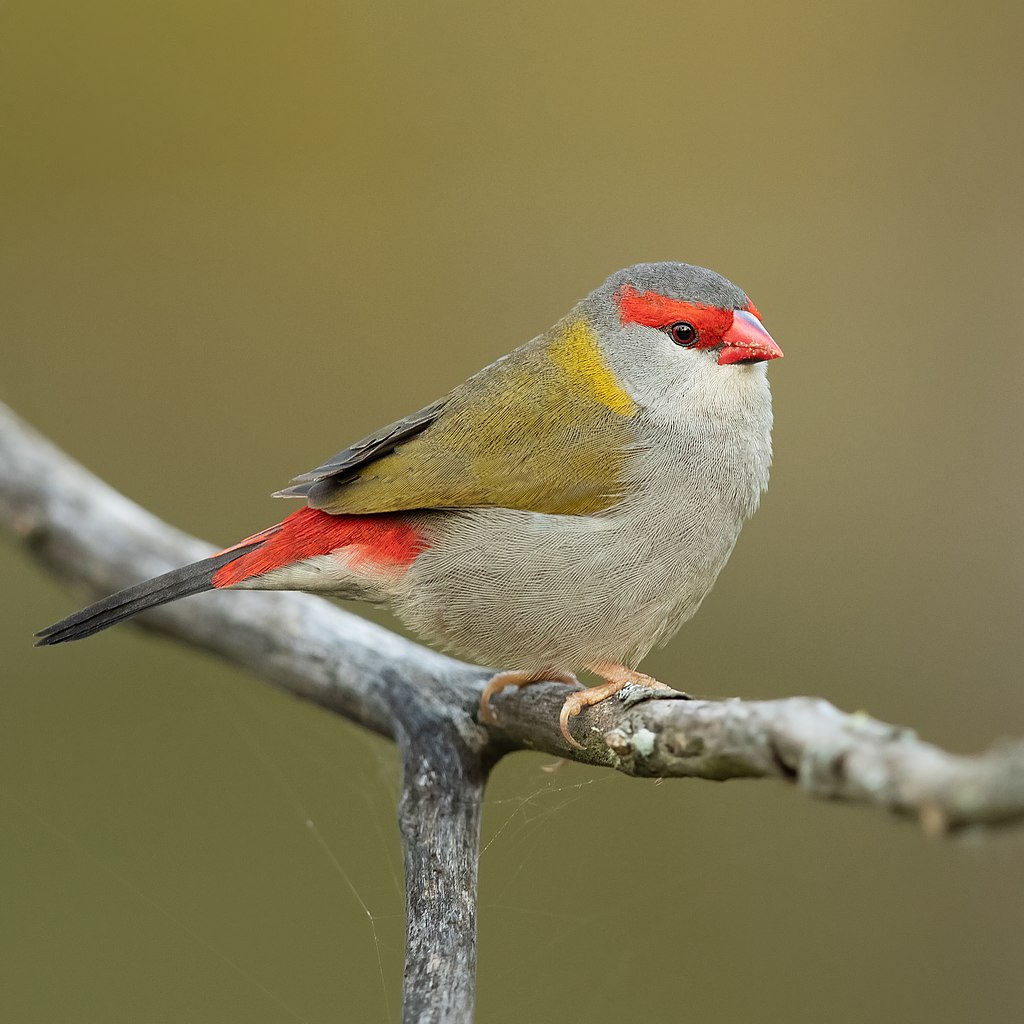
Red-browed finch (Neochmia temporalis). Photo: J J Harrison
Report Fox Sightings
%20(1).jpg?timestamp=1675893929686)
Marine Wildlife Rescue Group On The Central Coast
A new wildlife group was launched on the Central Coast on Saturday, December 10, 2022.
Marine Wildlife Rescue Central Coast (MWRCC) had its official launch at The Entrance Boat Shed at 10am.
The group comprises current and former members of ASTR, ORRCA, Sea Shepherd, Greenpeace, WIRES and Wildlife ARC, as well as vets, academics, and people from all walks of life.
Well known marine wildlife advocate and activist Cathy Gilmore is spearheading the organisation.
“We believe that it is time the Central Coast looked after its own marine wildlife, and not be under the control or directed by groups that aren’t based locally,” Gilmore said.
“We have the local knowledge and are set up to respond and help injured animals more quickly.
“This also means that donations and money fundraised will go directly into helping our local marine creatures, and not get tied up elsewhere in the state.”
The organisation plans to have rehabilitation facilities and rescue kits placed in strategic locations around the region.
MWRCC will also be in touch with Indigenous groups to learn the traditional importance of the local marine environment and its inhabitants.
“We want to work with these groups and share knowledge between us,” Gilmore said.
“This is an opportunity to help save and protect our local marine wildlife, so if you have passion and commitment, then you are more than welcome to join us.”
Marine Wildlife Rescue Central Coast has a Facebook page where you may contact members. Visit: https://www.facebook.com/profile.php?id=100076317431064
- Ph: 0478 439 965
- Email: marinewildlifecc@gmail.com
- Instagram: marinewildliferescuecc

Watch Out - Shorebirds About
.JPG.opt1460x973o0,0s1460x973.jpg?timestamp=1663629195339)
Possums In Your Roof?: Do The Right Thing

Aviaries + Possum Release Sites Needed

Bushcare In Pittwater
Where we work Which day What time
Avalon
Angophora Reserve 3rd Sunday 8:30 - 11:30am
Avalon Dunes 1st Sunday 8:30 - 11:30am
Avalon Golf Course 2nd Wednesday 3 - 5:30pm
Careel Creek 4th Saturday 8:30 - 11:30am
Toongari Reserve 3rd Saturday 9 - 12noon (8 - 11am in summer)
Bangalley Headland 2nd Sunday 9 to 12noon
Bayview
Winnererremy Bay 4th Sunday 9 to 12noon
Bilgola
North Bilgola Beach 3rd Monday 9 - 12noon
Algona Reserve 1st Saturday 9 - 12noon
Plateau Park 1st Friday 8:30 - 11:30am
Church Point
Browns Bay Reserve 1st Tuesday 9 - 12noon
McCarrs Creek Reserve Contact Bushcare Officer To be confirmed
Clareville
Old Wharf Reserve 3rd Saturday 8 - 11am
Elanora
Kundibah Reserve 4th Sunday 8:30 - 11:30am
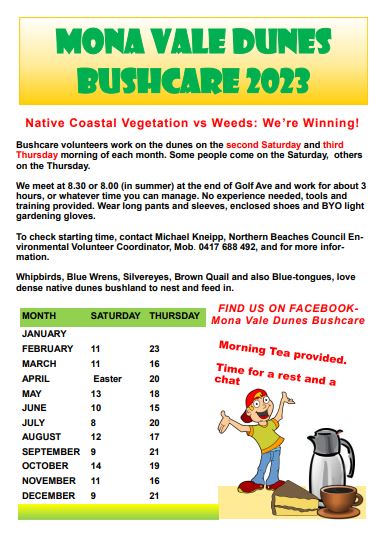 Mona Vale
Mona Vale Mona Vale Beach Basin 1st Saturday 8 - 11am
Mona Vale Dunes 2nd Saturday +3rd Thursday 8:30 - 11:30am
Newport
Bungan Beach 4th Sunday 9 - 12noon
Crescent Reserve 3rd Sunday 9 - 12noon
North Newport Beach 4th Saturday 8:30 - 11:30am
Porter Reserve 2nd Saturday 8 - 11am
North Narrabeen
Irrawong Reserve 2nd Saturday 2 - 5pm
Palm Beach
North Palm Beach Dunes 3rd Saturday 9 - 12noon
Scotland Island
Catherine Park 2nd Sunday 10 - 12:30pm
Elizabeth Park 1st Saturday 9 - 12noon
Pathilda Reserve 3rd Saturday 9 - 12noon
Warriewood
Warriewood Wetlands 1st Sunday 8:30 - 11:30am
Whale Beach
Norma Park 1st Friday 9 - 12noon
Western Foreshores
Coopers Point, Elvina Bay 2nd Sunday 10 - 1pm
Rocky Point, Elvina Bay 1st Monday 9 - 12noon
Friends Of Narrabeen Lagoon Catchment Activities

Gardens And Environment Groups And Organisations In Pittwater
Streets of purple haze: how the South American jacaranda became a symbol of Australian spring
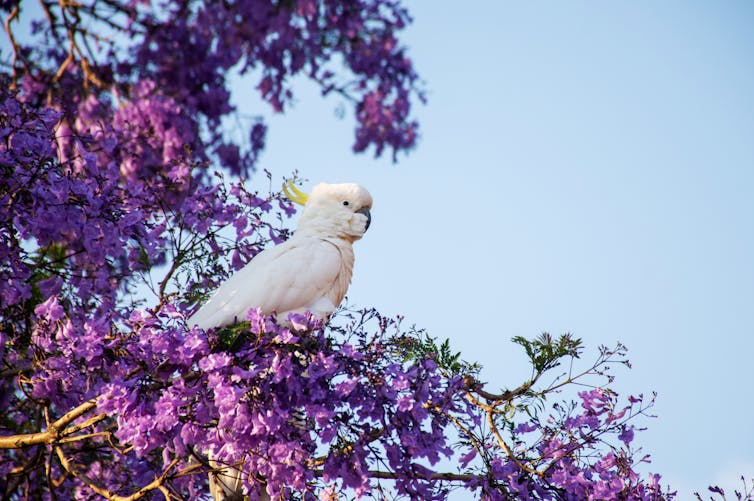
Jacaranda season is beginning across Australia as an explosion of vivid blue spreads in a wave from north to south. We think of jacarandas as a signature tree of various Australian cities. Sydney, Melbourne, Adelaide and Perth all feature avenues of them.
Grafton in New South Wales hosts an annual jacaranda festival. Herberton in Queensland is noted for its seasonal show.
There are significant plantings in many botanic, public and university gardens across Australia. Jacaranda mimosifolia (the most common species in Australia) doesn’t generally flower in Darwin, and Hobart is a little cold for it.
So showy and ubiquitous, jacarandas can be mistaken for natives, but they originate in South America. The imperial plant-exchange networks of the 19th century introduced them to Australia.
But how did these purple trees find their stronghold in our suburbs?
Propagating The Trees
Botanist Alan Cunningham sent the first jacaranda specimens from Rio to Britain’s Kew gardens around 1818.
Possibly, jacaranda trees arrived from Kew in colonial Australia. Alternately, Cunningham may have disseminated the tree in his later postings in Australia or through plant and seed exchanges.
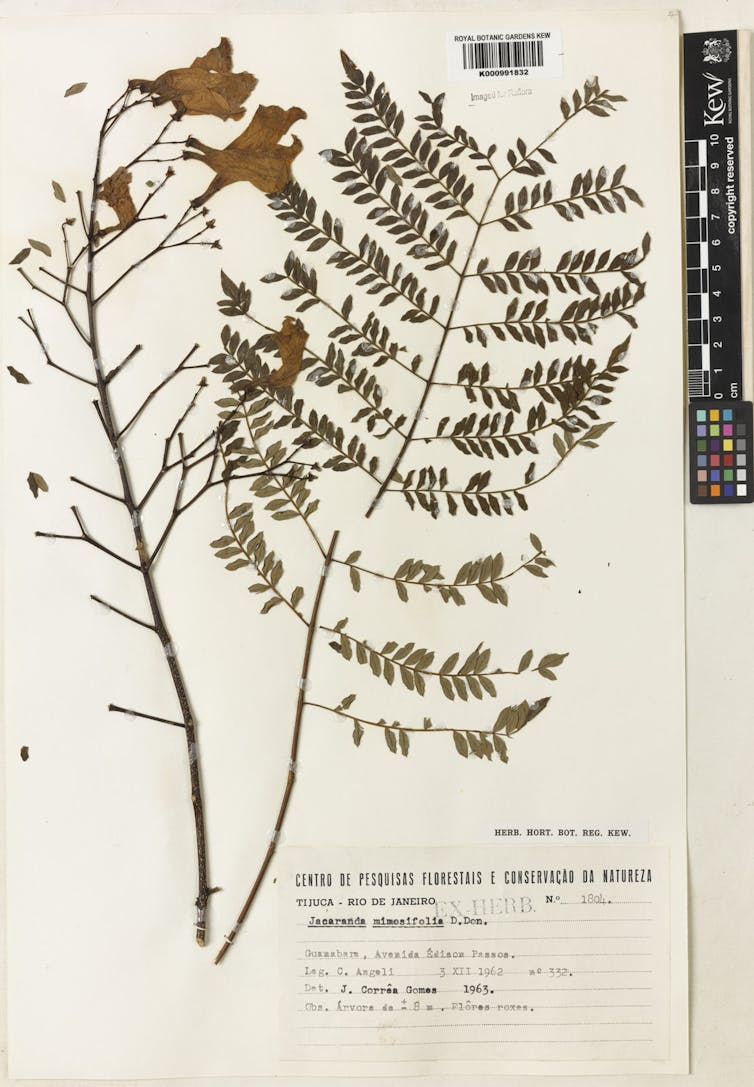
Jacarandas are a widespread imperial introduction and are now a feature of many temperate former colonies. The jacaranda was exported by the British from Kew, by other colonial powers (Portugal for example) and directly from South America to various colonies.
Jacarandas grow from seed quite readily, but the often preferred mode of plant propagation in the 19th century was through cuttings because of sometimes unreliable seed and volume of results.
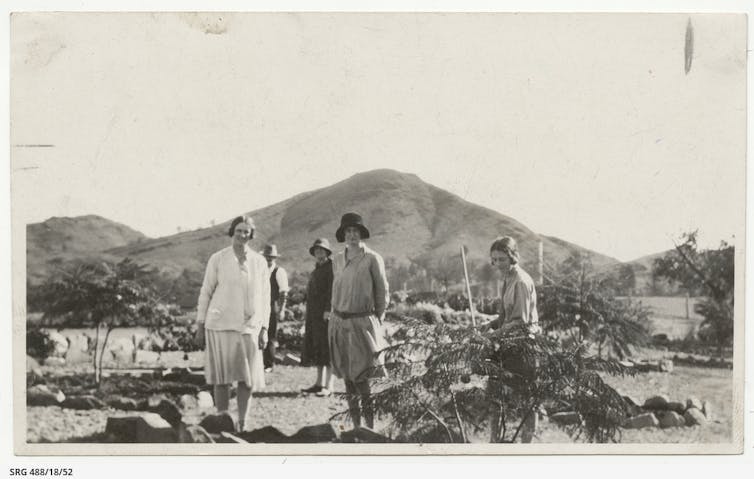
Cuttings are less feasible for the jacaranda, so the tree was admired but rare in Australia until either nurseryman Michael Guilfoyle or gardener George Mortimer succeeded in propagating the tree in 1868.
Once the trees could be easily propagated, jacarandas became more widely available and they began their spread through Australian suburbs.
A Colonial Import
Brisbane claims the earliest jacaranda tree in Australia, planted in 1864, but the Sydney Botanic Garden jacaranda is dated at “around” 1850, and jacarandas were listed for sale in Sydney in 1861.
These early park and garden plantings were eye-catching – but the real impact and popularity of jacarandas is a result of later street plantings.
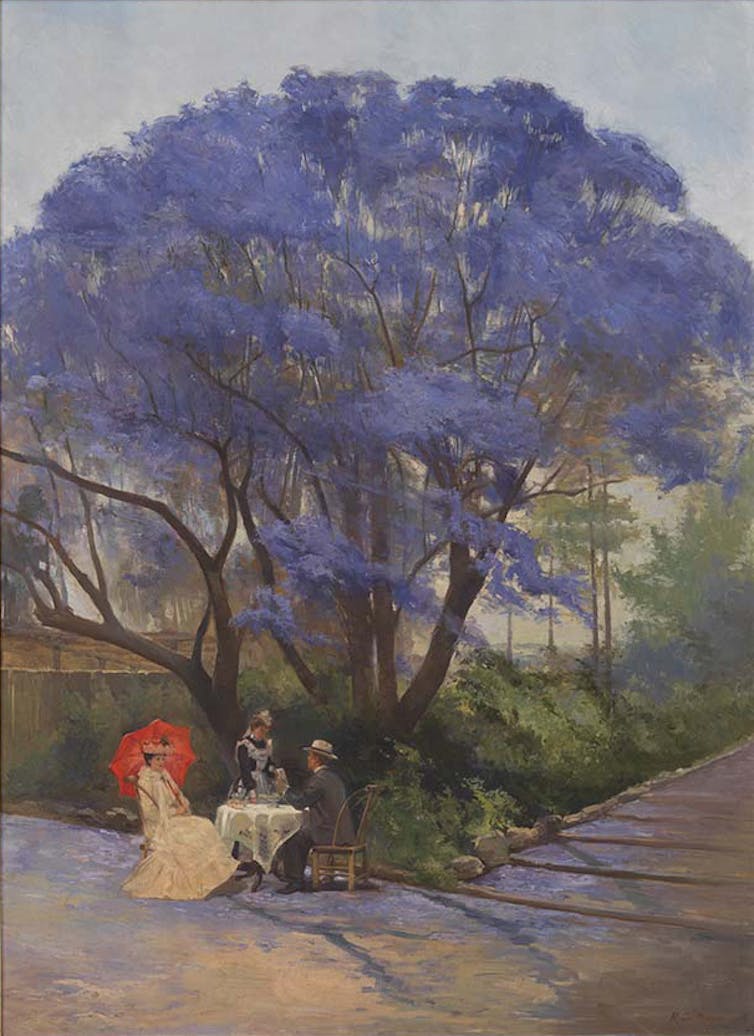
Jacaranda avenues, in Australia and around the world, usually indicate wealthier suburbs like Dunkeld in Johannesberg and Kilimani in Nairobi.
In Australia, these extravagant displays appear in older, genteel suburbs like Subiaco and Applecross in Perth; Kirribilli, Paddington and Lavender Bay in Sydney; Parkville and the Edinburgh Gardens in North Fitzroy in Melbourne; Mitcham, Frewville and Westbourne Park in Adelaide; and St Lucia in Brisbane.
The trend toward urban street avenue plantings expanded internationally in the mid 19th century. It was particularly popular in growing colonial towns and cities. It followed trends in imperial centres, but new colonial cities offered scope for concerted planning of avenues in new streets.

Early Australian streets were often host to a mix of native plants and exotic imported trees. Joseph Maiden, director of the Sydney Botanic Gardens from 1896, drove the move from mixed street plantings towards avenues of single-species trees in the early 20th century.
Maiden selected trees suitable to their proposed area, but he was also driven by contemporary aesthetic ideas of uniformity and display.
By the end of the 19th century, deciduous trees were becoming more popular as tree plantings for their variety and, in southern areas, for the openness to winter sunshine.
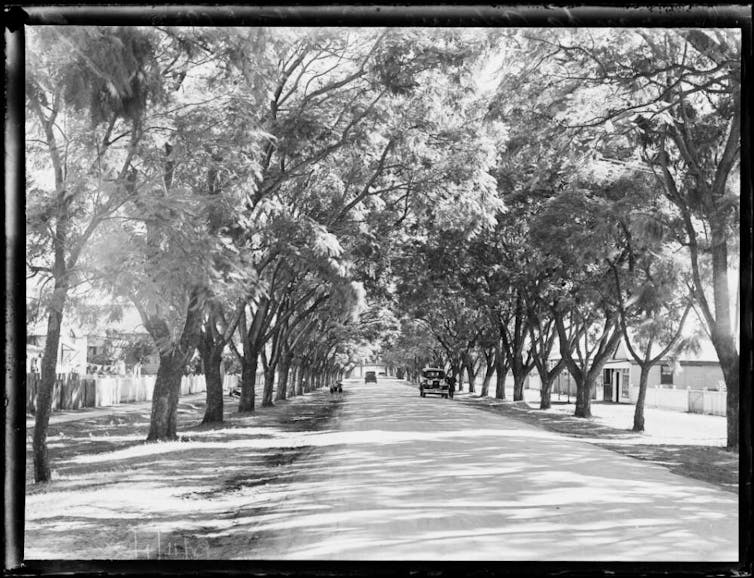
It takes around ten years for jacaranda trees to become established. Newly planted jacarandas take between two and 14 years to produce their first flowers, so there was foresight in planning to achieve the streets we have today.
In Melbourne, jacarandas were popular in post-first world war plantings. They were displaced by a move to native trees after the second world war. Despite localised popularity in certain suburbs, the jacaranda does not make the list of top 50 tree plantings for Melbourne.

In Queensland, 19th-century street tree planting was particularly ad hoc – the Eagle Street fig trees are an example – and offset by enthusiastic forest clearance. It wasn’t until the early 20th century street beautification became more organised and jacaranda avenues were planted in areas like New Farm in Brisbane.
The popular plantings on the St Lucia campus of the University of Queensland occurred later, in the 1930s.
A Flower For Luck
In Australia, as elsewhere, there can be too much of a good thing. Jacarandas are an invasive species in parts of Australia (they seed readily in the warm dry climates to which they have been introduced).
Parts of South Africa have limited or banned the planting of jacarandas because of their water demands and invasive tendencies. Ironically, eucalypts have a similar status in South Africa.

Writer Carey Baraka argues that, however beloved and iconic now, significant plantings of jacarandas in Kenya indicate areas of past and present white population and colonial domination.
Despite these drawbacks, spectacular jacaranda plantings remain popular where they have been introduced. There are even myths about them that cross international boundaries.
In the southern hemisphere – in Pretoria or Sydney – they bloom on university campuses during examination time: the first blooms mark the time to study; the fall of blooms suggests it is too late; and the fall of a blossom on a student bestows good luck.![]()
Susan K Martin, Emeritus Professor in English, La Trobe University
This article is republished from The Conversation under a Creative Commons license. Read the original article.
Climate change is disrupting ocean currents. We’re using satellites and ships to understand how
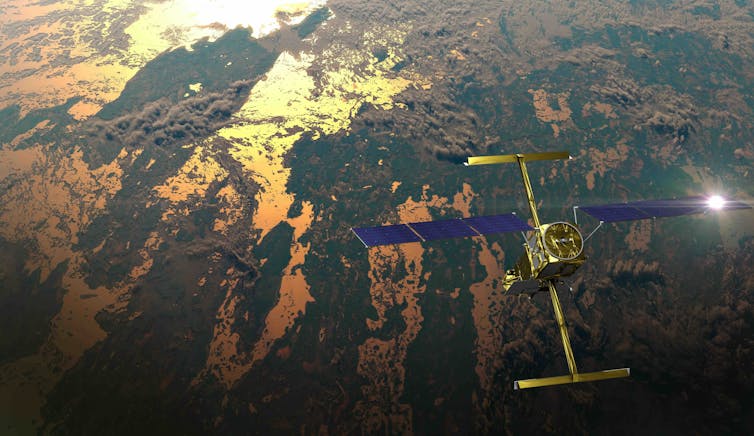
Earth’s ocean is incredibly vast. Some parts of it are so remote that the nearest human habitation is the International Space Station.
As the world warms, what happens in the ocean – and what happens to the ocean – will be vital to all our lives. But to monitor what’s happening in remote waters, we need to study the ocean from space.
Late last year, NASA and CNES, the French space agency, launched a satellite that promises to give scientists a far better view than ever before of the ocean’s surface. The Surface Water and Ocean Topography (SWOT) mission will reveal ocean currents that play a crucial role in the weather and climate.
To make the most of the satellite observations, we need to compare them with measurements made at surface level. That is why we are heading out to sea on the state-of-the-art CSIRO research vessel RV Investigator to gather essential ocean data under the satellite’s path as it orbits Earth.
Current Affairs
Climate change is disrupting the global network of currents that connect the oceans. Researchers have detected a slowdown of the deep “overturning circulation” that carries carbon, heat, oxygen and nutrients from Antarctica around the globe. Meanwhile, at the surface, ocean currents are becoming more energetic.
We have also seen dramatic changes in fast, narrow rivers of seawater called western boundary currents, such as the Gulf Stream and the East Australian Current.
These currents funnel heat from the tropics towards the poles, and in recent decades they have become hotspots for ocean warming. In the Southern Hemisphere, they are warming two to three times faster than the global average.
As these currents destabilise, they alter how heat is distributed throughout the ocean. This in turn will cause major changes in local weather and marine ecosystems that may impact the lives of millions of people.
Playground Physics
The SWOT satellite mission will give researchers a powerful new tool to monitor changes in ocean currents by using accurate satellite measurements of the sea surface – plus a little bit of playground physics.
The satellite carries an instrument that will map variations in the height of the sea surface in unprecedented detail. These variations might be less than a metre in height over horizontal distances of hundreds of kilometres. But oceanographers can use the measurements to estimate ocean currents flowing underneath.
Small variations in the height of the sea surface create horizontal pressure differences that try to push water away from areas of high sea level and towards areas of low sea level. That pressure difference is balanced by the Coriolis force, which gently deflects ocean currents to the right in the Northern Hemisphere and to the left in the Southern Hemisphere.

You can experience the Coriolis force at the playground. Step onto a merry-go-round and ask a friend to stand on the opposite side from you. As you start spinning, toss a ball to your friend. You will notice that the ball appears to be deflected away from the direction of rotation.
In reality, the ball has moved in a straight line; your friend has simply moved away from where you were aiming. But, to you both, the ball seems to have been deflected by an invisible “pseudo-force” – the Coriolis force.
Now imagine the merry-go-round is Earth, and the ball is an ocean current. The Coriolis deflection is enough to balance pressure differences across hundreds of kilometres and causes seawater to flow in ocean currents.
Science At Sea
By carefully measuring the height of the sea surface and using our knowledge of the Coriolis force, oceanographers will be able to use data from NASA’s satellite to reveal ocean currents in greater detail than ever before. But to make sense of that data, researchers need to compare satellite measurements with observations made down here on Earth.
That’s why we are leading a voyage of more than 60 scientists, support staff and crew aboard the RV Investigator, Australia’s national flagship for blue water ocean research.
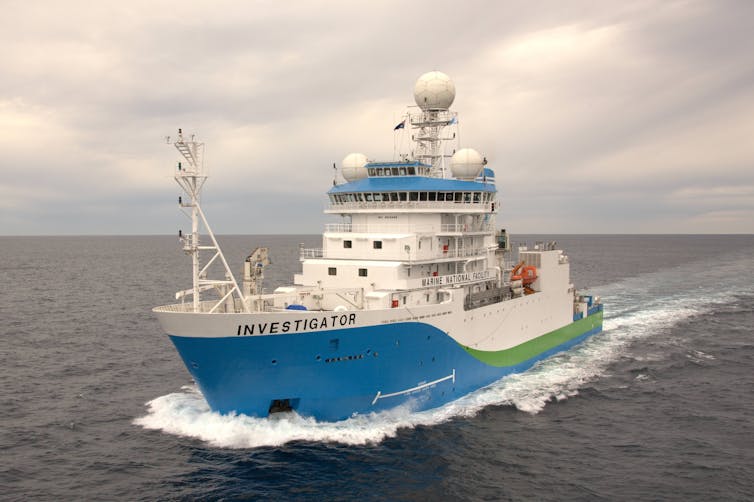
Our 24-day voyage will study ocean dynamics off Australia’s southeast coast using the Investigator’s world-class scientific equipment, including satellite-tracked floating buoys and drifters that will be used to measure the real-time movement of currents at the ocean surface.
The voyage is part of a huge collaboration by scientists around the world to gather observational data under the satellite’s path as it orbits Earth. This data will help validate satellite measurements and improve weather forecasts, including those from Australia’s Bureau of Meteorology, and assist with climate risk assessment and prediction.
We hope to better understand how our oceans are changing using what we observe in space, at sea — and in the playground.
This research is supported by a grant of sea time on RV Investigator from the CSIRO Marine National Facility.
You can follow our voyage on Twitter/X using the hashtag #RVInvestigator.![]()
Shane Keating, Senior Lecturer in Mathematics and Oceanography, UNSW Sydney and Moninya Roughan, Professor in Oceanography, UNSW Sydney
This article is republished from The Conversation under a Creative Commons license. Read the original article.
Why the ‘drug dealers defence’ doesn’t work for exporting coal. It’s actually Economics 101
John Quiggin, The University of QueenslandIn defending a Federal Court case brought by opponents of her decisions to approve two export coal mines, Environment Minister Tanya Plibersek is relying in part on what critics call the “drug dealer’s defence”.
It’s reasoning that argues: if we don’t sell this product, someone else will.
Prime Minister Albanese has argued the same thing, telling The Australian
policies that would just result in a replacement of Australian resources with resources that are less clean from other countries would lead to an increase in global emissions, not a decrease.
Albanese’s reasoning is that saying no to new Australian coal mines wouldn’t cut global emissions, it would just produce “less economic activity in Australia”.
If it sounds like a familiar argument, it is – past prime ministers and the coal industry have made similar claims for decades.
It’s possible to test this argument using economics, putting to one side the question of whether it is morally justifiable.
The Defence Works For Drug Dealers
Let’s look at how this defence works with retail drug dealers, many of whom are drug users themselves.
Street-level drug dealing is a job that doesn’t require much skill and pays above the minimum wage, even after allowing for the risk of arrest.
As a result, as soon as one dealer is arrested, someone will enter the market to replace the dealer. For this reason, drug policy has shifted away from traditional modes of street-level enforcement and towards community partnerships.
But coal is different. Global markets are supplied by a range of producers, each with different costs. Some mines can cover their costs even when world prices are low, others require very high world coal prices to break even.
In the case of metallurgical (coking) coal used to make steel, Australia’s mines are mostly at the low-cost end of the spectrum as shown below:
Indicative hard coking coal supply curve by mine, 2019
Thermal coal, used in electricity generation, is more complex, since much of the variation in price relates to its quality, rather than extraction cost.
Nevertheless, the fact remains that if one producer withdraws from the market or reduces output, it is highly unlikely to be replaced by an identical-cost producer.
It is likely instead to be replaced by a higher-cost supplier who needs a higher price to cover its costs. That’ll make the coal less attractive to the buyer who would have bought from the low-cost producer, making that buyer likely to buy less of it.
This is Economics 101, illustrated in the supply and demand diagrams in just about every economics textbook.
Why Australia’s Coal Matters Globally
In most markets, the demand curve is downward sloping, meaning the higher the price, the less the buyer wants.

And in most markets, the supply curve is upward sloping, meaning the higher the price, the more the seller is prepared to sell.
What’s bought, and for how much, depends on where those curves meet.

If the supply curve moves up, because the cost of supply has increased, the price at which the good is bought will move up and the quantity bought will move down.
In the figure below, the supply curve S1 is the current global supply.
If Australia supplies less coal, the supply curve will shift from S1 to S2, resulting in the higher price P2.
The higher price will result in increased supply from competitors, but also a reduction in the total amount consumed, a cut from Q1 to Q2.
This means that, contrary to government claims, our decisions will have an impact on global emissions and ultimately on global heating
Moreover, Australian decisions aren’t isolated.
All around the world, governments, financial institutions and civil society groups are grappling with the need to transition away from coal.
Proposals for new and expanded coal mines and coal-fired power stations face resistance at every step. In particular, the great majority of global banks and insurance companies now refuse to finance and insure new coal.
This means that the long-run response to a reduction in Australia’s supply of coal will involve less substitution and more of a drop in use than might be thought.
For Coal, The Drug Dealer’s Defence Is Shoddy
It makes the drug dealers defence for exporting coal especially shoddy.
It would be open to Plibersek to make another argument: that in the government’s political judgement, Australians are not willing to wear the short-run costs of a transition from coal, regardless of the impact on the global climate manifested every day in bushfires, floods and environmental destruction.
But instead, we are being told that if Australia cuts supply, other suppliers will rush in, without being told about their costs and what will happen next.
In markets like coal, with a fixed number of suppliers facing different costs, demand responds to the withdrawal of supply in the way the economics textbooks say it should.![]()
John Quiggin, Professor, School of Economics, The University of Queensland
This article is republished from The Conversation under a Creative Commons license. Read the original article.
Australia’s emissions must decline more steeply to reach climate commitment: OECD
Michelle Grattan, University of CanberraAustralia’s emissions need to decline “on a much steeper trajectory” if it is to meet its declared commitment of a 43% reduction by 2030 and net zero by 2050, the Organisation of Economic Co-operation and Development says.
In its report on Australia, released as part of its Going For Growth update on Tuesday, the OECD recommends Australia develop
a national, integrated long-term emissions reduction strategy with clear goals and corresponding policy settings to achieve climate targets.
The OECD also suggests broadening the scope of Australia’s so-called Safeguard Mechanism, which at present regulates the emissions of Australia’s 215 biggest polluting facilities.
It awards Australia a score on carbon pricing well below the OECD average and even further below that of the top OECD performers.
It says the share of renewables in Australia’s energy supply averaged only 7.7% between 2019 and 2021, compared to an average of 22.1% for OECD members, and 55.5% for the top performers.

The OECD is a forum of 38 mainly high-income countries, including Australia, that describe themselves as committed to democracy and market economies.
The report is critical of Australia’s performance on a number of other fronts, including income support for the unemployed, job market flexibility and the recognition of trade qualifications.
It says Australia’s JobSeeker unemployment benefit remains among the lowest in the OECD and below the relative poverty line when compared to the wages available from work.
The Albanese government has increased the rate of JobSeeker in the May budget. The report recommends the government consider “further increasing” it.
Declining Productivity, Declining Competitiveness
The OECD finds signs of “reduced competitive intensity” in product markets, as well as falling labour mobility. “Productivity growth has also slowed down.” It says about one in five workers needs a licence to do their work, raising economic costs, and calls for automatic mutual recognition of licenses across states.
Access to fast broadband is low compared to other developed countries, and the take-up of digital technologies by businesses can be improved, the report says.
The OECD also draws attention the “large” gaps in economic and wellbeing measures between Indigenous and other Australians. It recommends the government “embed the Productivity Commission Indigenous Evaluation Strategy in the policy design and evaluation process of all Australian government agencies”.
Workforce Transformation Needed For 2050 Target
Meanwhile, a report prepared by Jobs and Skills Australia entitled The Clean Energy Generation: workforce needs for a net zero economy says the government’s 2050 net-zero emissions target will require a transformation in the workforce that is “substantial but not unprecedented”.
“Like the post-war industrial transformation and the digital transformation of the late twentieth century, a new generation of workers will be required, both from existing energy sectors and through new pathways into clean energy. New jobs, skills, qualifications, training pathways, technologies and industries will emerge over the next 30 years,” the report says.
“Australia will need to consider the full range of levers across the education, training, migration, procurement, and workplace relations systems to ensure a sustainable and equitable path towards net zero.”
Treasurer’s Response To OECD
Treasurer Jim Chalmers said the Albanese government was acting on the areas identified in the OECD report.
Its policies were “focused on maximising the opportunities of the energy transformation, embracing digitalisation and new technology and investing in our people and their skills so that we can build a more productive, prosperous and dynamic economy”.
“We’re securing faster progress towards decarbonisation through our safeguard mechanism, over $40 billion of investment in the energy transformation, our sustainable finance strategy, and establishing a new Net Zero authority to train workers and prepare communities for new opportunities here,” Chalmers said.![]()
Michelle Grattan, Professorial Fellow, University of Canberra
This article is republished from The Conversation under a Creative Commons license. Read the original article.
Why Australia urgently needs a climate plan and a Net Zero National Cabinet Committee to implement it
Tony Wood, Grattan InstituteAustralia has a legislated target to reduce greenhouse emissions, a federal government with commitments to increase the share of renewable electricity and reduce power prices, and a globally important economic opportunity at its feet.
In the second half of the government’s current term, delivery looks hard across the board. All is not lost, but we must transform our economy to a timetable. The unprecedented scale and pace of the economic transformation, and the consequences of failure, demand an unprecedented response.
To get things on track requires the government to develop a plan with the right mix of political commitment, credible policies, coordination with industry, and support from communities. And, critically, the plan must be implemented. Too often targets have been set without being linked to policies to achieve them, or linked so poorly that the extra cost and delay sets back the climate transition.
By the middle of this year, Australia’s emissions were 25 per cent below the 2005 level. But the trend of steady reductions has stalled, and sectors such as transport and agriculture have moved in the wrong direction.
Such ups and downs will continue in response to external events, as we have seen with COVID, droughts, and war on the other side of the world. Policies must be flexible if they are to remain broadly on course in the face of such events.
Trouble In The Power Department
The detail matters: national emissions reductions have slowed, as has the growth in renewable generation towards the government’s 2030 target of 82 per cent.
At the same time, the government’s target of lower power bills by 2025 looks out of reach, and electricity reliability is threatened as coal-fired generation closes without adequate replacement.
The production and use of natural gas contributes around 20 per cent of Australia’s emissions. The use of gas in industry will be covered by the Safeguard Mechanism, a policy designed by the Coalition and now revised by Labor, to drive down emissions from the country’s 200 biggest emitters.
Emissions from gas-fired power generation will fall with the growth of renewables. But there are no constraints on fossil gas use in other sectors, such as our homes.
Industrial emissions are slowly growing. The huge amount of hype about green hydrogen has so far proven to be little more than that: Australia continues to have lots of potential green hydrogen projects, but virtually none are delivered.
Finally, we remain without constraints on vehicle emissions, and with a large herd of grazing cattle and sheep whose emissions are determined more by the weather than the actions of our best-meaning farmers.
The Risk Of Swinging From Naive To Negative
So, we are in a hard place. Naïve optimism about an easy, cheap transition to net zero is at risk of giving way to brutal negativity that it’s all just too hard. The warnings of early spring fires and floods in Australia and extreme heat during the most recent northern hemisphere summer will feed this tension.
The federal government’s latest Intergenerational Report provides a deeply disturbing snapshot of the potential economic impacts if we fail to get climate change under control. Yet in a world 3 to 4 degrees hotter than pre-industrial levels, economic impacts could be the least of our worries.
The task is unparalleled outside wartime. Within 30 years we must manage the decline of fossil fuel extractive sectors, transform every aspect of our energy and transport sectors, reindustrialise much of manufacturing, and find solutions to difficult problems in agriculture.
What’s to be done?
The Need For A Net Zero National Cabinet Committee
We should begin with leadership across the federal government, coordinated with the states and territories. The best structure might be a Net Zero National Cabinet Committee with two clear objectives – to develop and begin implementing a national net zero transformation plan by the end of 2024.
Modern governments are more than happy to set targets and announce plans to meet them. They seem to have lost the capacity or will to implement such plans. The Net Zero Economy Agency, created in July and chaired by former Climate Change Minister Greg Combet, could be charged with that task.
The first step is being taken – the Climate Change Authority is now advising on emissions reduction targets for 2035 and perhaps beyond. The government’s work to create pathways to reducing emissions in every economic sector must be used to build a comprehensive set of policies that are directly linked to meeting the targets.
How To Get Electricity Moving In The Right Direction
The electricity sector can be put on track with three actions. One, drive emissions reduction towards net zero using a sector-focused policy such as the Renewable Energy Target or the Safeguard Mechanism.
Two, implement the Capacity Investment Scheme, a policy intended to deliver dispatchable electricity capacity to balance a system built on intermittent wind and solar supply.
Three, set up a National Transmission Agency to work with the Australian Energy Market Operator (AEMO) to plan the national transmission grid and with authority to direct, fund, and possibly own that grid.
For heavy industry, the scale and pace of change demands a 21st-century industry policy, in three parts. Activities such as coal mining will be essentially incompatible with a net-zero economy. Activities such as steel-making may be able to transform through economic, low-emissions technologies.
Finally, activities such as low-emissions extraction and processing of critical energy minerals, which are insignificant today but which in time could help Australia to capitalise on globally significant comparative advantages.
Create A Plan – And Stick To It
The government has made a good start by revising the Safeguard Mechanism and the Hydrogen Strategy and developing a Critical Minerals Strategy. These should be brought together in an overarching policy framework with consistent, targeted policies linked to clear goals, developed and executed in sustained collaboration with industry.
The Safeguard Mechanism will need to be extended beyond 2030 and its emissions threshold for the companies it covers lowered to 25,000 tonnes of emissions per year.
Industry funding will probably need to expand, and give priority to export-oriented industries that will grow in a net-zero global economy. And the federal and state governments should phase out all programs that encourage expansion of fossil fuel extraction or consumption.
In transport, long-delayed emissions standards should be set and implemented. Finally, government-funded research, some of it already underway, should focus on difficult areas such as early-stage emissions reduction technologies in specific heavy industries, transport subsectors, and emissions from grazing cattle and sheep.
There is little new or radical in the elements of this plan. What would be new is a commitment to its design and implementation. This is what government needs to do now. The consequences of failure are beyond our worst fears, the benefits of success beyond our best dreams.![]()
Tony Wood, Program Director, Energy, Grattan Institute
This article is republished from The Conversation under a Creative Commons license. Read the original article.
Even temporary global warming above 2℃ will affect life in the oceans for centuries
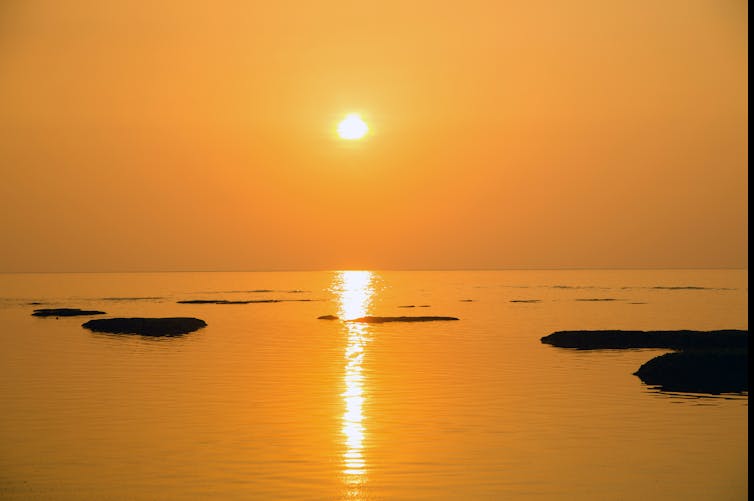
There is growing consensus that our planet is likely to pass the 1.5℃ warming threshold. Research even suggests global warming will temporarily exceed the 2℃ threshold, if atmospheric carbon dioxide (CO₂) peaks at levels beyond what was anticipated.
Exceeding our emissions targets is known as a climate overshoot. It may lead to changes that won’t be reversible in our lifetime.
These changes include sea-level rise, less functional ecosystems, higher risks of species extinction, and glacier and permafrost loss. We are already seeing many of these changes.
Our newly published research investigates the implications of a climate overshoot for the oceans. Across all climate overshoot experiments and all models, our analysis found associated changes in water temperatures and oxygen levels will decrease viable ocean habitats.
The decrease was observed for centuries. This means humanity will continue to feel its impacts long after atmospheric CO₂ levels have peaked and declined.
What Did The Study Look At?
Our analysis is based on simulations with Earth system models as part of the Coupled Model Intercomparison Project (CMIP6). The project underpins the latest assessment reports by the Intergovernmental Panel on Climate Change (IPCC).
We looked at multi-model results from two different CMIP6-developed experiments that simulate a climate overshoot.
One corresponds to a climate scenario simulating an overshoot this century.
The other experiment is from the Carbon Dioxide Model Intercomparison Project (CDRMIP). It was designed to explore the reversibility of a climate overshoot and how this impacts the Earth system.
We studied the combined effects of changes in ocean temperature and oxygen levels. These changes are linked because the warmer the water, the less dissolved oxygen it can hold.
In this study we explored what warmer oceans and deoxygenation mean for the long-term viability of marine ecosystems. These changes have already begun under climate change.
To quantify these impacts we used a metabolic index, which describes the (aerobic) energy balance of individual organisms. In viable ecosystems the supply of oxygen needs to exceed their demand. The closer supply is to demand, the more precarious ecosystems become, until demand exceeds supply and these ecosystems are no longer viable.
Under global warming in the ocean we are already seeing an increase in metabolic demand and reduction in supply due to deoxygenation.
The index gives us the ability to assess how changing ocean temperatures impact the long-term viability of different marine species and their habitats. This allows us to explore how ecosystems across the world’s oceans respond to a climate overshoot, and for how long these changes will persist.
As conditions changed under the scenarios, we followed the evolution of the global ocean volume that can or cannot support the metabolic demands of 72 marine species.
What Did The Study Find?
Across all climate overshoot experiments and all models, our findings show the water volumes that can provide viable habitats will decrease. This decrease persisted on the scale of centuries – well after global average temperature recovers from the overshoot.
Our study findings raise concerns about shrinking habitats. For example, species like tuna live in well-oxygenated surface waters and are restricted by low oxygen in deeper waters. Their habitat will be compressed towards the surface for hundreds of years, according to our study.
Fisheries that rely on such species will need to understand how changes in their distribution will affect fishing grounds and productivity. What is clear is that ecosystems would need to adapt to these changes or risk collapsing with significant environmental, societal and economic implications.
What Are The Implications Of Shrinking Marine Habitats?
To date, most research has focused on ocean warming. The combination of temperature and deoxygenation we studied shows warming may harm marine ecosystems for hundreds of years after global mean temperatures have peaked. We will have to think more about resource management to avoid compromising species abundance and food security.
Climate overshoots not only matter in terms of their peak value but also in terms of how long temperature remains above the target. It is better to return from an overshoot than staying at the higher level, but a lot worse than not overshooting in the first place.
If we significantly overshoot the temperature targets of the Paris Agreement, many climate change impacts will be irreversible. Therefore, every effort should be made to drastically reduce emissions now. We can then avoid a significant climate overshoot, reach net-zero emissions by mid-century and keep warming “well below” 2℃.
Our assessment of potential future changes relies heavily on Earth system models. To better answer key questions about climate overshoots and the reversibility of the climate system, we need to further improve our models.
This includes sustained observations to validate our models. We must also develop new experimental frameworks to explore what can be done in the event of a climate overshoot to minimise its long-term impact.![]()
Tilo Ziehn, Principal Research Scientist, CSIRO; Andrew Lenton, Director Permanent Carbon Locking Future Science Platform (CarbonLock), CSIRO Environment, CSIRO, and Yeray Santana-Falcón, Postdoctoral research fellow, CNRM, Météo-France (Toulouse, France)
This article is republished from The Conversation under a Creative Commons license. Read the original article.
Early heat and insect strike are stressing urban trees – even as canopy cover drops
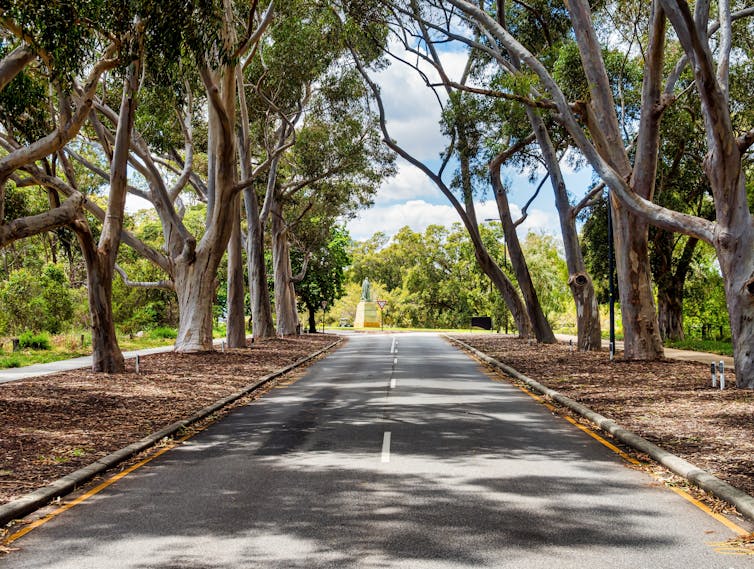
Have you noticed street trees looking oddly sad? You’re not alone. Normally, spring means fresh green leaves and flowers. But this year, the heat has come early, stressing some trees.
But there’s more going on – insects are on the march. Many eucalypts are showing signs of lerp or psyllid attack. These insects hide underneath leaves and build little waxy houses for themselves. But as they feed on the sap, they can give the leaves a stressed, pinkish look. When they appear in numbers – as they are this year – they can defoliate a whole tree with a serious infestation.
How did we get here? Milder, wetter summers during three successive La Niña years mean boomtime for insects. This year, we’ve had a warm winter and a warm spring, meaning insects are up and about early and in large numbers.
This summer will be an El Niño, which usually means drier and hotter weather for most of Australia. For those of us interested in urban trees, these conditions are troubling.
But it’s more than that. The fact our urban trees are in danger should tell us something – we need to value and protect them better. As the world heats up, our urban forests will be even more at risk.

What’s Different This Year?
In most years, insect infestations arrive later. That gives trees time to produce a flush of new growth. As a result, they’re rarely lethal. Trees can put out more leaves and recover.
But this year, they’re attacking early and in numbers. It also makes it more likely we’ll see more and more infestations over a long summer. End result: stressed trees, and even deaths from sap-sucking and other insect damage.
That’s not ideal for us either. In an El Niño summer, we’ll likely face hotter days. This year is unusually hot, due to unchecked climate change. The heatwaves to come could make us sick, hospitalise us, or even kill.
Urban trees are one of our best methods of protecting ourselves. Suburbs with greater tree canopy cover are significantly cooler. Trees shade the ground and their foliage emits water, which cools the air. Good canopy cover can cut temperatures by up to 6℃.
So, it’s not good news for us that our urban trees are looking stressed. Worse is the fact that our urban tree canopy is actually declining, due to bad urban planning of new suburbs with no space for canopy trees coupled with tree loss from subdivisions or apartment builds. Our state governments talk about this in their planning documents, but efforts to correct the problem don’t seem to be working.
What happens in hot summers with fewer trees? More air conditioner use, sending energy demand and electricity bills soaring.
We can hope this summer acts as a wake up call about the importance of healthy urban trees as we head into ever-hotter years.
What Can You Do For Your Trees?
It’s worth looking after your own trees in anticipation of the tough summer ahead.
As soils are already drying out, keep up the moisture and add quality mulch under trees to a good depth.
The longer you can keep them healthy and stress free, the more likely trees are to be able to cope with the summer stress and insect attacks.
If water restrictions are imposed in your town or city, it’s likely irrigating trees and gardens will be the first activity restricted.
If your plants have been kept stress free as long as possible, they are more likely to survive.
An irony here is that if trees are water-stressed, many species will start to defoliate by shedding leaves. That means we lose both shade and transpirational cooling when we could use them most.
Councils, state governments and water authorities face a dilemma in these situations. Save the water for human use? Or keep urban trees alive and reduce the risk of heat illness and death?
Time To Value Our Urban Trees
What this summer will show is the need for local and state governments to place greater value on their urban forests and canopy cover.
In many places, urban canopy cover is dropping by about 1-1.5% per year. Many tree removals are thoughtless and unnecessary.
Sometimes, these losses provoke outcry. Adelaide, for instance, has been losing an estimated 75,000 trees a year in recent years. That prompted a parliamentary inquiry into how to better protect urban forests.
For things to change for the better, our local governments need the ability to protect mature trees in the front and back yards of developed sites and to set out minimum areas of green space and numbers of canopy trees for new developments.
In most states, giving councils these powers would require changes to state planning laws. But without them, the urban forest and canopy cover of most major cities, regional centres and country towns will continue to decline.
With proper planning, we can have both new housing and canopy trees. If we simply aim to maximise housing, our towns and suburbs will be economically and environmentally unsustainable.
So when you see sick trees on our streets this spring, see them as a symptom. We need to value them. We would most certainly notice if they were gone. ![]()
Gregory Moore, Senior Research Associate, School of Ecosystem and Forest Sciences, The University of Melbourne
This article is republished from The Conversation under a Creative Commons license. Read the original article.
If we protect mangroves, we protect our fisheries, our towns and ourselves
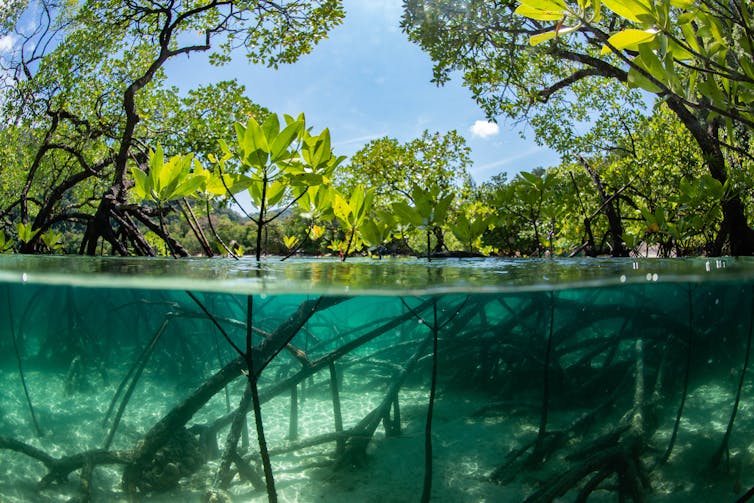
Mangroves might not look like much. Yes, they can have strange aerial roots. Yes, they’re surrounded by oozing mud.
But looks can be deceiving. These remarkable shrubs and trees are nurseries for many species of fish, shellfish and crabs. They protect our coastlines from erosion, storm surges, wind and floods. And that mud? It’s one of the best biological ways we know of to store carbon.
These ecosystem services are extremely valuable – but people often don’t notice what they offer until they’re lost to aquaculture, firewood or settlement.
Conserving mangroves by declaring parks and other protected areas seems like a logical solution. But often, nations can see protected areas as a cost, walling them off from human use, and ignoring their benefits to people.
What our new research shows is that you don’t have to choose between nature and humans. Protecting mangroves offers a win-win, given how valuable they are to coastal communities, fishers and the fight against climate change.
As nations aim to conserve 30% of their lands and waters by decade’s end, those lucky enough to have mangroves should look to their coasts.
Why Are Mangroves So Important?
Mangroves thrive on the coast, poised between land and sea. They first evolved between 100 and 65 million years ago. Each of the 65 species of mangrove is a shrub or tree which has, over time, evolved to live in salt or brackish water.
These trees are extremely resilient, surviving in low-oxygen conditions which would kill other trees. To survive, they’ve acquired adaptations such as aerial roots that can take in oxygen. These tangled roots make excellent hiding places for the creatures of land and sea, such as mudskipper fish able to survive out of water.
Their complex roots are ideal nurseries for juvenile fish, crabs and prawns by providing shelter and places to feed. In turn, these nurseries keep populations healthy, sustaining commercial fisheries and supplying direct sources of protein for coastal people.
Their robust tangles of roots protect them from the force of waves, storm surges and wind. In turn, this helps people, who can shelter behind this green wall.
Mangroves also act as a natural way to tackle climate change. Their roots trap sediment, burying inorganic and organic carbon in the process. They also store carbon in their biomass. Overall, these sea forests store carbon at almost three times the rate of tropical rainforests, twice that of peat swamps, and almost seven times the rate of seagrasses.
Protecting Mangroves Needs A Different Approach
While mangroves give us a host of benefits, many of these only become apparent when these ecosystems are gone.
Unfortunately, mangroves are often cleared to make way for aquaculture, farming and human settlements, or for firewood. An estimated 20–35% of the world’s mangroves have been lost since 1980. In better news, losses have declined significantly. We now lose around 0.13% per year.
Protected areas work well as a way to cut mangrove losses. When a government sets out to create these areas, the aim is usually to protect biodiversity while minimising conflict with human use.
In our research, we found the world’s network of protected areas isn’t doing a great job in protecting either mangrove biodiversity or the ecosystem benefits mangroves give us. In fact, it’s no better than just picking areas at random.
That means high-priority mangrove forests important for both biodiversity and ecosystem services are not being properly conserved. Clever expansion of the current network could solve the problem. At present, parks and other protected areas cover about 13% of the world’s mangrove forests, which are clustered around the tropics.
Boosting this to 30% – in line with the biodiversity conservation target agreed to by 196 nations last year – would reap benefits. Our research suggests it would safeguard houses and infrastructure worth A$25.6 billion, protect six million people against coastal flooding, and store over one billion extra tonnes of carbon. Also, fishers would gain an extra 50 million days of successful fishing a year.
Even better – we found optimising conservation of both biodiversity and ecosystem services needed only 3–9% more area protected compared to mangrove protection areas based on saving species alone.
Protect Mangroves In Asia And Oceania
Mangrove forests urgently needing protection are almost all in Asia (63% of the total) and Oceania (17%), where we find large biodiverse mangrove forests which support fishing industries and many coastal communities.
Indonesia is a particular hotspot, given its 17,000-odd islands are often ringed by mangroves. Mangroves in India, Vietnam and Papua New Guinea also need better protection.
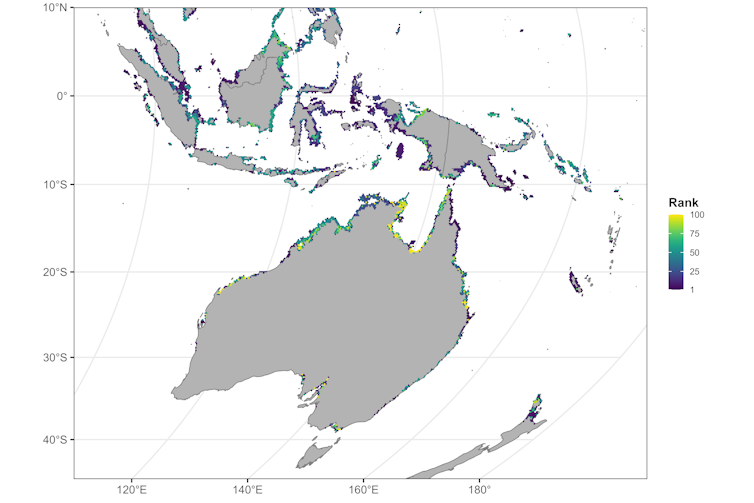
Australia does reasonably well. Around 18% of our mangroves are protected, above the global average of 13.5%. Over 20% of the areas we have flagged are high-priority for mangrove conservation are already protected. Even so, expanding the protected area network would be a good move, as Australian mangroves are some of the world’s most biodiverse and carbon-rich.
Mangroves in parts of northern Queensland need better protection. Some mangroves are already protected by the Great Barrier Reef Marine Reserve, but there are still large unprotected tracts.
Mangroves around Darwin and Arnhem Land in the Northern Territory need expanded protected areas, as do those on the coast between the Pilbara and the Kimberley in Western Australia.
Too often, protecting nature is seen as a cost to society. What our modelling shows is that we can have a win-win. By protecting the most precious areas of mangrove, we can protect human communities and wider biodiversity at a stroke.![]()
Alvise Dabalà, Research associate, The University of Queensland; Anthony Richardson, Professor, The University of Queensland; Daniel Dunn, A/Prof of Marine Conservation Science & Director of the Centre for Biodiversity and Conservation Science (CBCS), The University of Queensland, and Jason Everett, Senior research fellow, The University of Queensland
This article is republished from The Conversation under a Creative Commons license. Read the original article.
A successful energy transition depends on managing when people use power. So how do we make demand more flexible?
Chris Briggs, University of Technology SydneyEnergy security concerns are mounting as renewable projects and transmission lines are delayed.
In New South Wales, for instance, the government has flagged it may defer the closure of Eraring coal power station beyond 2025.
NSW has other new policies to “get the energy transition back on track”. These include expanding “customer energy resources”, such as solar panels and batteries, and increasing “demand flexibility” (broadly, using smart technology to shift the times when businesses and homes use power).
With more variable supply from solar and wind energy, demand flexibility is a cheaper and cleaner way to keep the electricity grid stable.
Modelling for the Australian Renewable Energy Agency (ARENA) shows this approach could save consumers up to A$18 billion to 2040. Shifting demand can avoid:
- higher-priced power use at the end of the day
- building new poles and wires to increase network capacity to meet peak demand
- paying coal plants to stay open.
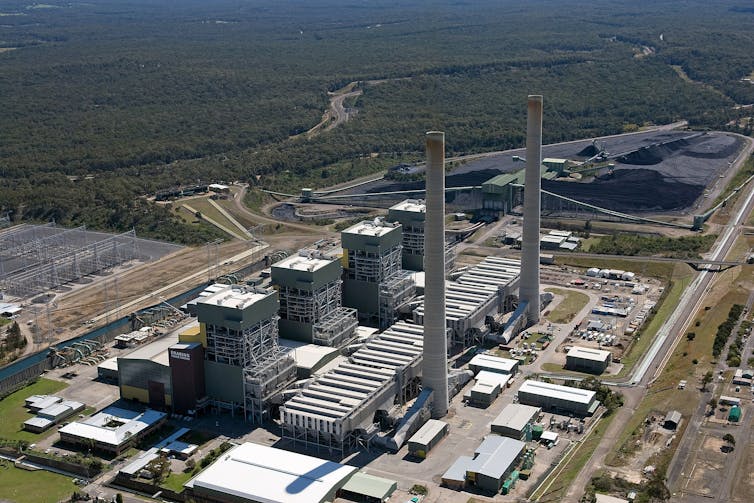
What Does Flexible Demand Involve?
Examples of flexible demand include:
shifting water heating from night-time (mostly coal-powered) to daytime (using solar)
reducing temperatures in commercial coolrooms using solar power in the middle of the day, then switching chillers off in the late afternoon until they return to standard refrigeration temperatures
remotely controlling air conditioners to turn them down when the grid is under stress. Households get paid and don’t notice if the aircon is briefly turned down, but across many homes it can make a big difference.
The Australian Energy Market Operator (AEMO) estimates NSW needs an extra 191 megawatts (MW) of capacity to maintain reliability when Eraring closes.
Another way to cover that capacity shortfall is more flexible demand. Queensland already has almost 150MW of remote-controlled air conditioning. Other types of demand management that Queensland grid operators can call on total about 900MW.
In Western Australia, a newly signed contract will provide 120MW of demand flexibility.

So What Are The Obstacles To More Flexible Demand?
ARENA commissioned the Institute for Sustainable Futures to review the pilot demand flexibility projects it has funded. Many didn’t deliver as much as hoped.
Sometimes, this was because businesses were too busy with day-to-day operations or payments for households were too low to catch their interest. But often it’s a matter of putting policies, technical standards and regulations in place to make demand management seamless and efficient.
ARENA has spent about $180 million on 55 projects with at least some focus on flexible demand. They include air conditioning, pool pumps and hot water systems in homes, commercial building air conditioning and electric vehicle charging.
4 Ways To Increase Demand Flexibility
What do these projects tell us about how to increase demand flexibility?
1. Better technical standards
The technical standards required of manufacturers often don’t ensure devices can be used to shape demand. Many air-conditioners couldn’t be controlled in ARENA pilots.
There is also no technical standard for “inter-operability” of devices within homes. Batteries, hot water systems and other devices with different companies’ technologies don’t always work well together.
Vehicle-to-grid charging for electric vehicles will be the largest opportunity for demand flexibility, but there is no common technical standard. It’s vital to have one before the mass uptake of electric vehicles.
Outside Victoria, smart meters that provide real-time information on home energy use are rare. The Australian Energy Market Commission has recommended governments accelerate roll-out of smart meters to 100% by 2030.

2. Simpler measurement systems
The measurement systems to calculate payments for demand flexibility are a barrier to expansion. It’s tricky as you need to measure how much electricity was used relative to what would otherwise have occurred.
ARENA pilots that tried to precisely measure residential demand flexibility found it was financially unviable at the smaller scale.
The system used for AEMO’s Wholesale Demand Response Mechanism (WDRM) effectively limits participation to businesses with predictable, flat consumption profiles. This excludes as much as 80–90% of sites. International measurement models could be trialled here to open up participation.
3. More certainty about payments
Earnings from providing demand flexibility depend on weather, market prices and so on. This uncertainty makes it hard to get businesses to sign up.
Overseas, some energy markets guarantee payment for making demand flexibility available. These have the highest participation.
The federal government is consulting on a capacity investment scheme. Because it will have the same measurement system as the current mechanism, participation is likely to be limited.
4. Fresh policy approaches
Businesses that sign up under the Wholesale Demand Response Mechanism make bids in the National Electricity Market to be paid for reducing their power use when demand and prices are high. This should reduce prices for all consumers and improve energy security when the grid is under stress. However, it has attracted only one participant – mainly due to the complex measurement system – and isn’t open to households.
Another incentive scheme for electricity networks to invest in demand management is chronically under-used.
There are simpler alternatives that have worked before. The national Renewable Energy Target and state energy efficiency certificate schemes fund rooftop solar or energy retrofits based on average output or energy savings from past experience. These simple calculations offer a relatively stable incentive, which could work for demand flexibility.
NSW’s Peak Demand Reduction Scheme, launched last year, could provide a model for using certificate schemes to boost demand flexibility.
Get Serious About Demand Flexibility
The focus of NSW’s development of a customer energy resources policy appears to be on “virtual power plants”. These co-ordinate household solar and battery systems to store solar power and export to the grid when it’s most needed.
Batteries are part of the solution, but cheaper options exist. An electric water heater with a 300-litre tank can store as much energy as a second-generation Tesla battery at much less cost.
Modelling for ARENA finds hot water systems could store as much energy as more than 2 million household batteries. Retrofitting these systems will spread savings more widely to include low-income households as well as those that can afford a battery.
It’s time we got serious about developing a holistic demand flexibility strategy. It will be cheaper and cleaner than paying coal plants to stay open.![]()
Chris Briggs, Research Director, Institute for Sustainable Futures, University of Technology Sydney
This article is republished from The Conversation under a Creative Commons license. Read the original article.
There’s a hidden source of excess nutrients suffocating the Great Barrier Reef. We found it
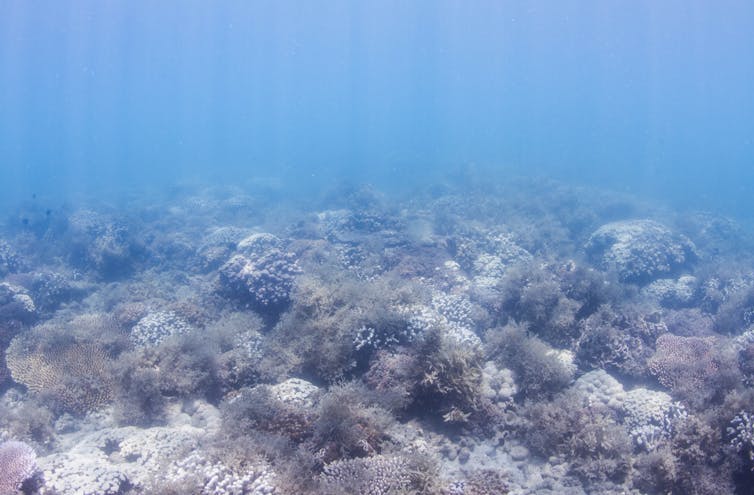
The Great Barrier Reef is one of Australia’s most important environmental and economic assets. It is estimated to contribute A$56 billion per year and supports about 64,000 full-time jobs, according to the Great Barrier Reef Foundation. However, the reef is under increasing pressure.
While much public attention is focused on the impacts of climate change on the Great Barrier Reef and the debate around its endangered status, water quality is also crucial to the reef’s health and survival.
Our new study, published today in the journal Environmental Science and Technology, found that previously unquantified groundwater inputs are the largest source of new nutrients to the reef. This finding could potentially change how the Great Barrier Reef is managed.
Too Much Of A Good Thing
Although nitrogen and phosphorous are essential to support the incredible biodiversity of the reef, too much nutrient can lead to losses of coral biodiversity and coverage. It also increases the abundance of algae and the ability of coral larvae to grow into adult coral, and impacts seagrass coverage and health, which is crucial for fisheries and biodiversity.
Nutrient enrichment can also promote the breeding success of crown-of-thorns starfish, whose increasing populations and voracious appetite for corals have decimated parts of the reef in recent decades.
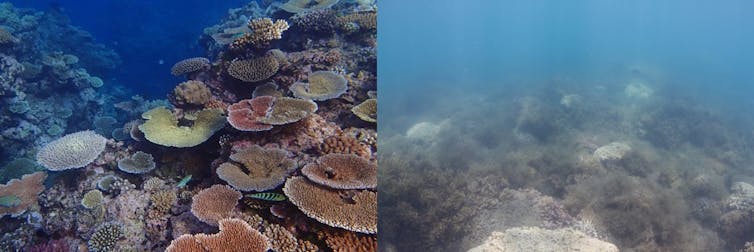
What are the sources of nutrients driving the degradation of the reef? Previous studies have focused on river discharge. According to one estimate, there has been a fourfold increase in riverine nutrient input to the Great Barrier Reef since pre-industrial times.
This past focus on rivers has emphasised reducing surface water nutrient inputs through changing regulations for land-clearing and agriculture, while neglecting other potential sources.
However, the most recent nutrient budget for the Great Barrier Reef found river-derived nutrient inputs can account for only a small proportion of the nutrients necessary to support the abundant life in the reef. This imbalance suggests large, unidentified sources of nutrients to the reef. Not knowing what these are may lead to ineffective management approaches.
With recent government funding of more than $200 million to tackle water quality on the reef which is largely focused on managing river water inputs, it is crucial to make sure other nutrient sources are not overlooked.
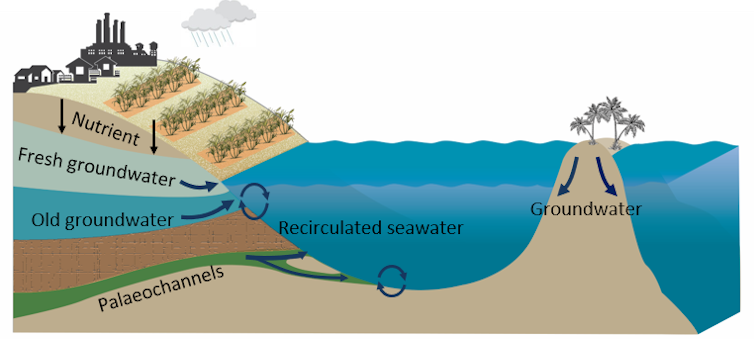
We Found A New Nutrient Source
Our research team decided to try and track down this missing source of nutrients.
We used natural tracers to track groundwater inputs off Queensland’s coast. This allows us to quantify how much invisible groundwater flows into the Great Barrier Reef, along with the nutrients hitching a ride with this water. Our findings indicate that current efforts to preserve and restore the health of the reef may require a new perspective.
Our team collected data from offshore surveys, rivers and coastal bores along the coastline from south of Rockhampton to north of Cairns. We used the natural groundwater tracer radium to track how much nutrient is transported from the land and shelf sediments via invisible groundwater flows.

We found that groundwater discharge was 10–15 times greater than river inputs. This meant roughly one-third of new nitrogen and two-thirds of phosphorous inputs came via groundwater discharge. This was nearly twice the amount of nutrient delivered by river waters.
Past investigations have revealed that groundwater discharge delivers nutrients and affects water quality in a diverse range of coastal environments, including estuaries, coral reefs, coastal embayments and lagoons, intertidal wetlands such as mangroves and saltmarshes, the continental shelf and even the global ocean.
In some cases, this can account for 90% of the nutrient inputs to coastal areas, which has major implications for global biologic production.
Nevertheless, this pathway remains overlooked in most coastal nutrient budgets and water quality models.
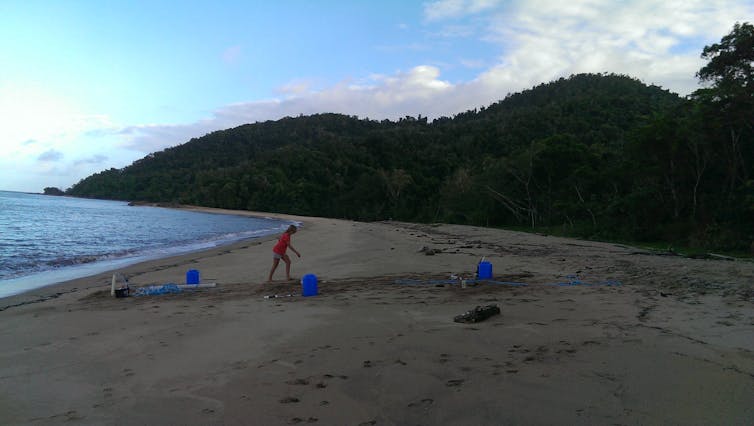
A Paradigm Shift Needed?
Our results suggest the need for a strategic shift in management approaches aimed at safeguarding the Great Barrier Reef from the effects of excess nutrients.
This includes better land management practices to ensure fewer nutrients are entering groundwater aquifers. We can also use ecological (such as seaweed and bivalve aquaculture, enhancing seagrass, oyster reefs, mangroves and salt marsh) and hydrological (increasing flushing where possible) practices at groundwater discharge hotspots to reduce excess nutrients in the water column.
The reuse of nutrient-rich groundwater for agriculture also needs to be explored as it represents an untapped and inexpensive nutrient source.
Importantly, unlike river outflow, nutrients in groundwater can be stored underground for decades before being discharged into coastal waters. This means research and strategies to protect the reef need to be long-term. The potential large lag time may lead to significant problems in the coming decades as the nutrients now stored in underground aquifers make their way to coastal waters regardless of changes to current land use practices.
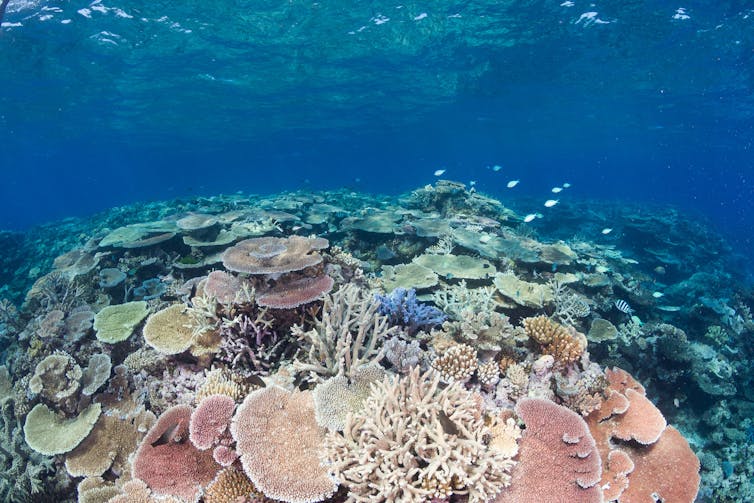
The understanding and ability to manage the sources of nutrients is pivotal in preserving global coral reef systems.
While we need to reduce the impact of climate change on this fragile ecosystem, we also need to adjust our policies to manage nutrient inputs and safeguard the Great Barrier Reef for generations to come.![]()
Douglas Tait, Senior Researcher, Southern Cross University and Damien Maher, Professor, Southern Cross University
This article is republished from The Conversation under a Creative Commons license. Read the original article.
The Nullarbor’s rich cultural history, vast cave systems and unique animals all deserve better protection
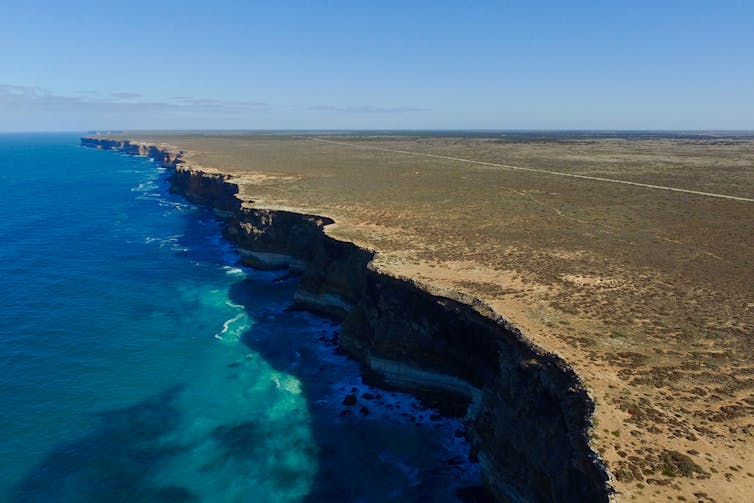
The Nullarbor is one of Australia’s iconic natural places. It’s renowned as a vast and mostly treeless plain. But hidden beneath this ancient landscape is an immense network of caves.
These caves are part of the world’s largest contiguous limestone karst system. This karst landscape, created by water dissolving the limestone, spans some 200,000 square kilometres.
The caves are as important for their geological value and what they can teach us about Australia’s past, as they are for the unique animals they house, the fossils they hold and their beautiful and unusual cave decorations.
The Nullarbor Plain is the land of the Mirning people. Their Dreaming, associated with the Great Australian Bight, recalls oral histories of changing sea levels.
The Mirning have actively traversed the plain for millennia. Their artwork in its caves, extensive flint mining and artefacts scattered over its surface provide evidence of their presence.
But it’s only in modern times that the plain’s natural values have been threatened. The threats include invasive species, such as foxes, cats, camels and buffel grass, climate change and, perhaps most detrimentally, human activities. Mining, wildlife poaching, uncontrolled tourism and large-scale development, for example a proposed green energy project, could impact much of what makes the Nullarbor Plain so precious.
Greater recognition of the Nullarbor’s superlative natural features is needed to change a common perception that there is nothing out there, and to ensure the preservation of unprotected areas in the region.
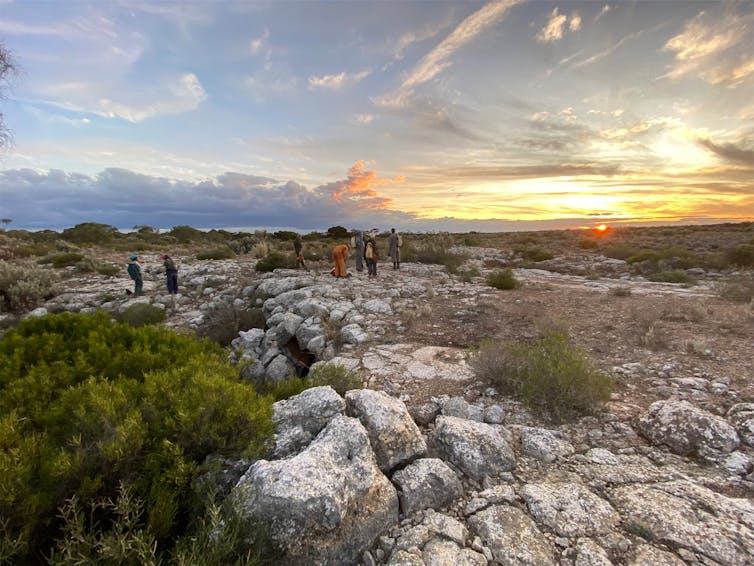
A Place Of Spectacular Cliffs And Caves
Sloping gently seawards, the Nullarbor terminates spectacularly at the Great Southern Scarp, possibly the world’s longest cliff line.
The caves scattered across the plain vary from small caves to those that extend for many kilometres.
The smaller caves include blowholes, narrow smooth-walled vertical tubes named for the breathing in and out of air as atmospheric pressure changes. Sometimes the air movement feels like a gale.
Some of the deep caves contain lakes of clear, salty, blue-green water. Flooded passages lead away from these lakes. Only cave divers can reach these passages, which include the longest underwater cave systems in Australia.
Dating of stalactites and stalagmites confirms most of the caves were formed in the Early Pliocene, around 5 million to 3 million years ago. At this time, the region was much wetter and home to forests of eucalypts. It was very different from the sparse plain we see now.
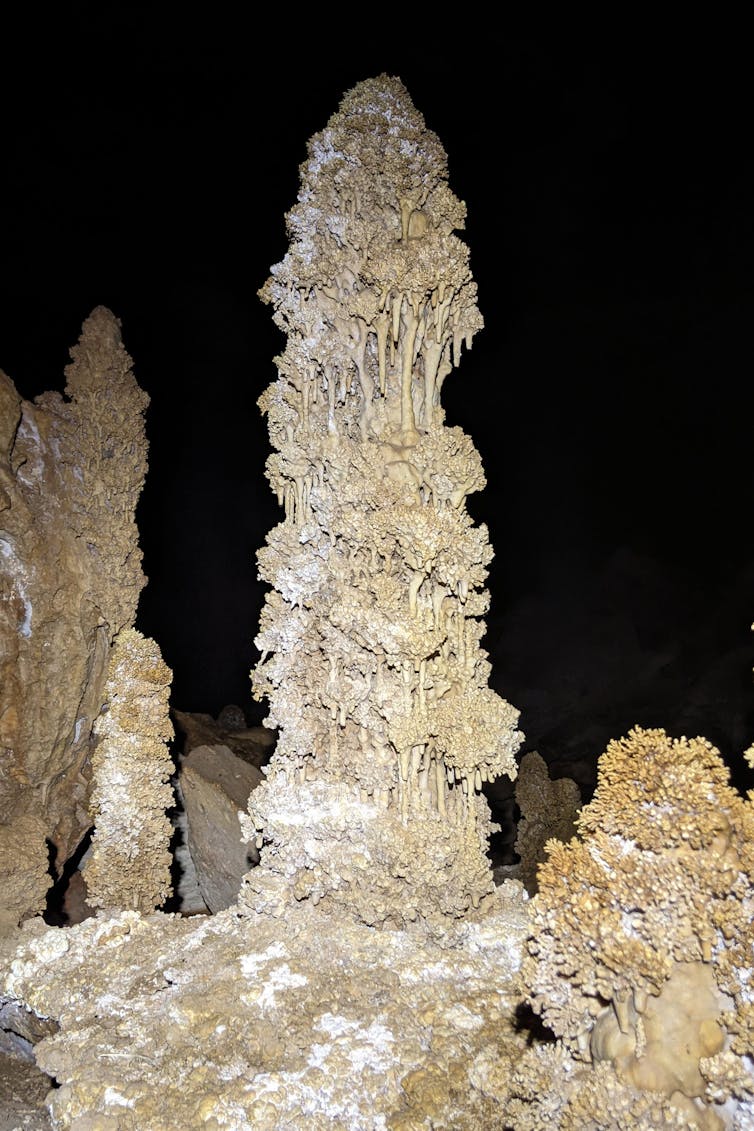
Home To Unique And Vulnerable Life
With low light levels and relatively stable temperatures and humidities, caves are extreme environments.
In remote sections of some caves fragile curtains of bacterial colonies known as slime curtains hang from the roof and walls. These are unique to the Nullarbor.
Many animals found in caves can survive above ground. But some, known as troglobites, have become so specialised they can only survive underground. They often lack pigment, have elongated limbs and highly reduced or absent eyes.
One such group of cave specialists are the blind cave spiders of the genus Troglodiplura. These large, enigmatic spiders occur only on the Nullarbor Plain. And most species are known from single caves.
They are the only cave-adapted mygalomorph spiders (the primitive spiders, such as the funnel-web and trapdoor spiders) known from Australia. As with many cave-dwelling animals, we know very little about them.
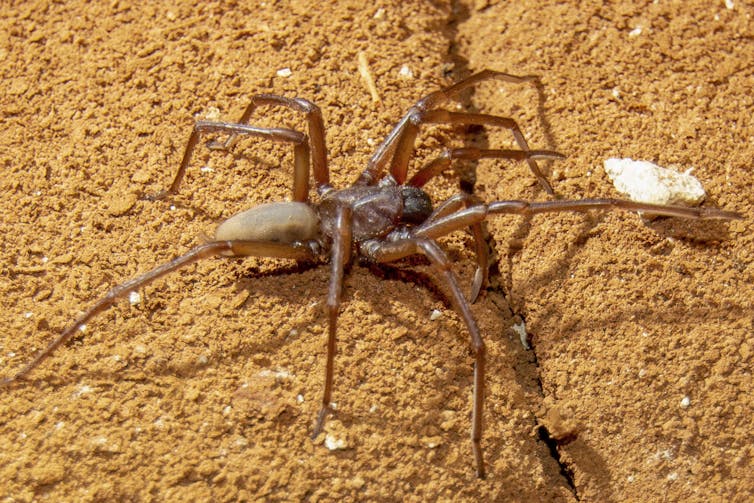
The highly specialised and diverse animals that live in underground water, known as stygofauna, are a good example of this. Only a very small fraction of the species have been scientifically described.
Many such animals are restricted to tiny geographic areas. Some occur only in a single cave.
This means these species are at exceptionally high risk from threats to them or the fragile cave environment they rely on. These threats include predation by foxes, changes to water availability within the cave, or damage to the cave structure.
Given how little we know about cave fauna, it’s unfortunately likely extinctions are occurring unrecorded and undocumented.
Nature’s Time Capsules
Not only do the caves give us a tantalising glimpse into life underground, they also preserve fossils of animals that were once abundant on the surface. Scattered across the floors of some caves are thousands of bones from animals that fell prey to roosting owls or were trapped after falling in.
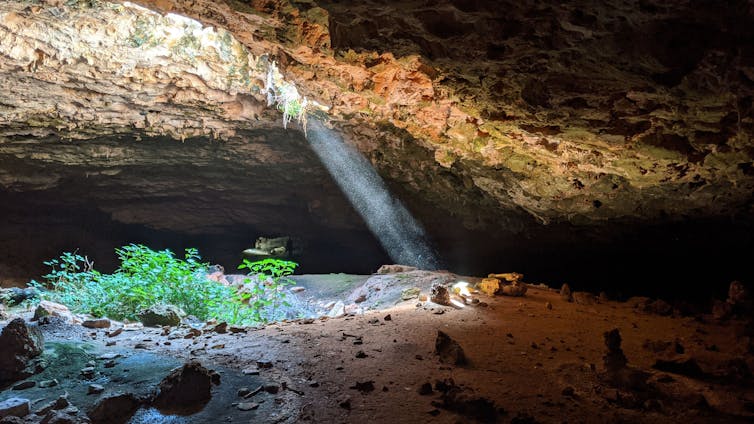
These “sub-fossil” deposits are geologically young. As a result, they give us insights into the scale of biodiversity loss that followed European colonisation of Australia.
A tragic example of recent extinctions is the Nullarbor barred bandicoot. The species died out a century ago as feral predators spread across the region.
There are also much older fossils that reveal an extraordinary aspect of the Nullarbor’s distant past.
In 2002, cave explorers found large deposits of fossil bones in the “Thylacoleo caves”. Among these was a near-complete skeleton of Australia’s largest extinct marsupial predator, Thylacoleo carnifex. Hundreds of thousands of years old, these fossils also revealed previously undescribed species of giant cuckoos , megapodes and tree kangaroos.
Looking at the dry, treeless landscape today it is hard to believe tree kangaroos once called the Nullarbor home. Analysis of speleothems (mineral deposits formed from dripwater) shows why they were found there. The region’s climate was wetter during the Pliocene, paving the way for diversification of forest-dwelling vertebrates.
A Delicate Balance
The geology, palaeontology, cultural history and biology of the Nullarbor caves reveal a wealth of distinctive features, but the Nullarbor is much more than the sum of its parts.
Karst landscapes are integrated systems, with the surface, caves and deep aquifer intrinsically linked. An impact on any one aspect affects all others.

Any changes to the land surface, through road building and large-scale development will alter forever the character of this globally significant and iconic landscape. In the era of human-driven climate change, we do need to find alternative energy sources and materials to reduce our impact, but not at the expense of our epic landscapes and biodiversity.![]()
Jess Marsh, Research Fellow, Harry Butler Institute, Murdoch University; Clare Buswell, Adjunct Lecturer, History, Archaeology, Indigenous Studies and Geography, Flinders University; Liz Reed, Senior Lecturer, School of Biological Sciences, University of Adelaide, and Susan White, Adjunct Research Fellow, Environment, La Trobe University
This article is republished from The Conversation under a Creative Commons license. Read the original article.
How drone submarines are turning the seabed into a future battlefield

A 12-tonne fishing boat weighs anchor three kilometres off the port of Adelaide. A small crew huddles over a miniature submarine, activates the controls, primes the explosives, and releases it into the water. The underwater drone uses sensors and sonar to navigate towards its pre-programmed target: the single, narrow port channel responsible for the state’s core fuel supply …
You can guess the rest. A blockage, an accident, an explosion – any could be catastrophic for Australia, a country that conducts 99% of trade by sea and imports more than 90% of its fuel.
As drone submarines or “uncrewed underwater vehicles” (UUVs) become cheaper, more common and more sophisticated, Australia’s 34,000km of coastline will face a significant future threat.
What can be done? Our assessment – validated through workshops with experts from across Australia – shows the same technologies can aid our maritime security, if we build them into our planning from now on.
Seabed Warfare
Australia is not alone in its rising concern for submarine security. In 2022, France launched its Seabed Warfare Strategy to address autonomous underwater maritime threats. In February 2023, NATO established an Undersea Infrastructure Coordination Cell in response to the sabotage of the Nord Stream gas line in September 2022.
The war in Ukraine has seen relatively small, cheap aerial drones play an outsized role. At a smaller scale, underwater drones have also enabled Ukraine to conduct asymmetric attacks on Russian forces.
Current drones can be used in intelligence, surveillance, reconnaissance, mine countermeasures, antisubmarine warfare, electronic warfare, underwater sensor grid development and special operations, among other things.
However, their capabilities are likely to expand. China’s Haidou-1 project dived to a record depth of 10,908 metres.
A Chinese underwater glider, the Haiyan, holds the drone sub endurance record with a 3,600km voyage over 141 days across the South China Sea. Russia boasts of having a prototype nuclear-powered, nuclear-armed undersea drone, although some analysts doubt it really exists.
Nations are also developing broader programs to control underwater sea domains.
For instance, the United States’ proposed Advanced Undersea Warfare System envisions a network of fixed submarine stations able to deploy defensive and offensive drones. In the South China Sea, China is developing an “Underwater Great Wall” of ships, bases and drone (both at surface level and beneath) to monitor the area and make it difficult for foreign navies to operate in international waters.
A New Age Of War At Sea?
Some analysts argue these developments amount to the dawn of a “new age of naval warfare”. Others suggest autonomous maritime systems, as they grow cheaper and more effective, may become preferred over crewed vehicles for national defence: by one estimate, uncrewed vessels may make up more than half of the US naval fleet by 2052.
The advent of sea drones may also encourage the further growth of hybrid or “grey zone” approaches to conflict, which avoid outright warfare, keep casualties low, and can inflict heavy costs on enemies. In this context, uncrewed marine vessels may offer states a deniable way to carry out aggressive actions to advance their aims without crossing the threshold of war.
Put differently, drone submarines may lend themselves to creating apparent accidents and other actions that can’t be pinned on their instigators. It is worth quoting the French Seabed Warfare Strategy on this point:
an attack on the underwater part of submarine cables is a potential cause of action, with possibilities ranging from a “convenient” accident in a coastal area, to deliberate military action. In this regard, the intrinsic features of the seabed make it the ideal theatre for non-attributable actions in “grey zones”.
The Road Ahead For Australia
Our new research examined the threat to Australia’s trade posed by autonomous, uncrewed underwater vehicles.
With colleagues at the RMIT Centre for Cyber Security Research and Innovation, Charles Darwin University, and WiseLaw, we ran workshops with people from government, the Royal Australian Navy, Defence, industry and academia. We found a growing tension between efforts to protect ocean-borne trade and critical undersea infrastructure today, and more forward-looking strategies aimed at developing the next generation of maritime defence.
Under the AUKUS security pact, Australia has engaged the United Kingdom and the US to buy and build nuclear-powered submarines, and seeks to acquire and develop new systems “with additional undersea capabilities”. This is a good start, but the scale of the purchases has raised concerns they will become all-consuming for Australia’s military.
Australia also engages in exercises such as Autonomous Warrior to test new and emerging systems in maritime defence. However, these exercises under-examine threats to maritime trade that underwater drones are likely to produce in the future.
One result that emerged from our workshops is that mines are seen as an emerging challenge. Loitering drones with explosives – which could even be commercially available vessels carrying improvised explosives – could hold up commercial ports and traffic, bottle up naval assets, or disrupt maritime shipping routes. This would cause delays, loss of revenue, and increased insurance premiums.
As “set and forget” weapons, mines have an outsized impact as they can cause great damage for a low cost. And they are difficult and costly to find and neutralise.
For the time being, Australia is largely protected from the threat of underwater drones by distance. Current battery and communication technology mean drones would need to be deployed from relatively nearby, and Australia’s maritime environments would make operation difficult.
However, the technology is advancing quickly. The time available for the Australian Department of Defence to address the threat of underwater uncrewed vehicles is shrinking.
This article draws upon research funded under the Strategic Policy Grants Program run by the Department of Defence. The Strategic Policy Grants Program is an open and competitive mechanism for Defence to support independent research, events and activities. The views expressed herein are those of the authors and are not necessarily those of the Australian Government or Defence.![]()
Adam Bartley, Postdoctoral Fellow, RMIT Centre for Cyber Security Research and Innovation, RMIT University and Matthew Warren, Director, RMIT University Centre for Cyber Security Research and Innovation, RMIT University
This article is republished from The Conversation under a Creative Commons license. Read the original article.
Glacial lake outburst floods in Alaska and the Himalayas show evolving hazards in a warming world
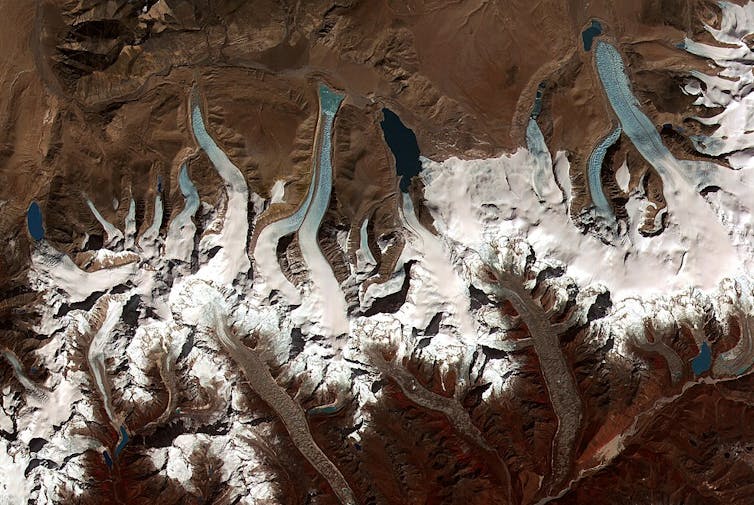
In August 2023, residents of Juneau, Alaska, watched as the Mendenhall River swelled to historic levels in a matter of hours. The rushing water undercut the riverbank and swallowed whole stands of trees and multiple buildings.
The source for the flood was not heavy rainfall – it was a small glacial lake located in a side valley next to the Mendenhall Glacier.
Glacier-dammed lakes like this are abundant in Alaska. They form when a side valley loses its ice faster than the main valley, leaving an ice-free basin that can fill with water. These lakes may remain stable for years, but often they reach a tipping point, when high water pressure opens a channel underneath the glacier.
The rapid and catastrophic drainage of lake water that follows is called a glacial lake outburst flood, or GLOF for short. The flood waters race downstream over hours or days and often hit unexpectedly.
Glacial lake outburst floods have destroyed homes, infrastructure and human life around the world. They have killed hundreds of people in Europe and thousands of people in both South America and central Asia. Globally, an estimated 15 million people live downstream from these lakes, with those in Asia’s high mountains at greatest risk.
Flooding from a glacial lake in the Himalayas on Oct. 5, 2023, left dozens of people dead in India as water swept away bridges, damaged a hydropower station and flooded small towns. Satellite images showed that the lake level dropped markedly within hours.
I study Alaska’s glacial lakes and the hazards that glacier-dammed lakes in particular can create. Our latest research shows how these lakes are changing as global temperatures rise.
When Glaciers Hold Back Lakes
Some glacial lakes are dammed by moraines – mounds of rock and debris that are left behind as a glacier retreats. Too much pressure from extreme rainfall or an avalanche or landslide into the lake can burst these dams, triggering a devastating flood. Officials say that’s likely what happened when the Himalayas’ Lhonak Lake flooded towns in India in October 2023.
Glacier-dammed lakes, like Suicide Basin off of Mendenhall Glacier, are instead dammed by the glacier itself.
These glacial lakes tend to repeatedly fill and drain due to a cyclic opening and closing of a drainage path under the ice. The fill-and-drain cycles can create hazards every couple of years or multiple times a year.
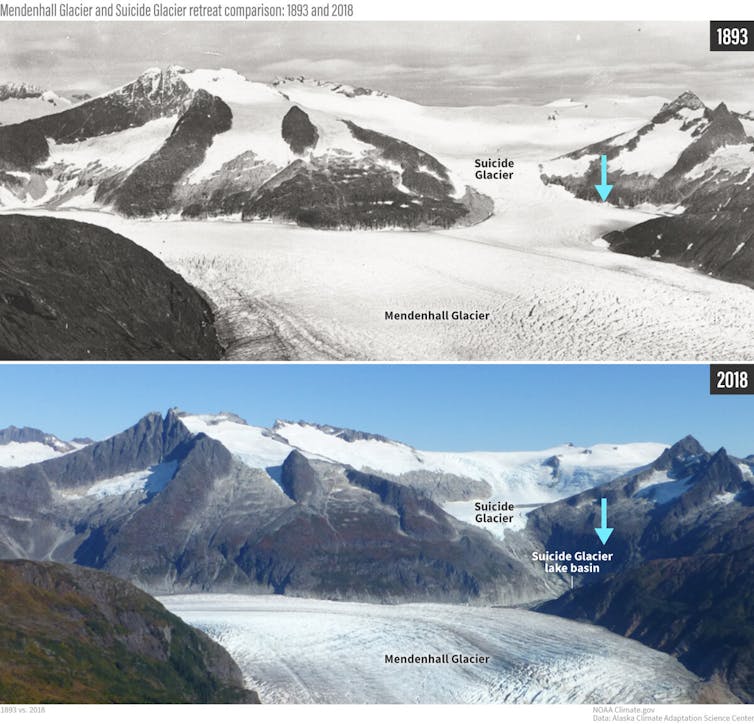
How Glacier Lake Hazards Are Changing In Alaska
In a new study, we identified 120 glacier-dammed lakes in Alaska, 106 of which have drained at least once since 1985.
These lakes have collectively drained 1,150 times over 35 years. That is an average of 33 events every year where a lake drains its contents, sending a pulse of water downstream and creating potentially hazardous conditions.
Many of these lakes are in remote locations and often go undetected, while others are much closer to communities, such as Suicide Basin, which is within 5 miles of the state capital and has frequently drained over the past decade.
Our study found that, as a whole, glacier-dammed lakes in Alaska have decreased in volume since 1985, while the frequency of outbursts remains unchanged. This suggests a regional decline in the potential hazards from glacier-dammed lakes because less stored water is available, a trend that has been documented for glacier-dammed lakes worldwide.
To better understand this trend, imagine a bathtub. The higher the sides of the tub, the more water it can hold. For a glacier-dammed lake, the glacier acts as a side of the bathtub. Warming air temperatures are causing glaciers to melt and thin, lowering the tub walls and therefore accommodating less water. That reduces the total volume of water available for a potential glacial lake outburst flood.
Smaller lakes, however, have had less significant change in area over time. As the August 2023 event clearly illustrated, even small lakes can have significant effects downstream.
Alaskans witnessed a new record of destruction in Juneau from the flood. The water reached nearly 15 feet at the Mendenhall River gauge – 3 feet above its previous record.
In summer 2023 alone, Alaskans saw record or near-record flooding from multiple glacier-dammed lakes near populated areas or infrastructure, such as Suicide Basin, near Juneau; Skilak Glacier-Dammed Lake, which affects the Kenai River; and Snow Lake, which impacts the Snow River. These lakes have remained about the same volume but have produced some larger floods in recent years.
One possible explanation is that with a thinner and weaker ice dam, the water can drain much more quickly, though further research is needed to understand the mechanics. Regardless, it’s a reminder that these lakes and events are unpredictable.
How Will Rising Temperatures Affect These Lakes?
Glacier loss in Alaska is accelerating as temperatures rise. Due to the large volume of glaciers and the many intersecting valleys filled with ice in Alaska, there is a high probability that new lakes will develop as side valleys deglaciate, introducing new potential hazards.
Many of these lakes are likely to develop in remote locations, and their presence may only be noticed in satellite images that reveal changes over time.
Given the abundance of glacial lakes and their potential threat to human lives, early warning and monitoring systems are worryingly sparse. Efforts are underway, such as those in the Himalayas and Chile, but further research is needed to develop reliable, low-cost monitoring systems and to improve our understanding of these evolving hazards.![]()
Brianna Rick, Postdoctoral Fellow, Alaska Climate Adaptation Science Center, University of Alaska Anchorage
This article is republished from The Conversation under a Creative Commons license. Read the original article.
What is seawater intrusion? A hydrogeologist explains the shifting balance between fresh and salt water at the coast
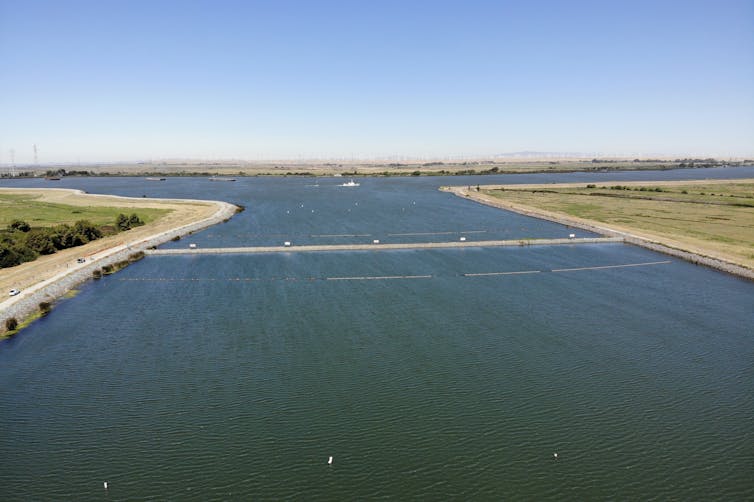
Seawater intrusion is the movement of saline water from the ocean or estuaries into freshwater systems. The seawater that has crept up the Mississippi River in the summer and early fall of 2023 is a reminder that coastal communities teeter in a fragile land-sea balance.
Fresh water is essential for drinking, irrigation and healthy ecosystems. When seawater moves inland, the salt it contains can wreak havoc on farmlands, ecosystems, lives and livelihoods.
I am a coastal hydrogeologist and have studied water across the land-sea interface for 25 years. I think of seawater intrusion as being like a seesaw: The place where fresh water and salt water meet is the balance point between forces from land and forces from the sea.
A push from the land side, such as heavy rainfall or high river flows, moves the balance point seaward. A push from the sea side – whether it’s sea-level rise, storm surge or high tides – moves the balance point landward. Droughts or heavy use of fresh water can also cause seawater to move inland. As climate change and population growth stress freshwater supplies, one result will be more seawater intrusion.
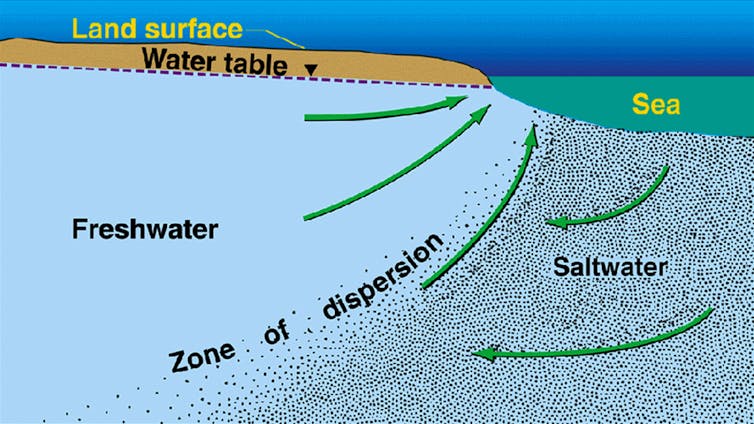
When The Ocean Moves Upriver
The current seawater intrusion in the lower Mississippi River is due primarily to drought in the Midwest, which has reduced the river’s volume. Both the magnitude of reduction in river flow and the length of time that the river is low influence how far upriver the salt water moves. As of Oct. 2, 2023, the saltwater “wedge” in the Mississippi had moved nearly 70 miles upstream from the river’s mouth.
This isn’t the first time that low water on the river has allowed seawater to move inland. But as climate change raises sea levels and causes more severe weather anomalies, intrusion will become more common and will inch farther upstream.
And the problem isn’t unique to the Mississippi. In Delaware, seawater is traveling farther up small tidal streams during storms and the highest tides, flooding farmland and killing crops.
In the Sundarbans of India and Bangladesh – one of the largest coastal mangrove forests in the world – seawater is intruding into the mouth of the Ganges River. The main causes there are upstream dams and water diversions from the river for irrigation and navigability, plus encroachment due to sea-level rise. Seawater intrusion could threaten many types of plants and animals in this UNESCO World Heritage Site, which is home to countless rare and endangered species.
Invading Underground
Another interface between fresh water and salt water at the coast is less obvious because it’s underground. Many coastal communities draw their freshwater supply from groundwater – clean water that moves through pore spaces between grains of sand and soil.
Groundwater doesn’t just stop at the coastline: Under the ocean floor, the groundwater is salty, and somewhere between land and the ocean, there is an underground meeting point. It typically is landward of the coastline because salt water is denser than fresh water, so it has a greater force and naturally pushes in. But just as with a river, that interface moves when groundwater levels drop on land or water levels rise offshore.
In groundwater basins of central and southern California, widespread pumping has caused groundwater levels to drop hundreds of feet in some areas. This is tipping the seesaw and causing groundwater from the sea to move far inland. Accessible groundwater has supported irrigated agriculture in these areas, but now the double hazard of reduced groundwater availability and seawater intrusion threatens crops like strawberries and lettuce.
Seawater intrusion into groundwater is happening all over the world, but perhaps the most threatened places are communities on low-lying islands. Fresh groundwater is often the sole source of water for drinking and irrigation on small islands, and it exists in a thin lens that floats on top of saline groundwater.
The lens can shrink in response to droughts, pumping and sea-level rise. It can also become salty from floodwater infiltration during storms or high tides.
In the Marshall Islands, for example, a combination of sea-level rise and wave-driven flooding is predicted to make many islands uninhabitable by the end of the century.
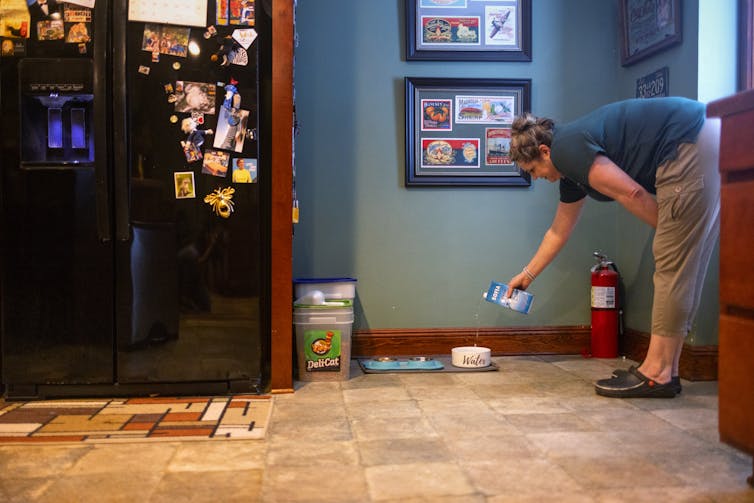
Shifting The Balance
As salt water continues to encroach on freshwater systems, there will be consequences. Drinking water that contains even 2% seawater can increase blood pressure and stress kidneys. If salt water gets into supply lines, it can corrode pipes and produce toxic disinfection by-products in water treatment plants.
Seawater intrusion reduces the life span of roads, bridges and other infrastructure. It has been implicated as a contributor to the Champlain Towers South condominium collapse in Surfside, Florida, in 2021. Seawater intrusion changes ecosystems, creating ghost forests as trees die and marshes move inland.
Smart management can tip the seesaw back toward the sea. Limiting surface water extraction and groundwater pumping, or injecting treated wastewater into vulnerable aquifers, can increase the force pushing against intruding salt water.
Constructing seawalls or maintaining healthy dune systems also can help hold seawater at bay, though these approaches protect only against saltwater flooding and infiltration at the surface, not underground. Pumping out saline groundwater or installing underground barriers can keep deeper salt water from moving inland.
Being proactive is best, because once groundwater is contaminated, it’s hard to remove the salt. If salt water does penetrate inland, communities can manage water quality by constructing desalination plants and switching to salt-tolerant crops.
Another option is to let nature take its course. Allowing marshes to migrate inland can compensate for losses at the coastline as sea level rises. This preserves critical habitats, enhances flood protection and stores carbon at rates far exceeding most terrestrial ecosystems – dialing back the acceleration of climate change.![]()
Holly Michael, Director, Delaware Environmental Institute, and Professor of Earth Sciences and Civil and Environmental Engineering, University of Delaware
This article is republished from The Conversation under a Creative Commons license. Read the original article.
America’s farmers are getting older, and young people aren’t rushing to join them
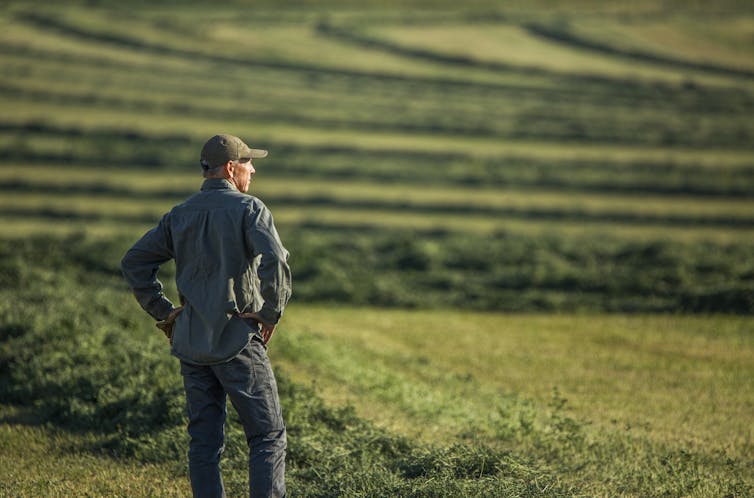
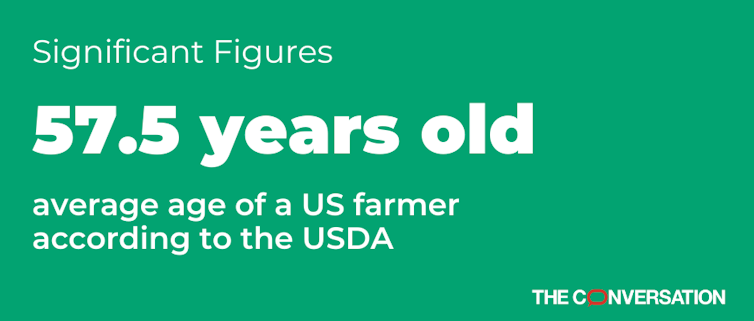
On Oct. 12, National Farmers’ Day, Americans honor the hardworking people who keep the world fed and clothed.
But the farming labor force has a problem: It’s aging rapidly.
The average American farmer is 57 and a half years old, according to the most recent data from the U.S. Department of Agriculture. That’s up sharply from 1978, when the figure was just a smidge over 50.
As researchers who study well-being in rural areas, we wanted to understand this trend and its implications. So we dug into the data.
Amber Waves Of Graying
We found that the average age of farmers was fairly consistent across the country, even though the general population’s age varies quite a bit from place to place.
For example, the average Maine farmer is just a few months older than the average farmer in Utah, even though the average Maine resident is more than a decade older than the average Utahn.
To be fair, we did find some local differences. For example, in New York County – better known as Manhattan – the average farmer is just north of 31. Next door in Hudson County, New Jersey, the average farmer is more than 72.
On the whole, though, America’s farming workforce is getting older. If the country doesn’t recruit new farmers or adapt to having fewer, older ones, it could put the nation’s food supply at risk. Before panicking, though, it’s worth asking: Why is this happening?
A Tough Field To Break Into
To start, there are real barriers to entry for young people – at least those who weren’t born into multigenerational farming families. It takes money to buy the land, equipment and other stuff you need to run a farm, and younger people have less wealth than older ones.
Young people born into family farms may have fewer opportunities to take them over due to consolidation in agriculture. And those who do have the chance may not seize it, since they often report that rural life is more challenging than living in a city or suburb.
The overall stress of the agriculture industry is also a concern: Farmers are often at the mercy of weather, supply shortages, volatile markets and other factors entirely out of their control.
In addition to understanding why fewer younger people want to go into agriculture, it’s important to consider aging farmers’ needs. Without younger people to leave the work to, farmers are left with intense labor — physically and mentally – to accomplish, on top of the ordinary challenges of aging.
In other words, the U.S. needs to increase opportunities for younger farmers while also supporting farmers as they age.
Opportunities To Help
The USDA already has programs to aid new farmers, as well as farmers of color and female farmers, and those who operate small farms. Expanding these programs’ reach and impact could help bring new talent into the field.
Congress could do just that when it reauthorizes the farm bill – a package of laws covering a wide range of food – and agriculture-related programs that get passed roughly every five years.
The farm bill also includes nutrition aid and funds telehealth and training and educational outreach for farmers, all of which could help meet the needs of young and aging farmers alike. Notably, the Cooperative Extension Service offers programs that range from 4-H and youth development, including introduction to agriculture, to providing on-site technical help.
Congress was supposed to reauthorize the farm bill by Sept. 30, 2023, but it missed that deadline. It now faces a new deadline of Dec. 31, but due to dysfunction in the House of Representatives, many expect the process to drag on into 2024.
Also in 2024, the USDA will release its next Census of Agriculture, giving researchers new insight into America’s farming workforce. We expect it will show that the average age of U.S. farmers has reached a new all-time high.
If you believe otherwise – well, we wouldn’t bet the farm.![]()
David R. Buys, Associate Professor of Health, Mississippi State University; John J. Green, Director of the Southern Rural Development Center & Professor of Agricultural Economics, Mississippi State University, and Mary Nelson Robertson, Assistant Professor of Human Development and Family Science, Mississippi State University
This article is republished from The Conversation under a Creative Commons license. Read the original article.
Pittwater Reserves: Histories + Notes + Pictorial Walks
A History Of The Campaign For Preservation Of The Warriewood Escarpment by David Palmer OAM and Angus Gordon OAM
A Stroll Through Warriewood Wetlands by Joe Mills February 2023
A Walk Around The Cromer Side Of Narrabeen Lake by Joe Mills
America Bay Track Walk - photos by Joe Mills
An Aquatic June: North Narrabeen - Turimetta - Collaroy photos by Joe Mills
Angophora Reserve Angophora Reserve Flowers Grand Old Tree Of Angophora Reserve Falls Back To The Earth - History page
Annie Wyatt Reserve - A Pictorial
Avalon's Village Green: Avalon Park Becomes Dunbar Park - Some History + Toongari Reserve and Catalpa Reserve
Bairne Walking Track Ku-Ring-Gai Chase NP by Kevin Murray
Bangalley Headland Bangalley Mid Winter
Banksias of Pittwater
Barrenjoey Boathouse In Governor Phillip Park Part Of Our Community For 75 Years: Photos From The Collection Of Russell Walton, Son Of Victor Walton
Barrenjoey Headland: Spring flowers
Barrenjoey Headland after fire
Bayview Baths
Bayview Wetlands
Beeby Park
Bilgola Beach
Botham Beach by Barbara Davies
Bungan Beach Bush Care
Careel Bay Saltmarsh plants
Careel Bay Birds
Careel Bay Clean Up day
Careel Bay Playing Fields History and Current
Careel Creek
Careel Creek - If you rebuild it they will come
Centre trail in Ku-ring-gai Chase National Park
Chiltern Track- Ingleside by Marita Macrae
Clareville Beach
Clareville/Long Beach Reserve + some History
Coastal Stability Series: Cabbage Tree Bay To Barrenjoey To Observation Point by John Illingsworth, Pittwater Pathways, and Dr. Peter Mitchell OAM
Cowan Track by Kevin Murray
Curl Curl To Freshwater Walk: October 2021 by Kevin Murray and Joe Mills
Currawong and Palm Beach Views - Winter 2018
Currawong-Mackerel-The Basin A Stroll In Early November 2021 - photos by Selena Griffith
Currawong State Park Currawong Beach + Currawong Creek
Deep Creek To Warriewood Walk photos by Joe Mills
Drone Gives A New View On Coastal Stability; Bungan: Bungan Headland To Newport Beach + Bilgola: North Newport Beach To Avalon + Bangalley: Avalon Headland To Palm Beach
Duck Holes: McCarrs Creek by Joe Mills
Dunbar Park - Some History + Toongari Reserve and Catalpa Reserve
Dundundra Falls Reserve: August 2020 photos by Selena Griffith - Listed in 1935
Elsie Track, Scotland Island
Elvina Track in Late Winter 2019 by Penny Gleen
Elvina Bay Walking Track: Spring 2020 photos by Joe Mills
Elvina Bay-Lovett Bay Loop Spring 2020 by Kevin Murray and Joe Mills
Fern Creek - Ingleside Escarpment To Warriewood Walk + Some History photos by Joe Mills
Iluka Park, Woorak Park, Pittwater Park, Sand Point Reserve, Snapperman Beach Reserve - Palm Beach: Some History
Ingleside
Ingleside Wildflowers August 2013
Irrawong - Ingleside Escarpment Trail Walk Spring 2020 photos by Joe Mills
Irrawong - Mullet Creek Restoration
Katandra Bushland Sanctuary - Ingleside
Lucinda Park, Palm Beach: Some History + 2022 Pictures
McCarrs Creek
McCarr's Creek to Church Point to Bayview Waterfront Path
McKay Reserve
Mona Vale Beach - A Stroll Along, Spring 2021 by Kevin Murray
Mona Vale Headland, Basin and Beach Restoration
Mona Vale Woolworths Front Entrance Gets Garden Upgrade: A Few Notes On The Site's History
Mount Murray Anderson Walking Track by Kevin Murray and Joe Mills
Mullet Creek
Narrabeen Creek
Narrabeen Lagoon Catchment: Past Notes Present Photos by Margaret Woods
Narrabeen Lagoon State Park
Narrabeen Lagoon State Park Expansion
Narrabeen Rockshelf Aquatic Reserve
Nerang Track, Terrey Hills by Bea Pierce
Newport Bushlink - the Crown of the Hill Linked Reserves
Newport Community Garden - Woolcott Reserve
Newport to Bilgola Bushlink 'From The Crown To The Sea' Paths: Founded In 1956 - A Tip and Quarry Becomes Green Space For People and Wildlife
Pittwater Reserves: The Green Ways; Bungan Beach and Bungan Head Reserves: A Headland Garden
Pittwater Reserves, The Green Ways: Clareville Wharf and Taylor's Point Jetty
Pittwater Reserves: The Green Ways; Hordern, Wilshire Parks, McKay Reserve: From Beach to Estuary
Pittwater Reserves - The Green Ways: Mona Vale's Village Greens a Map of the Historic Crown Lands Ethos Realised in The Village, Kitchener and Beeby Parks
Pittwater Reserves: The Green Ways Bilgola Beach - The Cabbage Tree Gardens and Camping Grounds - Includes Bilgola - The Story Of A Politician, A Pilot and An Epicure by Tony Dawson and Anne Spencer
Pittwater spring: waterbirds return to Wetlands
Pittwater's Lone Rangers - 120 Years of Ku-Ring-Gai Chase and the Men of Flowers Inspired by Eccleston Du Faur
Pittwater's Parallel Estuary - The Cowan 'Creek
Resolute Track at West Head by Kevin Murray
Resolute Track Stroll by Joe Mills
Riddle Reserve, Bayview
Salvation Loop Trail, Ku-Ring-Gai Chase National Park- Spring 2020 - by Selena Griffith
Seagull Pair At Turimetta Beach: Spring Is In The Air!
Stapleton Reserve
Stapleton Park Reserve In Spring 2020: An Urban Ark Of Plants Found Nowhere Else
Stony Range Regional Botanical Garden: Some History On How A Reserve Became An Australian Plant Park
The Chiltern Track
The Chiltern Trail On The Verge Of Spring 2023 by Kevin Murray and Joe Mills
The Resolute Beach Loop Track At West Head In Ku-Ring-Gai Chase National Park by Kevin Murray
Topham Track Ku-Ring-Gai Chase NP, August 2022 by Joe Mills and Kevin Murray
Towlers Bay Walking Track by Joe Mills
Trafalgar Square, Newport: A 'Commons' Park Dedicated By Private Landholders - The Green Heart Of This Community
Tranquil Turimetta Beach, April 2022 by Joe Mills
Turimetta Beach Reserve by Joe Mills, Bea Pierce and Lesley
Turimetta Beach Reserve: Old & New Images (by Kevin Murray) + Some History
Turimetta Headland
Warriewood Wetlands - Creeks Deteriorating: How To Report Construction Site Breaches, Weed Infestations + The Long Campaign To Save The Warriewood Wetlands & Ingleside Escarpment March 2023
Warriewood Wetlands and Irrawong Reserve
Whale Beach Ocean Reserve: 'The Strand' - Some History On Another Great Protected Pittwater Reserve
Wilshire Park Palm Beach: Some History + Photos From May 2022
Winji Jimmi - Water Maze

Pittwater's Birds
Australian Predators of the Sky by Penny Olsen - published by National Library of Australia
Australian Raven Australian Wood Duck Family at Newport
A Week In Pittwater Issue 128 A Week In Pittwater - June 2014 Issue 168
Baby Birds Spring 2015 - Rainbow Lorikeets in our Yard - for Children Baby Birds by Lynleigh Greig, Southern Cross Wildlife Care - what do if being chased by a nesting magpie or if you find a baby bird on the ground
Baby Kookaburras in our Backyard: Aussie Bird Count 2016 - October
Balloons Are The Number 1 Marine Debris Risk Of Mortality For Our Seabirds - Feb 2019 Study
Bangalley Mid-Winter Barrenjoey Birds Bird Antics This Week: December 2016
Bird of the Month February 2019 by Michael Mannington
Birdland Above the Estuary - October 2012 Birds At Our Window Birds at our Window - Winter 2014 Birdland June 2016
Birdsong Is a Lovesong at This time of The Year - Brown Falcon, Little Wattle Bird, Australian Pied cormorant, Mangrove or Striated Heron, Great Egret, Grey Butcherbird, White-faced Heron
Bird Songs – poems about our birds by youngsters from yesterdays - for children Bird Week 2015: 19-25 October
Bird Songs For Spring 2016 For Children by Joanne Seve
Birds at Careel Creek this Week - November 2017: includes Bird Count 2017 for Local Birds - BirdLife Australia by postcode
Black Cockatoo photographed in the Narrabeen Catchment Reserves this week by Margaret G Woods - July 2019
Black-Necked Stork, Mycteria Australis, Now Endangered In NSW, Once Visited Pittwater: Breeding Pair shot in 1855
Black Swans on Narrabeen Lagoon - April 2013 Black Swans Pictorial
Endangered Little Tern Fishing at Mona Vale Beach
‘Feather Map of Australia’: Citizen scientists can support the future of Australia's wetland birds: for Birdwatchers, school students and everyone who loves our estuarine and lagoon and wetland birds
Fledgling Common Koel Adopted by Red Wattlebird -Summer Bird fest 2013 Flegdlings of Summer - January 2012
Flocks of Colour by Penny Olsen - beautiful new Bird Book Celebrates the 'Land of the Parrots'
Friendly Goose at Palm Beach Wharf - Pittwater's Own Mother Goose
Front Page Issue 177 Front Page Issue 185 Front Page Issue 193 - Discarded Fishing Tackle killing shorebirds Front Page Issue 203 - Juvenile Brush Turkey Front Page Issue 208 - Lyrebird by Marita Macrae Front Page Issue 219 Superb Fairy Wren Female Front Page Issue 234: National Bird Week October 19-25 and the 2015 the Aussie Back Yard Bird Count: Australia's First Bird Counts - a 115 Year Legacy - with a small insight into our first zoos Front Page Issue 236: Bird Week 2015 Front Page Issue 244: watebirds Front Page Issue 260: White-face Heron at Careel Creek Front Page Issue 283: Pittwater + more birds for Bird Week/Aussie Bird Count Front Page Issue 284: Pittwater + more birds for Bird Week/Aussie Bird Count Front Page Issue 285: Bird Week 2016 Front Page Issue 331: Spring Visitor Birds Return
G . E. Archer Russell (1881-1960) and His Passion For Avifauna From Narrabeen To Newport
Glossy Black-Cockatoo Returns To Pittwater by Paul Wheeler Glossy Cockatoos - 6 spotted at Careel Bay February 2018
Grey Butcher Birds of Pittwater
INGLESIDE LAND RELEASE ON AGAIN BUT MANY CHALLENGES AHEAD by David Palmer
Issue 60 May 2012 Birdland - Smiles- Beamings -Early -Winter - Blooms
Jayden Walsh’s Northern Beaches Big Year - courtesy Pittwater Natural Heritage Association
John Gould's Extinct and Endangered Mammals of Australia by Dr. Fred Ford - Between 1850 and 1950 as many mammals disappeared from the Australian continent as had disappeared from the rest of the world between 1600 and 2000! Zoologist Fred Ford provides fascinating, and often poignant, stories of European attitudes and behaviour towards Australia's native fauna and connects these to the animal's fate today in this beautiful new book - our interview with the author
July 2012 Pittwater Environment Snippets; Birds, Sea and Flowerings
Juvenile Sea Eagle at Church Point - for children
King Parrots in Our Front Yard
Kookaburra Turf Kookaburra Fledglings Summer 2013 Kookaburra Nesting Season by Ray Chappelow Kookaburra Nest – Babies at 1.5 and 2.5 weeks old by Ray Chappelow Kookaburra Nest – Babies at 3 and 4 weeks old by Ray Chappelow Kookaburra Nest – Babies at 5 weeks old by Ray Chappelow Kookaburra and Pittwater Fledglings February 2020 to April 2020
Lion Island's Little Penguins (Fairy Penguins) Get Fireproof Homes - thanks to NSW National Parks and Wildlife Service and the Fix it Sisters Shed
Lyre Bird Sings in Local National Park - Flock of Black Cockatoos spotted - June 2019
Magpie's Melodic Melodies - For Children (includes 'The Magpie's Song' by F S Williamson)
Masked Lapwing (Plover) - Reflected
May 2012 Birdland Smiles Beamings Early Winter Blooms
Musk Lorikeets In Pittwater: Pittwater Spotted Gum Flower Feast - May 2020
Nankeen Kestrel Feasting at Newport: May 2016
National Bird Week 2014 - Get Involved in the Aussie Backyard Bird Count: National Bird Week 2014 will take place between Monday 20 October and Sunday 26 October, 2014. BirdLife Australia and the Birds in Backyards team have come together to launch this year’s national Bird Week event the Aussie Backyard Bird Count! This is one the whole family can do together and become citizen scientists...
National Bird Week October 19-25 and the 2015 the Aussie Back Yard Bird Count: Australia's First Bird Counts - a 115 Year Legacy - with a small insight into our first zoos
Nature 2015 Review Earth Air Water Stone
New Family of Barking Owls Seen in Bayview - Church Point by Pittwater Council
Noisy Visitors by Marita Macrae of PNHA
Odes to Australia's Fairy-wrens by Douglas Brooke Wheelton Sladen and Constance Le Plastrier 1884 and 1926
Oystercatcher and Dollarbird Families - Summer visitors
Painted Button-Quail Rescued By Locals - Elanora-Ingleside escarpment-Warriewood wetlands birds
Palm Beach Protection Group Launch, Supporters Invited: Saturday Feb.16th - Residents Are Saying 'NO' To Off-Leash Dogs In Station Beach Eco-System - reports over 50 dogs a day on Station Beach throughout December-January (a No Dogs Beach) small children being jumped on, Native birds chased, dog faeces being left, families with toddlers leaving beach to get away from uncontrolled dogs and 'Failure of Process' in council 'consultation' open to February 28th
Pardalote, Scrub Wren and a Thornbill of Pittwater
Pecking Order by Robyn McWilliam
Pelican Lamps at Narrabeen Pelican Dreamsong - A Legend of the Great Flood - dreamtime legend for children
Pittwater Becalmed Pittwater Birds in Careel Creek Spring 2018 Pittwater Waterbirds Spring 2011 Pittwater Waterbirds - A Celebration for World Oceans Day 2015
Pittwater's Mother Nature for Mother's Day 2019
Plastic in 99 percent of seabirds by 2050 by CSIRO
Plover Appreciation Day September 16th 2015
Powerful and Precious by Lynleigh Grieg
Red Wattlebird Song - November 2012
Restoring The Diamond: every single drop. A Reason to Keep Dogs and Cats in at Night.
Sea Birds off the Pittwater Coast: Albatross, Gannet, Skau + Australian Poets 1849, 1898 and 1930, 1932
Sea Eagle Juvenile at Church Point
Seen but Not Heard: Lilian Medland's Birds - Christobel Mattingley - one of Australia's premier Ornithological illustrators was a Queenscliff lady - 53 of her previously unpublished works have now been made available through the auspices of the National Library of Australia in a beautiful new book
7 Little Ducklings: Just Keep Paddling - Australian Wood Duck family take over local pool by Peta Wise
Shag on a North Avalon Rock - Seabirds for World Oceans Day 2012
Short-tailed Shearwaters Spring Migration 2013
South-West North-East Issue 176 Pictorial
Spring 2012 - Birds are Splashing - Bees are Buzzing
Spring Becomes Summer 2014- Royal Spoonbill Pair at Careel Creek
Spring Notes 2018 - Royal Spoonbill in Careel Creek
Station Beach Off Leash Dog Area Proposal Ignores Current Uses Of Area, Environment, Long-Term Fauna Residents, Lack Of Safe Parking and Clearly Stated Intentions Of Proponents have your say until February 28, 2019
Summer 2013 BirdFest - Brown Thornbill Summer 2013 BirdFest- Canoodlers and getting Wet to Cool off Summer 2013 Bird Fest - Little Black Cormorant Summer 2013 BirdFest - Magpie Lark
New Shorebirds WingThing For Youngsters Available To Download
A Shorebirds WingThing educational brochure for kids (A5) helps children learn about shorebirds, their life and journey. The 2021 revised brochure version was published in February 2021 and is available now. You can download a file copy here.
If you would like a free print copy of this brochure, please send a self-addressed envelope with A$1.10 postage (or larger if you would like it unfolded) affixed to: BirdLife Australia, Shorebird WingThing Request, 2-05Shorebird WingThing/60 Leicester St, Carlton VIC 3053.

 Shorebird Identification Booklet
Shorebird Identification Booklet
The Migratory Shorebird Program has just released the third edition of its hugely popular Shorebird Identification Booklet. The team has thoroughly revised and updated this pocket-sized companion for all shorebird counters and interested birders, with lots of useful information on our most common shorebirds, key identification features, sighting distribution maps and short articles on some of BirdLife’s shorebird activities.
The booklet can be downloaded here in PDF file format: http://www.birdlife.org.au/documents/Shorebird_ID_Booklet_V3.pdf
Paper copies can be ordered as well, see http://www.birdlife.org.au/projects/shorebirds-2020/counter-resources for details.
Download BirdLife Australia's children’s education kit to help them learn more about our wading birdlife
Shorebirds are a group of wading birds that can be found feeding on swamps, tidal mudflats, estuaries, beaches and open country. For many people, shorebirds are just those brown birds feeding a long way out on the mud but they are actually a remarkably diverse collection of birds including stilts, sandpipers, snipe, curlews, godwits, plovers and oystercatchers. Each species is superbly adapted to suit its preferred habitat. The Red-necked Stint is as small as a sparrow, with relatively short legs and bill that it pecks food from the surface of the mud with, whereas the Eastern Curlew is over two feet long with a exceptionally long legs and a massively curved beak that it thrusts deep down into the mud to pull out crabs, worms and other creatures hidden below the surface.
Some shorebirds are fairly drab in plumage, especially when they are visiting Australia in their non-breeding season, but when they migrate to their Arctic nesting grounds, they develop a vibrant flush of bright colours to attract a mate. We have 37 types of shorebirds that annually migrate to Australia on some of the most lengthy and arduous journeys in the animal kingdom, but there are also 18 shorebirds that call Australia home all year round.
What all our shorebirds have in common—be they large or small, seasoned traveller or homebody, brightly coloured or in muted tones—is that each species needs adequate safe areas where they can successfully feed and breed.
The National Shorebird Monitoring Program is managed and supported by BirdLife Australia.
This project is supported by Glenelg Hopkins Catchment Management Authority and Hunter Local Land Services through funding from the Australian Government’s National Landcare Program. Funding from Helen Macpherson Smith Trust and Port Phillip Bay Fund is acknowledged.
The National Shorebird Monitoring Program is made possible with the help of over 1,600 volunteers working in coastal and inland habitats all over Australia.
The National Shorebird Monitoring program (started as the Shorebirds 2020 project initiated to re-invigorate monitoring around Australia) is raising awareness of how incredible shorebirds are, and actively engaging the community to participate in gathering information needed to conserve shorebirds.
In the short term, the destruction of tidal ecosystems will need to be stopped, and our program is designed to strengthen the case for protecting these important habitats.
In the long term, there will be a need to mitigate against the likely effects of climate change on a species that travels across the entire range of latitudes where impacts are likely.
The identification and protection of critical areas for shorebirds will need to continue in order to guard against the potential threats associated with habitats in close proximity to nearly half the human population.
Here in Australia, the place where these birds grow up and spend most of their lives, continued monitoring is necessary to inform the best management practice to maintain shorebird populations.
BirdLife Australia believe that we can help secure a brighter future for these remarkable birds by educating stakeholders, gathering information on how and why shorebird populations are changing, and working to grow the community of people who care about shorebirds.
To find out more visit: http://www.birdlife.org.au/projects/shorebirds-2020/shorebirds-2020-program
Aussie Bread Tags Collection Points

AFP Urges Seniors To Learn Their Cyber ABCs
- A: Avoid clicking on links sent in unsolicited email or text;
- B: Block calls on mobile devices from suspected scammers; and,
- C: Call your financial institution immediately if you identify a suspicious transaction or you believe your bank account has been targeted by cyber criminals.

Mobile Phones Now Banned In All NSW Public Schools
- Off and away: Phones are ‘off and away’ in classrooms (typically kept in the student’s school bag). Phones are not used for the duration of the school day.
- Phones in lockers: Students do not carry the phones with them; they must be kept in a locker for the whole school day.
- Locked phone pouch: Students place their phone in a magnetically locked pouch and are unable to use their phone. Pouches are magnetically unlocked at the end of the school day.
- Phones collected at the front office: Students deposit their phone at the school’s front office at the start of the school day and collect it at the day’s end (or when leaving the school premises).
New Campaign Shines A Spotlight On Safe Drinking This Summer
- Don’t accept drinks from others. Always buy your own and watch it get made. Never leave your drink unattended and avoid batch drinks like punches that may have unknown ingredients and alcohol content.
- Pace yourself. Count your drinks, try a low-alcohol alternative, or have a ‘spacer’ of water between alcoholic drinks. Don't let people continually top up your drink, as it’s hard to keep track of your alcohol consumption and be aware that different drinks have different strengths. Set a timer on your phone to help you pace your drinks.
- Avoid shouts, drinking games or shots. Drink at your own pace, you don’t have to join in every round and consider buying a non-alcoholic drink when it's your turn. Don't be pressured into drinking more than you want or intend to.
- Eat before or while you are drinking. If you have a full stomach, alcohol will be absorbed more slowly. Avoid salty snacks, as these make you drink more.
- Stay busy. If you have something to do, you tend to drink less, so have a game of pool or hit the dance floor.
- Trust your feelings and instincts. If you feel unsafe, uncomfortable, or worried for any reason, try to get somewhere safe and find someone you trust who can help you, like a friend, bar staff, security or police. You won’t get in trouble.
- Have a ‘plan B’. Plans change quickly, ensure you have multiple options to get home safely. Remember you may still be over the limit the next morning.
- Always tell your mates where you’re going. Let someone know which venue you’re drinking at. If you go to another location, particularly with someone you don’t know well, send the address to a trusted friend. If you decide to go home early, leave the group or even just go to the bathroom, let your mates know.
- Keep an eye on your mates! If you are going out in a group, plan to arrive together and leave together. Never leave a friend who's been drinking on their own. If you’re at a party, check in with them during the night to see how they’re doing. If something doesn’t look right, let a friend know you are uncomfortable or worried about their safety.
- Sometimes sticking together isn't enough, you need to recognise when you might need to call for help.
- Consent and boundaries. Alcohol can lower your inhibitions. Be aware of this and set boundaries for yourself before going out. Remember if someone seems drunk, they probably can’t consent. Instead, trade numbers.
- Drink spiking. Many drugs and alcohol used to spike drinks are tasteless. If there’s a change in your drink’s flavour or if it tastes or smells stronger than what you were expecting, get rid of it and let a trusted person know. Know the signs and symptoms of drink spiking: feeling dizzy, faint, ill, sleepy, incoherent, confused or drunk even though you’ve consumed a small amount of alcohol. If you experience these, let someone know. If you see a friend experiencing these symptoms, check in and stay with them until they recover. Call TripleZero (000) in an emergency.
Police Given Power To Issue On-The-Spot Fines With Health Intervention For Small Quantity Drug Possession
- Drug supply, dealing or trafficking; or
- Drug production or manufacture; or
- Previously convicted drug dealers; or
- People who have large quantities of drugs; or
- People who have already received two Criminal Infringement Notices for drug possession offences.
Be Prepared For The Asthma Season
- if you have ever been diagnosed with asthma or have hay fever, ensuring you have an up-to-date action plan in place, including how you should manage your symptoms if you experience a flare-up due to bushfire smoke or pollen
- if your child has asthma, providing any updated asthma action plans to your child's preschool, childcare centre or school
- checking that your and/or your child's asthma reliever medication and spacer is up-to-date and stored in an easy spot for you or a responsible adult to get quickly
- if you have hay fever or asthma, knowing the warning signs of asthma like wheezing, breathlessness, feeling tight in the chest or persistent cough and when to seek advice from your doctor or urgent emergency care
- during times of high pollen, bushfire smoke or thunderstorms, where possible remaining inside and keeping windows and doors closed.
Crystal Bay Newport: 1880 To 1890
photos courtesy of the NSW State Records and Archives, the Powerhouse Museum's Tyrell Collection and RPAYC
More in: Collin’s Retreat, Bay View House, Scott’s Sanatorium, Guest And Boarding House: Crystal Bay, Newport
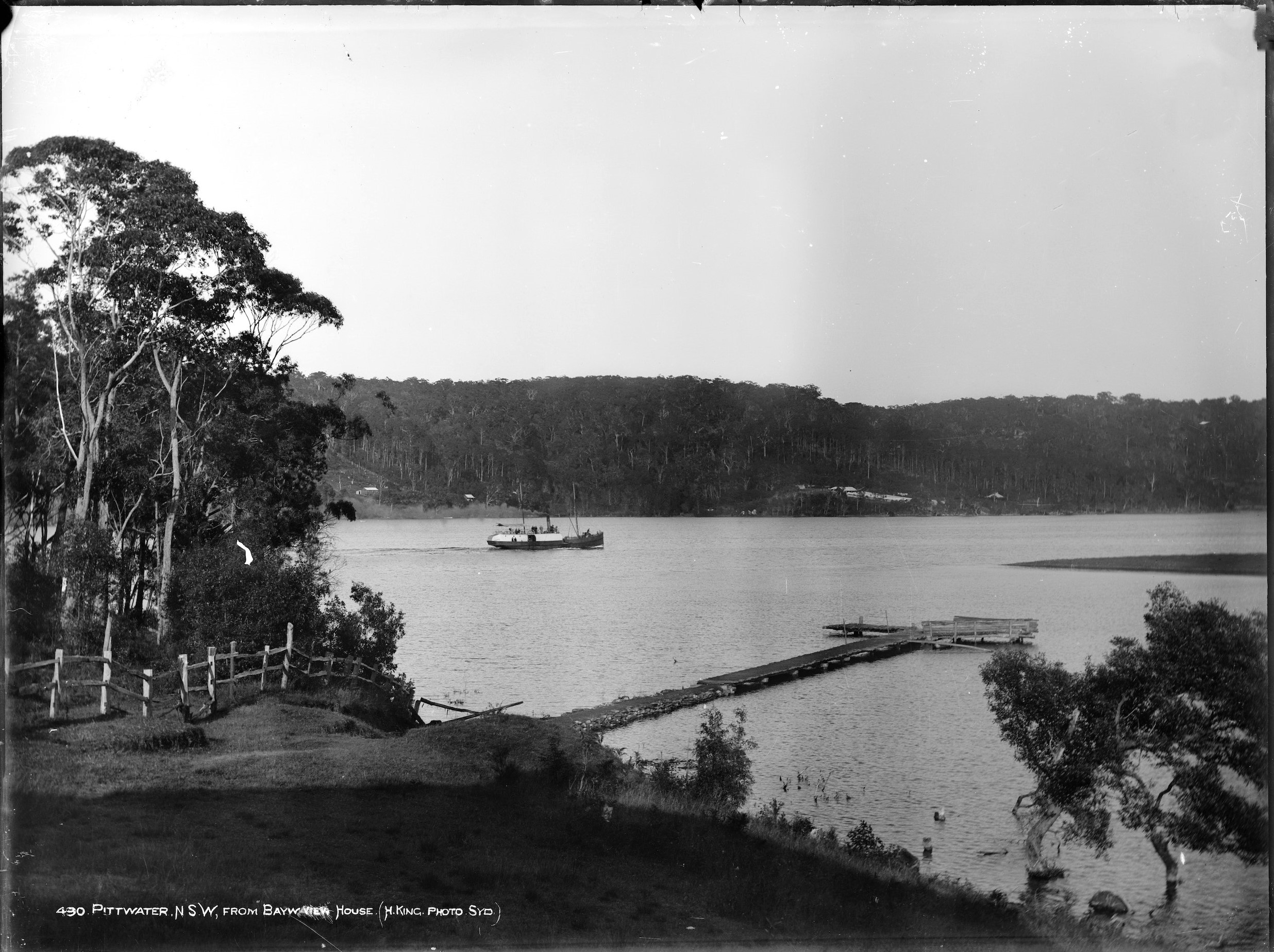
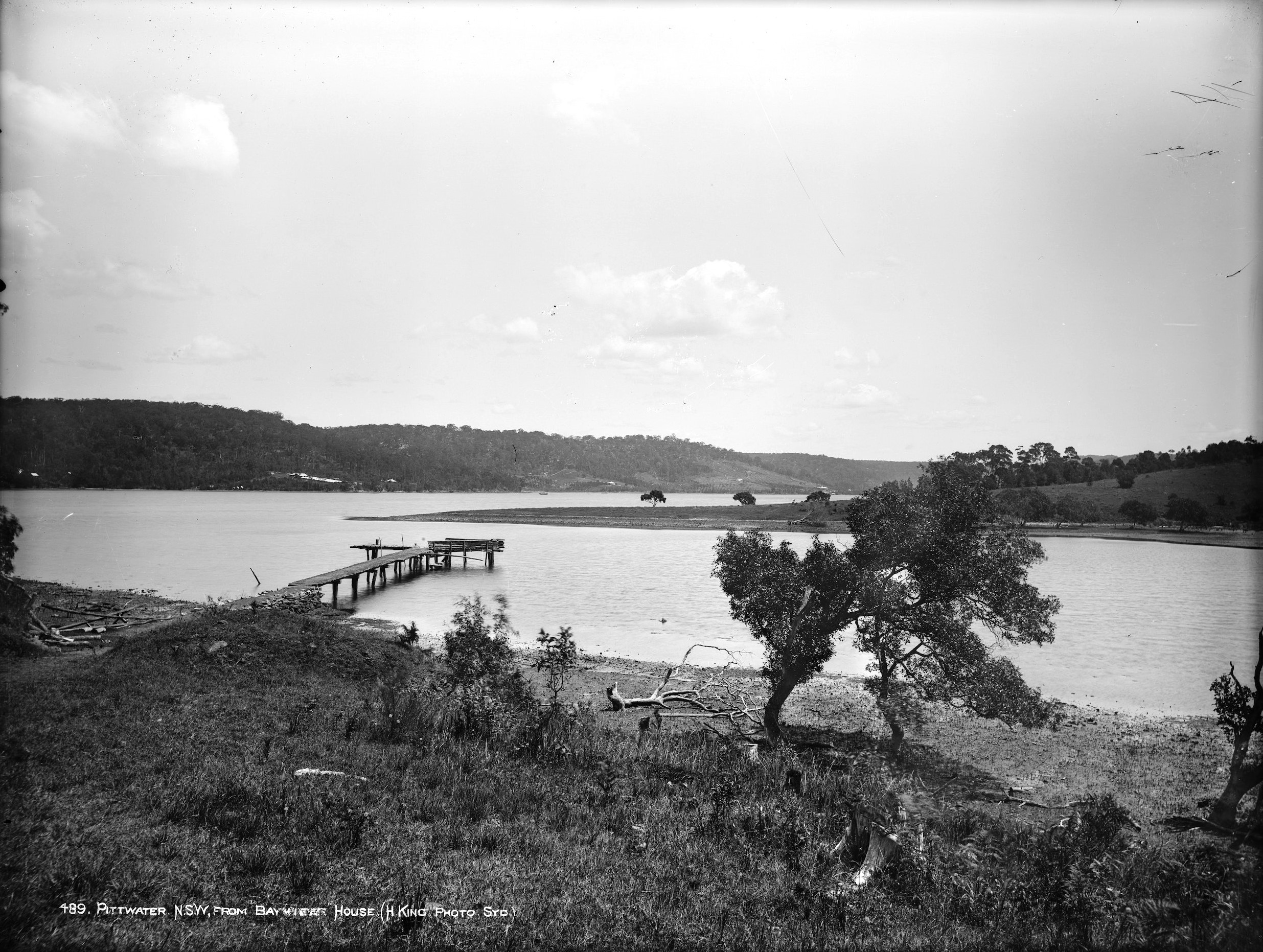
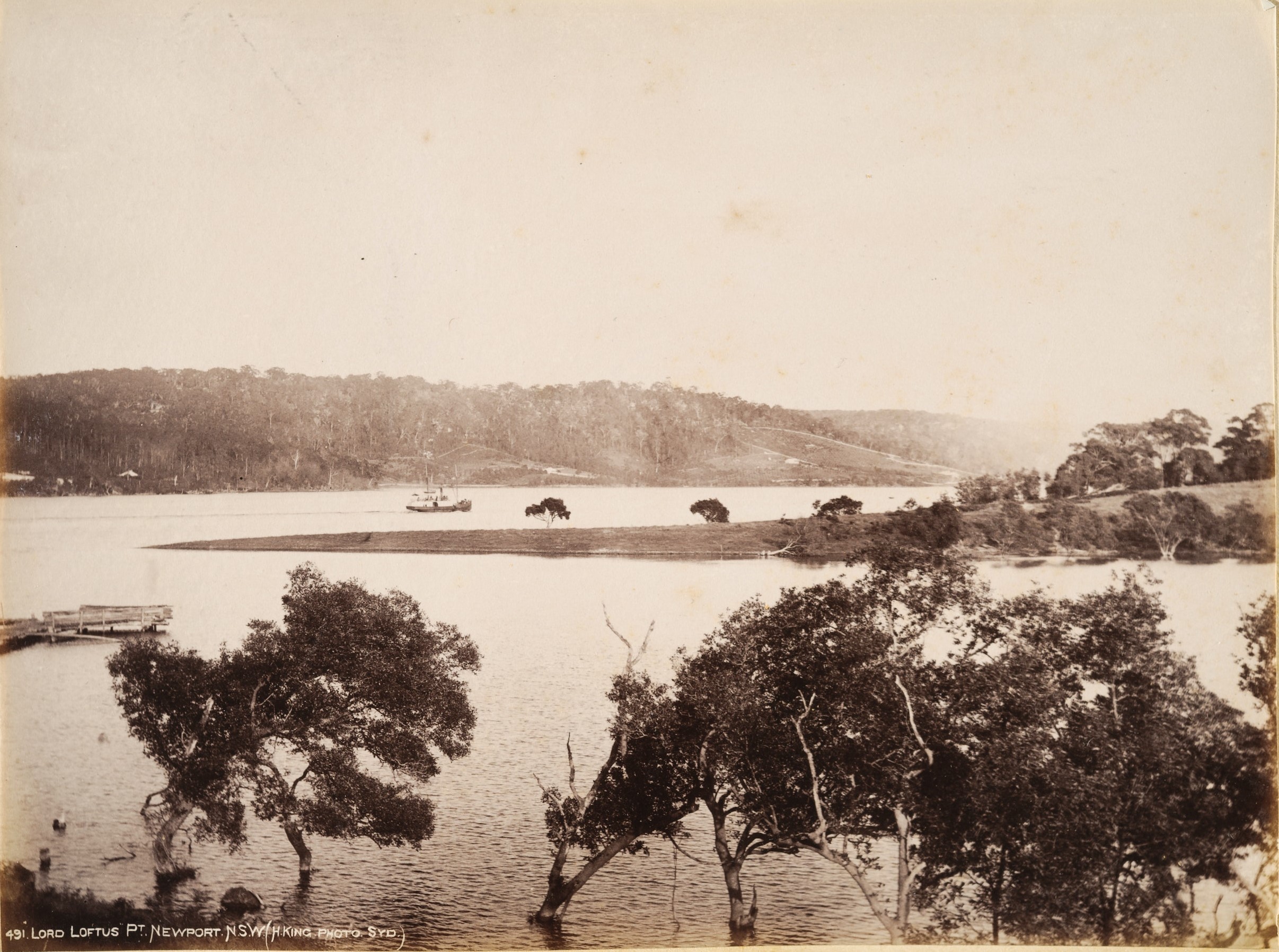
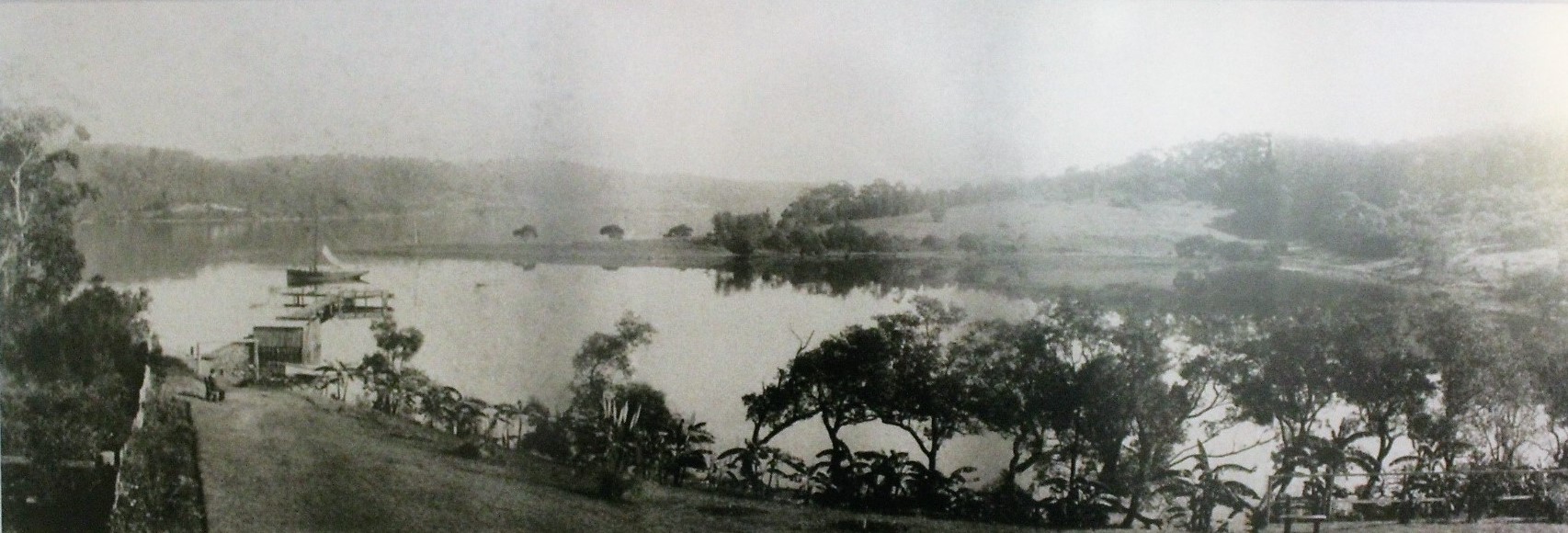
UNDERWATER! 2023 Photo Competition Now Open: Dive On In To The 30th Ocean Festival
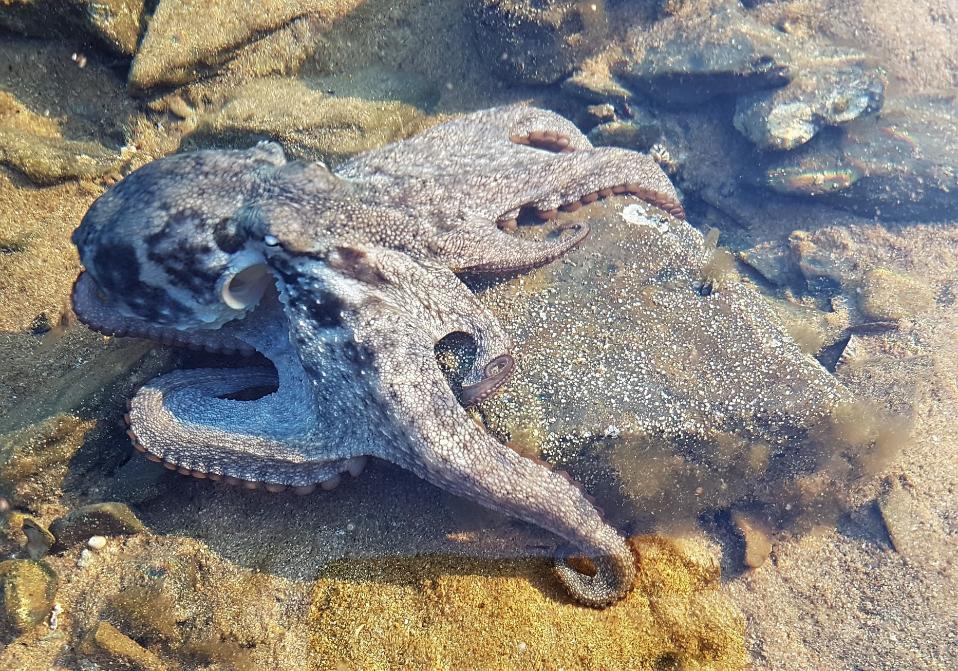
Resident octopus at North Narrabeen Aquatic Reserve rock shelf - photo by Joe Mills
Entries are now open for the UNDERWATER! 2023 Photo Competition with a prize pool of $4,400 up for grabs.
Now in its third year, the annual competition is part of the 30th Ocean Festival which kicks off at the end of November (Sunday 26 November – Sunday 3 December) with an eight day festival celebrating our five marine protected areas, our invertebrates, marine flora, fauna and megafauna.
The UNDERWATER! 2023 Photo Competition celebrates our ocean, its biodiversity and the human connection to it, along with the urgent need to protect our oceans for future generations.
Northern Beaches Mayor Sue Heins said our precious oceans are the great connectors of our world, uniting continents, cultures, creatures and deserve our utmost care and respect.
“Covering over 80% of our planet, oceans are more than just bodies of water; they are sanctuaries of life, and they should not be taken for granted. We need to be their guardians and preserve them for generations to come.
“Our oceans are the lungs of our planet, providing 50% of the oxygen we breathe, and our lives depend on it. The more that people know about what is under the water, the more likely they are to protect our oceans.
“Sharing photographs of the wonders beneath the waterline as part of the Ocean Festival, is the perfect opportunity to share knowledge about protecting and conserving our oceans to safeguard this treasure which is such an important part of life on the Northern Beaches,” Mayor Heins said.
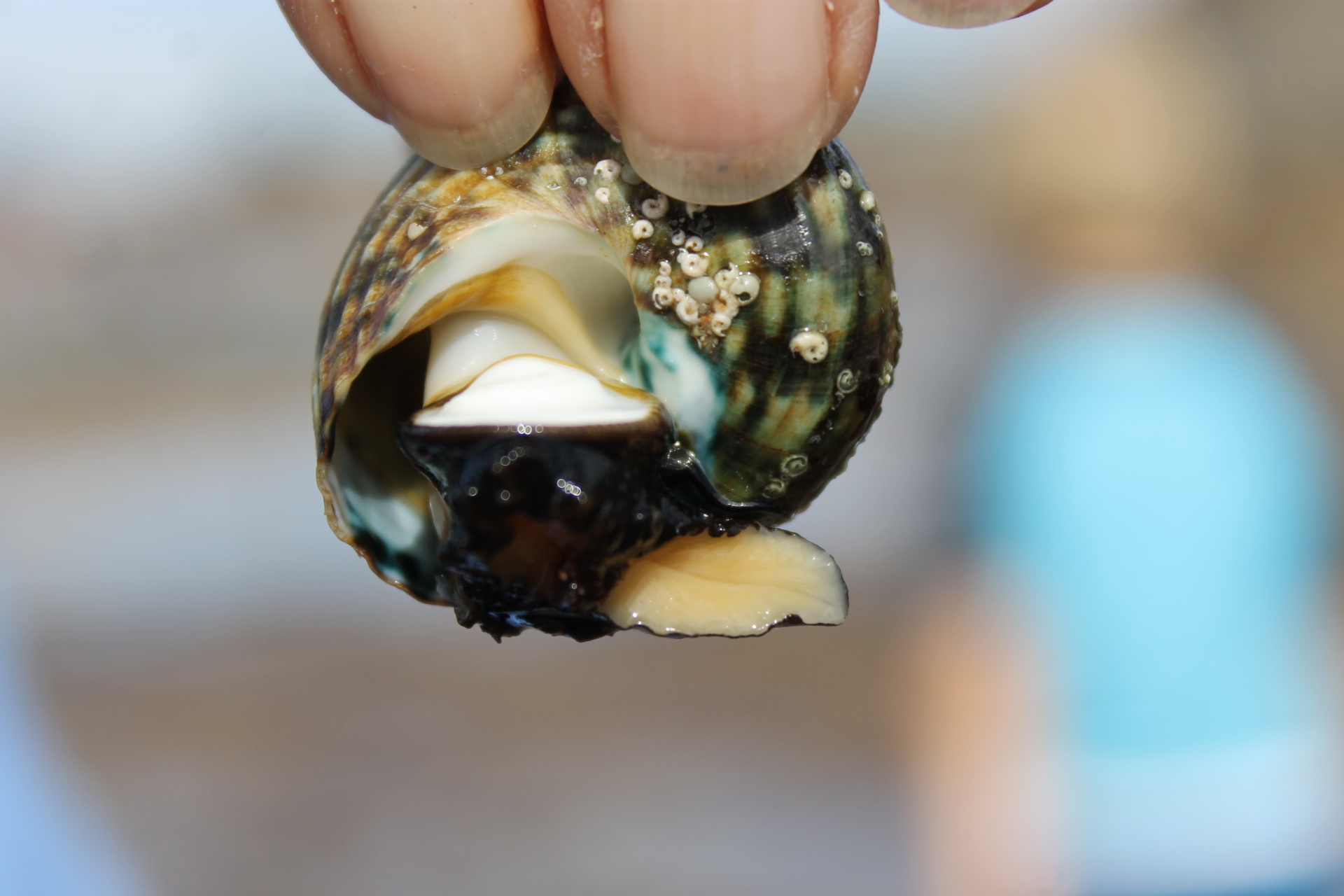
Entrants are asked to respond to the eight categories with this year’s theme ‘Life Below Water’. All submissions must be taken within the last two years at one of the five aquatic reserves on the Northern Beaches.
This year young people aged 18 – 24yrs are also encouraged to enter the competition and share their fascination with the underwater world. The winner will be recognised as the Young UNDERWATER! 2023 Photographer of the Year.
In addition, a new category of Reels (15 - 30 secs) has been added to appeal to underwater videographers.
Entries for all categories close 11:59pm on Monday 23 October 2023.
The People’s Choice Award will be online for voting from 6 -19 November.
Council will keep you posted on the line up for the 30th Ocean Festival but some of the activities include Science at the Steyne, Dive for Debris, Rock Platform Rambles, UNDERWATER! 2023 Photo winners and an exhibition, Guided Snorkel Tours, SUP Safaris, coast walks, talks and much more.
For more information about the competition and to enter visit: www.northernbeaches.nsw.gov.au/things-do/whats/ocean-festival/underwater-2023-photo-competition
Large Fossil Spider Found In Australia
A team of Australian scientists led by Australian Museum (AM) and University of New South Wales (UNSW) palaeontologist Dr Matthew McCurry have formally named and described a fossil spider, Megamonodontium mccluskyi, which is between 11 – 16 million years old. The findings on this new genus of spider have now been published in the 2023 Zoological Journal of Linnean Society.
Found at McGraths Flat, NSW, a fossil site known for its iron-rich rock called ‘goethite’, the new genus of spider is the first ever spider fossil of the Barychelidae family to be found. Similar to the living genus, Monodontium (a brushed trapdoor spider) but five times larger, the spider was named after Dr Simon McClusky who found the specimen. A geospatial scientist based in Canberra, McClusky volunteers his time helping on palaeontological excavations.
Dr McCurry said that there have been very few fossil spiders found in Australia which makes the discovery very significant.
''Only four spider fossils have ever been found throughout the whole continent, which has made it difficult for scientists to understand their evolutionary history. That is why this discovery is so significant, it reveals new information about the extinction of spiders and fills a gap in our understanding of the past.'' - Dr Matthew McCurry
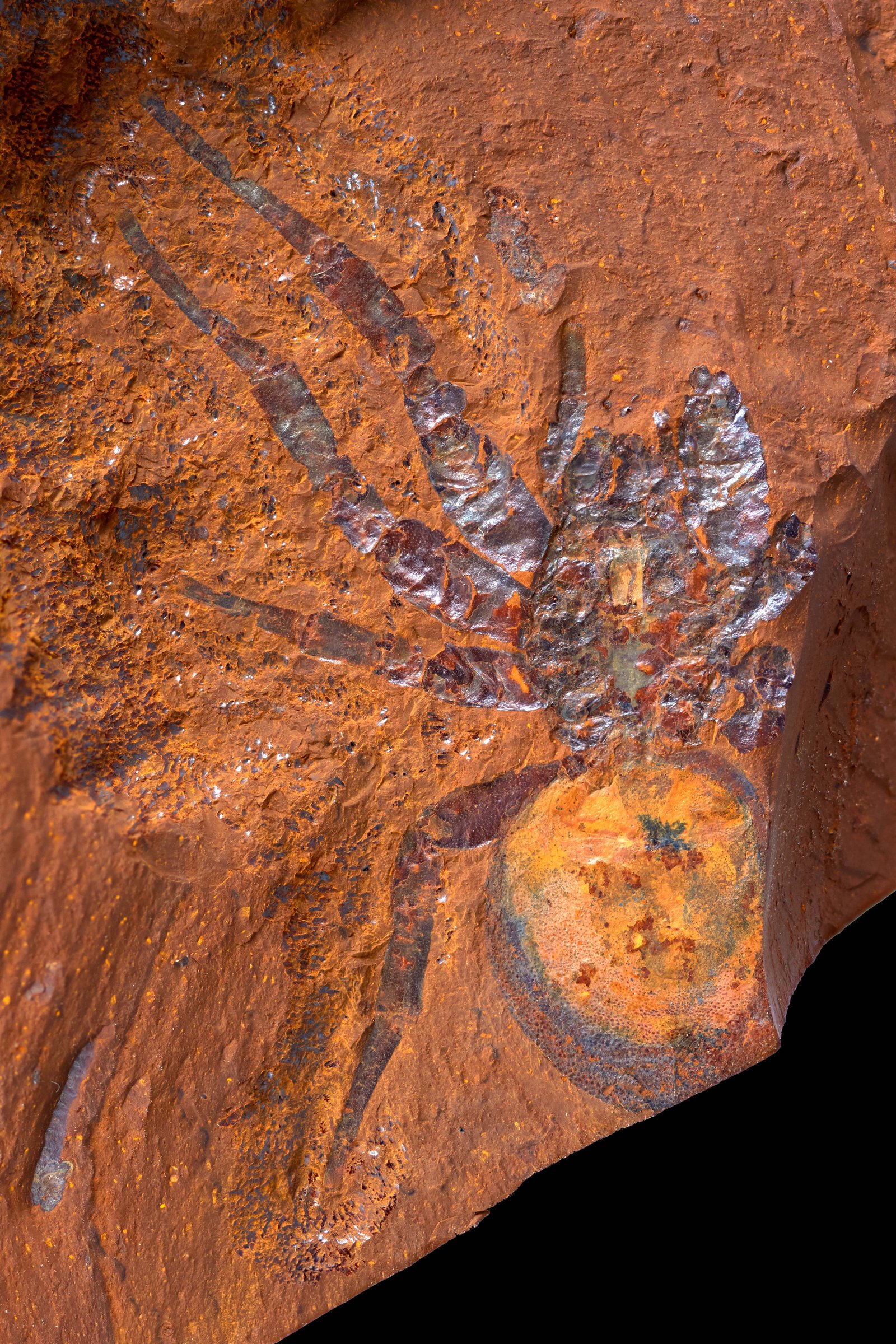
Fossilised spider, Megamonodontium mccluskyi. Image: Michael Frese © Michael Frese
“The closest living relative of this fossil now lives in wet forests in Singapore through to Papua New Guinea. This suggests that the group once occupied similar environments in mainland Australia but have subsequently gone extinct as Australia became more arid.”
Queensland Museum arachnologist, Dr Robert Raven, who was the supervising author of the study said this was the largest fossil spider to be found in Australia.
“Not only is it the largest fossilised spider to be found in Australia but it is the first fossil of the family Barychelidae that has been found worldwide.”
“There are around 300 species of brush-footed trapdoor spiders alive today, but they don’t seem to become fossils very often. This could be because they spend so much time inside burrows and so aren’t in the right environment to be fossilised.”
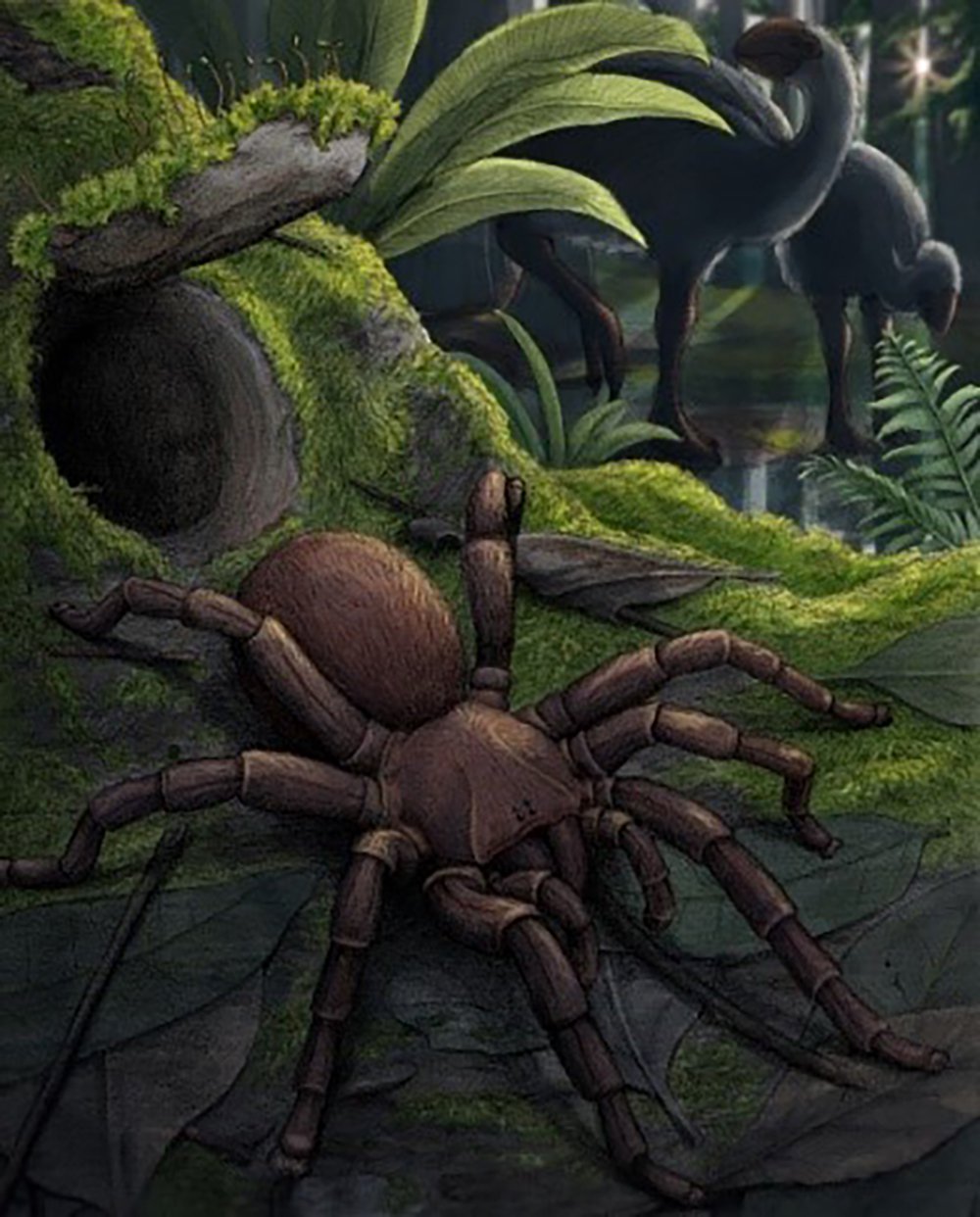
Artist’s reconstruction of Megamonodontium mccluskyi. Image: Alex Boersma © Alex Boersma
University of Canberra Associate Professor, Michael Frese, who used stacking microphotography to scan the fossils said that the fossils from McGraths Flat show an amazing level of detailed preservation.
"Scanning electron microscopy allowed us to study minute details of the claws and setae on the spider's pedipalps, legs and the main body. Setae are hair-like structures that can have a range of functions. They can sense chemicals and vibrations, defend the spider against attackers and even make sounds."
The fossil is now housed in the AM’s palaeontology collection and is available online for researchers to study.
A separate paper will be published on the same day in the Zoological Journal of the Linnean Society describing a jumping spider from McGraths Flat. These are separate publications, but both describe fossils from the same site. Matthew McCurry and Michael Frese are authors on both pieces of work.
DOI: doi.org/10.1093/zoolinnean/zlad105.
McGraths Flat
First found in 2017, McGraths Flat is named after Nigel McGrath who discovered the first fossils from the site. The site is located near Gulgong in central NSW (Gulgong is a Wiradjuri word that means “deep waterhole”).
The Miocene Epoch (~23–5 million years ago) was a time of immense change in Australia. The Australian continent had separated from Antarctica and South America and was drifting northwards. When the Miocene began there was enormous richness and variety of plant and animal life in Australia. But at around 14 million years ago an abrupt change in climate known as the “Middle Miocene Disruption” caused widespread extinctions. Throughout the latter half of the Miocene, Australia gradually became more and more arid, and rainforests turned into the dry shrublands and deserts that now characterise the landscape. The newly discovered fossil site, McGraths Flat, provides an unprecedented look into what Australian ecosystems were like prior to this aridification.
About the Australian Museum
The Australian Museum (AM) was founded in 1827 and is the nation’s first museum. It is internationally recognised as a natural science and culture institution focused on Australia and the Pacific. The AM’s mission is to ignite wonder, inspire debate and drive change. The AM’s vision is to be a leading voice for the richness of life, the Earth and culture in Australia and the Pacific.

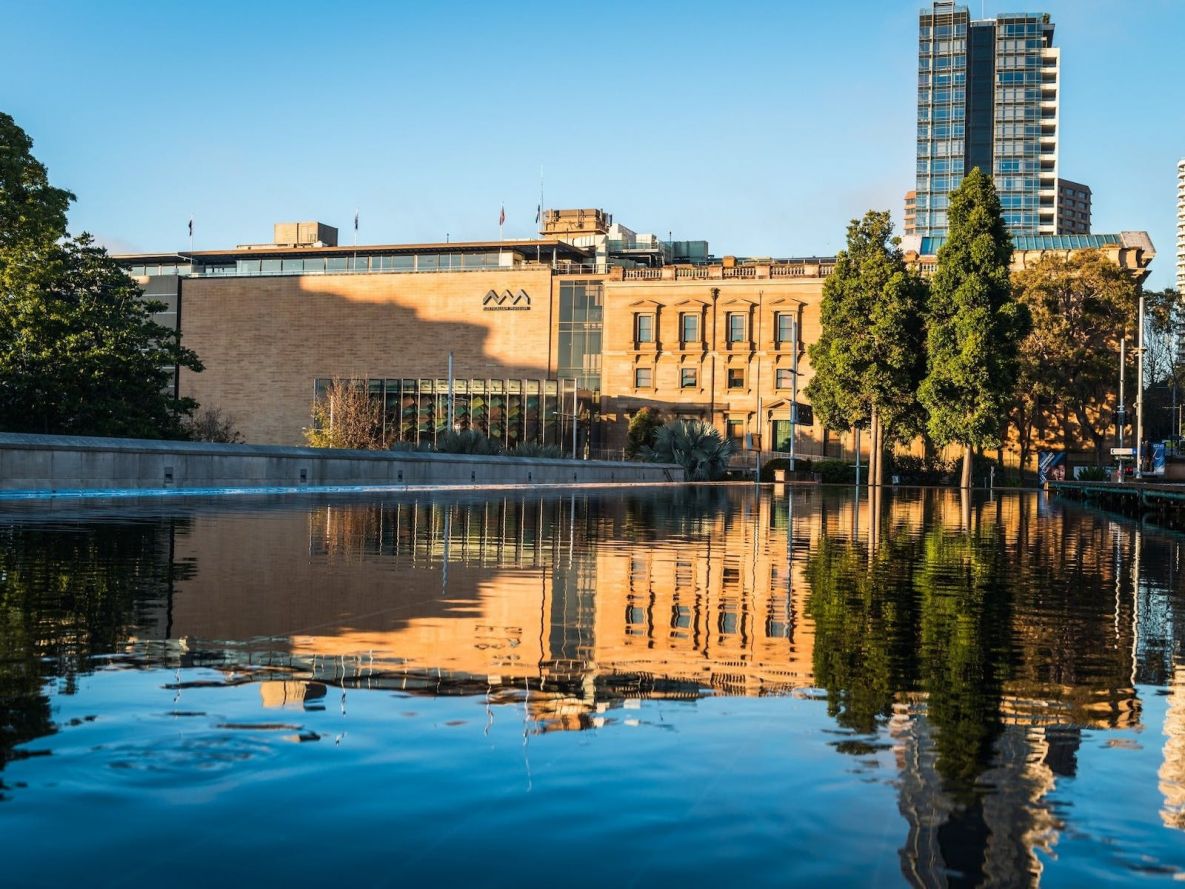
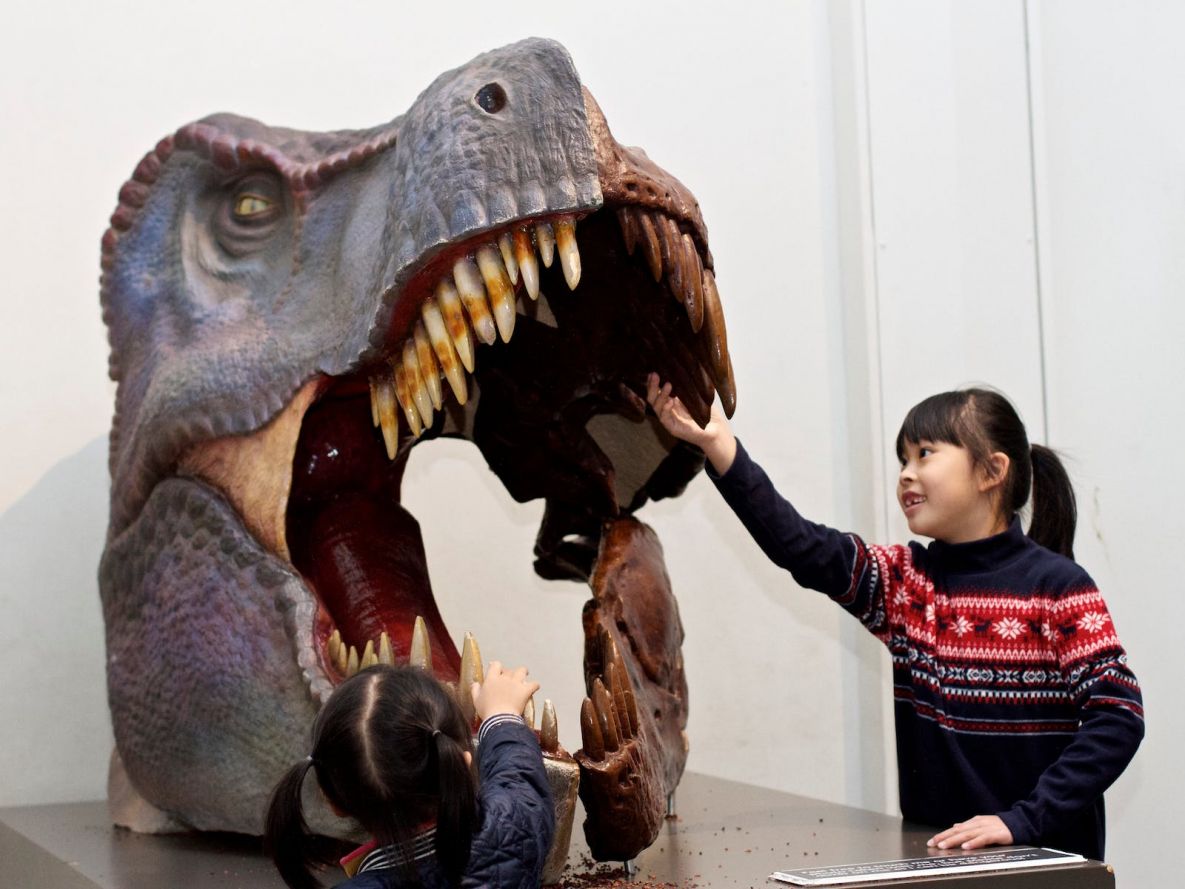
The AM commits to transforming the conversation around climate change, the environment and wildlife conservation; to being a strong advocate for First Nations cultures; and to continuing to develop world-leading science, collections, exhibitions and education programs. With more than 21.9 million objects and specimens and the Australian Museum Research Institute (AMRI), the AM is not only a dynamic source of reliable scientific information on some of the most pressing environmental and social challenges facing our region, but also an important site of cultural exchange and learning.
Where: (opposite Hyde Park), 1 William Street, Sydney
Cost: Free entry
Accessibility: Welcomes people with access needs
Facilities: Cafe, Conference Facilities, Parents Room, Public Telephone, Public Toilet, Restaurant, Shop / Gift Shop
New Research By ReachOut Highlights Links Between Study Stress And Poor Sleep In The Lead Up To Year 12 Exams
- Lifeline – 13 11 14
- Kids Helpline – 1800 55 1800
- 13YARN – 13 92 76 to speak with an Aboriginal & Torres Strait Islander crisis supporter
- If you are in immediate danger dial 000
Links To ReachOut Support Content

8 Student-Backed Study Tips To Help You Tackle The HSC
By University of Sydney: Last updated 6 July 2023
Our students have been through their fair share of exams and learned a lot of great study tactics along the way. Here they share their top study tips to survive and thrive during exam time.
1. Start your day right
Take care of your wellbeing first thing in the morning so you can dive into your day with a clear mind.
“If you win the morning, you can win the day,” says Juris Doctor student Vee Koloamatangi-Lamipeti.
An active start is a great way to set yourself up for a productive day. Begin your morning with exercise or a gentle walk, squeeze in 10 minutes of meditation and enjoy a healthy breakfast before you settle into study.
2. Schedule your study
“Setting up a schedule will help you organise your time so much better,” says Master of Teaching student Wesley Lai.
Setting a goal or a theme for each study block will help you to stay focused, while devoting time across a variety of subjects will ensure you've covered off as much as possible. Remember to keep your schedule realistic and avoid over-committing your time.
Adds Wesley, “Make sure to schedule in some free time for yourself as well!”
3. Keep it consistent
“Make studying a habit,” recommends Alvin Chung, who is currently undertaking a Bachelor of Arts and Bachelor of Laws.
With enough time and commitment, sitting down to study will start to feel like second nature rather than a chore.
“Do it every day and you’ll be less likely to procrastinate because it’s part of your life’s daily motions,” says Alvin.
4. Maintain motivation
Revising an entire year of learning can seem like an insurmountable task, which is why it’s so important to break down your priorities and set easy-to-achieve goals.
“I like to make a realistic to-do list where I break down big tasks into smaller chunks,” says Bachelor of Arts and Advanced Studies student Dannii Hudec.
“It’s also really important to reward yourself after you complete each task to keep yourself motivated.”
Treat yourself after each study block with something to look forward to, such as a cup of tea, a walk in the park with a friend or an episode of your latest Netflix obsession.
5. Minimise distractions
With so many distractions at our fingertips, it can be hard to focus on the task at hand. If you find yourself easily distracted, an “out of sight, out of mind” approach might do the trick.
“What helps me is to block social media on my laptop. I put my phone outside of my room when I study, or I give it to my sister or a friend to hide,” says Bachelor of Commerce and Bachelor of Laws student Caitlin Douglas.
While parting ways with your phone for a few hours may seem horrifying, it can be an incredibly effective way to stay on task.
“It really helps me to smash out the work and get my tasks done,” affirms Caitlin.
6. Beware of burnout
Think of the HSC period as a marathon rather than a sprint. It might be tempting to cram every single day but pacing out your study time will help to preserve your endurance.
“Don’t do the work for tomorrow if you finish today’s work early,” suggests Daniel Kim, who is currently undertaking a Bachelor of Commerce and Advanced Studies.
“Enjoy the rest of your day and save the energy for tomorrow,” he recommends.
Savouring your downtime will help you to avoid burning out before hitting the finish line.
7. Get a good night's sleep
Sleep is one of your greatest allies during exam season.
“I’ve found that a good night’s sleep always helps with concentration and memory consolidation,” says Bachelor of Science (Medical Science) student Yasodara Puhule-Gamayalage.
We all know we need to be getting around 8 hours of sleep a night to perform at our best, but did you know the quality of sleep also matters? You can help improve the quality of your sleep with some simple tweaks to your bedtime routine.
“Avoid caffeine in the 6 hours leading up to sleep, turn off screens an hour before going to bed, and go to bed at the same time every night,” suggests Yasodara.
8. Be kind to yourself
With exam dates looming and stress levels rising, chances are high that you might have a bad day (or a few!) during the HSC period.
According to Bachelor of Arts and Advanced Studies student Amy Cooper, the best way to handle those bad days is to show yourself some kindness.
“I know that if I’m in a bad state of mind or having a bad day, I’m not going to be able to produce work that I’m proud of,” she says.
For Amy, the remedy for a bad day is to take some time to rest and reset.
“It’s much more productive in the long run for me to go away, do some things I love, and come back with a fresh mind.”
Immerse yourself in a mentally nourishing activity such as going for a bushwalk, cooking your favourite meal, or getting stuck into a craft activity.
If you feel completely overwhelmed, know you're not alone. Reach out to a friend, family member or teacher for a chat when you need support.
There are also HSC Help resources available at: education.nsw.gov.au/student-wellbeing/stay-healthy-hsc
Wednesday 11 October, 2023: HSC written exams start. Friday November 3, 2023: HSC exams finish.
School Leavers Support
- Download or explore the SLIK here to help guide Your Career.
- School Leavers Information Kit (PDF 5.2MB).
- School Leavers Information Kit (DOCX 0.9MB).
- The SLIK has also been translated into additional languages.
- Download our information booklets if you are rural, regional and remote, Aboriginal or Torres Strait Islander, or living with disability.
- Support for Regional, Rural and Remote School Leavers (PDF 2MB).
- Support for Regional, Rural and Remote School Leavers (DOCX 0.9MB).
- Support for Aboriginal and/or Torres Strait Islander School Leavers (PDF 2MB).
- Support for Aboriginal and/or Torres Strait Islander School Leavers (DOCX 1.1MB).
- Support for School Leavers with Disability (PDF 2MB).
- Support for School Leavers with Disability (DOCX 0.9MB).
- Download the Parents and Guardian’s Guide for School Leavers, which summarises the resources and information available to help you explore all the education, training, and work options available to your young person.
School Leavers Information Service
- navigate the School Leavers Information Kit (SLIK),
- access and use the Your Career website and tools; and
- find relevant support services if needed.
Word Of The Week: Joy
Noun
1. a feeling of great pleasure and happiness. 2. a thing that causes joy. 3. success or satisfaction. 4. a feeling of great pleasure or happiness that comes from success, good fortune, or a sense of well-being : gladness. 5. something that gives joy; a joy to behold. 6. the emotion of great delight or happiness caused by something exceptionally good or satisfying; keen pleasure; elation.
from Middle English: from Old French joie, based on Latin gaudium, from gaudere ‘rejoice’. late 14c., "rejoice, be glad" (intransitive), from stem of Old French enjoir "to give joy, rejoice, take delight in," from en- "make" + joir ".
Also used as a name for a female child.
Streets of purple haze: how the South American jacaranda became a symbol of Australian spring

Jacaranda season is beginning across Australia as an explosion of vivid blue spreads in a wave from north to south. We think of jacarandas as a signature tree of various Australian cities. Sydney, Melbourne, Adelaide and Perth all feature avenues of them.
Grafton in New South Wales hosts an annual jacaranda festival. Herberton in Queensland is noted for its seasonal show.
There are significant plantings in many botanic, public and university gardens across Australia. Jacaranda mimosifolia (the most common species in Australia) doesn’t generally flower in Darwin, and Hobart is a little cold for it.
So showy and ubiquitous, jacarandas can be mistaken for natives, but they originate in South America. The imperial plant-exchange networks of the 19th century introduced them to Australia.
But how did these purple trees find their stronghold in our suburbs?
Propagating The Trees
Botanist Alan Cunningham sent the first jacaranda specimens from Rio to Britain’s Kew gardens around 1818.
Possibly, jacaranda trees arrived from Kew in colonial Australia. Alternately, Cunningham may have disseminated the tree in his later postings in Australia or through plant and seed exchanges.

Jacarandas are a widespread imperial introduction and are now a feature of many temperate former colonies. The jacaranda was exported by the British from Kew, by other colonial powers (Portugal for example) and directly from South America to various colonies.
Jacarandas grow from seed quite readily, but the often preferred mode of plant propagation in the 19th century was through cuttings because of sometimes unreliable seed and volume of results.

Cuttings are less feasible for the jacaranda, so the tree was admired but rare in Australia until either nurseryman Michael Guilfoyle or gardener George Mortimer succeeded in propagating the tree in 1868.
Once the trees could be easily propagated, jacarandas became more widely available and they began their spread through Australian suburbs.
A Colonial Import
Brisbane claims the earliest jacaranda tree in Australia, planted in 1864, but the Sydney Botanic Garden jacaranda is dated at “around” 1850, and jacarandas were listed for sale in Sydney in 1861.
These early park and garden plantings were eye-catching – but the real impact and popularity of jacarandas is a result of later street plantings.

Jacaranda avenues, in Australia and around the world, usually indicate wealthier suburbs like Dunkeld in Johannesberg and Kilimani in Nairobi.
In Australia, these extravagant displays appear in older, genteel suburbs like Subiaco and Applecross in Perth; Kirribilli, Paddington and Lavender Bay in Sydney; Parkville and the Edinburgh Gardens in North Fitzroy in Melbourne; Mitcham, Frewville and Westbourne Park in Adelaide; and St Lucia in Brisbane.
The trend toward urban street avenue plantings expanded internationally in the mid 19th century. It was particularly popular in growing colonial towns and cities. It followed trends in imperial centres, but new colonial cities offered scope for concerted planning of avenues in new streets.

Early Australian streets were often host to a mix of native plants and exotic imported trees. Joseph Maiden, director of the Sydney Botanic Gardens from 1896, drove the move from mixed street plantings towards avenues of single-species trees in the early 20th century.
Maiden selected trees suitable to their proposed area, but he was also driven by contemporary aesthetic ideas of uniformity and display.
By the end of the 19th century, deciduous trees were becoming more popular as tree plantings for their variety and, in southern areas, for the openness to winter sunshine.

It takes around ten years for jacaranda trees to become established. Newly planted jacarandas take between two and 14 years to produce their first flowers, so there was foresight in planning to achieve the streets we have today.
In Melbourne, jacarandas were popular in post-first world war plantings. They were displaced by a move to native trees after the second world war. Despite localised popularity in certain suburbs, the jacaranda does not make the list of top 50 tree plantings for Melbourne.

In Queensland, 19th-century street tree planting was particularly ad hoc – the Eagle Street fig trees are an example – and offset by enthusiastic forest clearance. It wasn’t until the early 20th century street beautification became more organised and jacaranda avenues were planted in areas like New Farm in Brisbane.
The popular plantings on the St Lucia campus of the University of Queensland occurred later, in the 1930s.
A Flower For Luck
In Australia, as elsewhere, there can be too much of a good thing. Jacarandas are an invasive species in parts of Australia (they seed readily in the warm dry climates to which they have been introduced).
Parts of South Africa have limited or banned the planting of jacarandas because of their water demands and invasive tendencies. Ironically, eucalypts have a similar status in South Africa.

Writer Carey Baraka argues that, however beloved and iconic now, significant plantings of jacarandas in Kenya indicate areas of past and present white population and colonial domination.
Despite these drawbacks, spectacular jacaranda plantings remain popular where they have been introduced. There are even myths about them that cross international boundaries.
In the southern hemisphere – in Pretoria or Sydney – they bloom on university campuses during examination time: the first blooms mark the time to study; the fall of blooms suggests it is too late; and the fall of a blossom on a student bestows good luck.![]()
Susan K Martin, Emeritus Professor in English, La Trobe University
This article is republished from The Conversation under a Creative Commons license. Read the original article.
Shadow work: why you should be cautious of the TikTok self-help trend

I doubt the psychologist Carl Gustav Jung (1875-1961), in all his prescience, would have predicted that his work would one day fuel a TikTok trend called “shadow work”.
Life coaches and self-help gurus on the platform promote the exploration of shadow as a path to self-development. The exercises they recommend include thought experiments imagining parental rejection, journal exercises recalling a misunderstood talent that was neglected, and the accomplishment of perfect peace through radical self-acceptance.
All of this is apparently based on a premise of Jungian psychology: if we accept the parts of ourselves we despise or disown, they can become assets to us.
Our uncontrollable rage, when welcomed, can become powerful positive self-assertion. Our habitual lying, put to good use, may be the ability to write an engaging novel. The monster that chases us in a recurrent dream may have wisdom for us if we stop and turn to consult it.
Jung apparently said that 90% of the shadow is pure gold. There are riches to be found in the darkest corners of human consciousness.
The kinds of exercises touted on TikTok as shadow work, though, can be found in many therapeutic approaches. It is not unusual, for example, in cognitive behavioural therapy (a type of talk therapy) to ask anxious clients to imagine the worst that could happen to explore the resourcefulness they possess to cope with it.
Existential psychotherapy finds that while anxiety about dying can make people more defensive and prejudiced, deeper reflection on mortality brings people to a more accepting stance as they consider how they would like to be remembered.
Studies of “journalling” practice suggest that reflecting on uncomfortable truths about ourselves is an effective way to gain wisdom in living. These are just a few examples, but they show that something very much like shadow work can be effective without having to buy into the entire Jungian explanation of how personal development works.
It is not a bad idea to invite people to think about some of the more difficult areas of their lives. In this sense, TikTok is on to something. The problem is that to learn from confrontation with something difficult, we must be able to do two things at the same time: feel the negative emotion (fear, shame, sadness or whatever) and be able to think about it enough to come to a more helpful perspective.
Effective shadow work is not just raking up old psychological wounds for the sake of it, but coming to a new acceptance and understanding of them so that our capacity and resilience grow as a result.
We Need Other People
The problem with shadow work arises when we run into powerful emotions that completely take us over. Even without a traumatic personal history it is possible to run into feelings of shame, rage and terror that so overwhelm us we have no capacity left to think about them. At such times, when we can’t think – we need other people to do the thinking for us.
This is why we turn to friends, or a good therapist, to help us when we reach the edge of our ability to regulate ourselves. This is not to say that we can’t learn beautiful things from traumatic experiences. We can. But we have to gain some degree of psychological recovery from our trauma before we go delving for life lessons in the deepest, darkest events of our lives.
This is something that Jung knew but seems to be missing from the TikTok trend.
When I listen to the self-help gurus glibly advocating shadow work as a way of being a better person, I can only assume that none of them know the history that led Jung to establish the concept.
It is true that he emerged from a period of psychological crisis in his late thirties, joyfully clutching new insights into the human mind. But commentators are still divided on whether this was a kind of spiritual enlightenment or a psychotic breakdown.
Either way, it tells us that confronting the shadow, while creative and illuminating, is not to be taken lightly.
I find it difficult to believe that anyone who has explored their shadow in any depth could commend it without a sober note of caution. It makes me wonder if the TikTok advocates of shadow work are oblivious to the most obvious shadow question that confronts them: what would it be like if no one ever watched you on TikTok?![]()
Roger Bretherton, Associate Professor, School of Psychology, University of Lincoln
This article is republished from The Conversation under a Creative Commons license. Read the original article.
Guide to the classics: Ruth Park’s Harp in the South is a story about Aboriginal Country

Ruth Park’s novel The Harp in the South (1948) is a classic of Australian fiction. Just as television viewers in recent decades would recognise “Ramsay Street” as the fictional centre of Australia’s longest-running television soap opera Neighbours, earlier generations of readers would have recognised with affection “Twelve-and-a-half Plymouth Street”: the hearth and home of Harp’s fictional Irish-Australian family, the Darcys.
This fictional street exists in an actual inner-urban neighbourhood, and this mattered to how the novel was first read. Readers of the time expressed strong reactions to Harp’s depiction of Sydney’s Surry Hills.
The novel depicts the built, settler-colonial environment of Surry Hills, along with other parts of the land First Nations people know as “Country”. On first publication in Australia at least, character Charlie Rothe’s Aboriginal ancestry – and his relation to Country – appear to have passed unremarked.

‘Dickens From Australia’ Grew Up In New Zealand
The novel was first serialised in the pages of the Sydney Morning Herald, after winning the newspaper’s first novel-writing competition. It became an instant hit. Fans impatient to read the latest instalment joined long queues outside newsstands and bookstalls.
But not all readers were enamoured with it. One Sydney resident called it a “wallow in depravity, filth and crime” that should “be banned from the homes of many decent citizens”, in the Herald’s double-page spread of responses to the book.
In her own letter to the Herald, responding to the moral panic her novel had generated, Park wrote that her intention was to show how “splendid characters full of honesty and loving kindliness, can exist against a squalid and often tragic background”.
US author Sterling North named Park the “Female Dickens from Australia”. But Park was not originally “from Australia”. She was born in Auckland, New Zealand.
Interestingly, in letters to long-term pen-friend and future husband D’Arcy Niland, written before 1942 when she migrated to Australia and married him, Park signs off with such Māori salutations as “Kia Ora” and refers to her home country as Māoriland.

The Hills Are Full Of Irish People
The hills are full of Irish people. When their grandfathers and great-grandfathers arrived in Sydney they went naturally to Shanty Town, not because they were dirty or lazy, though many of them were that, but because they were poor.
These lines introduce the novel’s Darcy family, whose loves and losses animate the pages that follow. Grandma Darcy loves to smoke her “little clay cutty” in bed. Family patriarch Hughie Darcy argues with fellow resident and Orangeman Patrick Diamond, especially when Hughie is affected by the “demon drink”. Hughie’s alcoholism impoverishes an already poor family.

Hughie’s devoutly Catholic wife, Margaret “Mumma” Darcy, mourns the loss of her eldest child, Thady, who had one day wandered away from the front doorstep where he had been playing. Mumma searches for, but never finds, this missing boy.
Roie (Rowena) is the elder of the two Darcy daughters. Through her, Park explores sex outside of marriage, unwanted pregnancy and abortion – the topics that unsettled readers on first publication. After she becomes pregnant following a night with local boy Tommy Mendel, Roie seeks out the back-alley services of a woman who administers abortions.
Afraid and ashamed, Roie flees the scene, only to be violently assaulted by a gang of drunken sailors whom she has the misfortune of encountering on her way home. They beat her to the ground, precipitating a miscarriage.
Roie’s crisis coincides with another emerging story: that of Charlie Rothe, who will come to live at Twelve-and-a-Half Plymouth Street as her husband. Something in this story reverberates down the decades, summoning recognition of an historical tragedy.
Who Is Charlie Rothe?
Charlie Rothe appears in the story as Roie is recovering from the miscarriage and its ongoing side-effects. Roie is overcome by dizziness at the live venue of a radio quiz her sister Dolour has just won. Charlie suddenly appears and helps her to a seat.
This stranger is introduced via the narrator’s description of his voice.
Noises were already fast fading into a babble of sound. Then a voice said, “What’s the matter? Are you feeling sick?”
It was a hollow, echoing voice like thunder on a heath. Roie tried to answer it and couldn’t. It sounded again, frightening her a little, then she felt someone lower her into a seat.
Like Emily Bronte’s Heathcliff, Charlie is an orphan child whose unknown origins become the source of speculation about parentage and race.
This speculation arises when Charlie becomes part of the Darcy household. Dolour and Mumma ask Charlie about his parents, having assumed he is an Aboriginal man.
“They died when I was about seven, I think,” responds Charlie, who knows only that a “bagman” had raised him. “He just picked me up, I was sitting by a fence, yowling my head off, and he asked me to come along with him, and I went.” At this point, Charlie’s “eyes looked back into the past and saw the endless dusky, dusty roads of New South Wales”.

True to her declared intention to create “splendid” yet “squalid” characters against a “tragic” background, Park does not shy away from depicting Hughie and Mumma’s prejudices toward Charlie.
They fear Roie and Charlie will one day have a child, imagining what it would mean to nurse “a sooty grandchild”. Yet, Hughie and Mumma will come to love both Charlie and their granddaughter.
A Mixed-Race Romance
For Roie does give birth to Charlie’s child. They name her “Moira”, an Irish name meaning both “drop of the sea” and “destiny, fate”. With its romance between an Irish-Australian woman and an Aboriginal man, Harp stands apart from white-authored novels of the time, whose depictions of Aboriginal characters reflect eugenicist beliefs that Aboriginal people were a “dying race”.
Charlie loves Roie and she loves him. However, in the sequel novel, Poor Man’s Orange, Roie dies giving birth to her and Charlie’s second child, Michael. Charlie is rocked by her death, but eventually he and Roie’s sister, Dolour, develop an intimate attachment. Charlie will have a future with Dolour, as do his children with Roie, Moira and Michael.
A relative stranger to Australian shores, Park brought into her novel an Aboriginal character who had become estranged from both his people and his Country. So it’s significant that, in the concluding chapter of Poor Man’s Orange, Charlie asks Dolour to come “outback” with him and the children.
The Macquarie Dictionary defines “outback” as “remote, sparsely inhabited back country” that had been “romanticised in some Australian literature”. Given that his memory is of a “dusky, dusty” New South Wales road, Charlie’s “outback” is not quite the same space as that conjured in certain white-authored worlds.
Toward the end of Poor Man’s Orange, three years after Roie’s death, Charlie and Dolour go walking at night to the shores of Botany Bay. Charlie proposes to her that she come with him “outback”, and she accepts.
Music spilled across the street like the yellow light that spilled from the tall corner-lamp slung in its archaic wrought-iron bough. But mainly there was silence, as though already Surry Hills felt its doom, and down in the earth the old grass-roots were stirring, ready to clothe this soil with the verdure that had been there a century before.
It is not an Aboriginal character who faces his doom: it is Surry Hills, an urban environment built by colonial-settlers.
The Future Of An Aboriginal Character
It is “down in the earth” that “the old grass-roots were stirring”. The “verdure” that springs back to life matters to how we understand Park’s Aboriginal character and his relationship to Country.
Charlie’s invitation to Dolour to come “outback” with him and his children changes the meaning of “outback”. In this context, “outback” can be understood as Country that had been occupied and cared for long before colonial invasion.
A mixed-race romance survives and thrives at Twelve-and-a-Half Plymouth Street. This is remarkable, given laws against miscegenation had been in place in some Australian states as late as 1940, negatively affecting attitudes to “mixed-descent families”.
Like Charlie and his children, The Harp in the South has had a future. Since publication, it has been adapted for stage, radio and television: both at home and abroad.
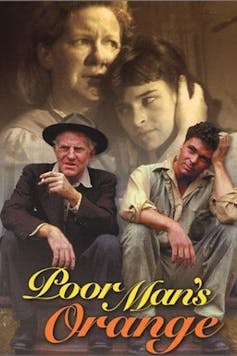
In 1987, two years after the first episodes of Neighbours introduced us to its three white families living on Ramsay Street, The Harp in the South miniseries was televised. Actor Shane Connor – who would go on to play Ramsay Street resident Joe Scully – was cast to play Charlie.
The Harp in the South has been translated into 37 languages. It is reputed never to have been out of print. Its enduring popularity is a testament to its author’s very considerable skill as a writer. Park draws on romance and other familiar genres to tell a story about Irish-Australian community in Sydney.
And in 2023, it is possible to see – threaded through the novel – a story about First Nations people, dispossession and ongoing attachment to Country.![]()
Monique Rooney, Senior lecturer in literature, film and new media, Australian National University
This article is republished from The Conversation under a Creative Commons license. Read the original article.
What is an attosecond? A physical chemist explains the tiny time scale behind Nobel Prize-winning research

A group of three researchers earned the 2023 Nobel Prize in physics for work that has revolutionized how scientists study the electron – by illuminating molecules with attosecond-long flashes of light. But how long is an attosecond, and what can these infinitesimally short pulses tell researchers about the nature of matter?
I first learned of this area of research as a graduate student in physical chemistry. My doctoral adviser’s group had a project dedicated to studying chemical reactions with attosecond pulses. Before understanding why attosecond research resulted in the most prestigious award in the sciences, it helps to understand what an attosecond pulse of light is.
How Long Is An Attosecond?
“Atto” is the scientific notation prefix that represents 10-18, which is a decimal point followed by 17 zeroes and a 1. So a flash of light lasting an attosecond, or 0.000000000000000001 of a second, is an extremely short pulse of light.
In fact, there are approximately as many attoseconds in one second as there are seconds in the age of the universe.
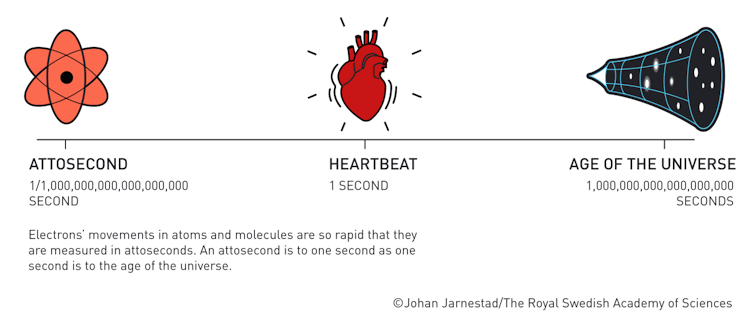
Previously, scientists could study the motion of heavier and slower-moving atomic nuclei with femtosecond (10-15) light pulses. One thousand attoseconds are in 1 femtosecond. But researchers couldn’t see movement on the electron scale until they could generate attosecond light pulses – electrons move too fast for scientists to parse exactly what they are up to at the femtosecond level.
Attosecond Pulses
The rearrangement of electrons in atoms and molecules guides a lot of processes in physics, and it underlies practically every part of chemistry. Therefore, researchers have put a lot of effort into figuring out how electrons are moving and rearranging.
However, electrons move around very rapidly in physical and chemical processes, making them difficult to study. To investigate these processes, scientists use spectroscopy, a method of examining how matter absorbs or emits light. In order to follow the electrons in real time, researchers need a pulse of light that is shorter than the time it takes for electrons to rearrange.
As an analogy, imagine a camera that could only take longer exposures, around 1 second long. Things in motion, like a person running toward the camera or a bird flying across the sky, would appear blurry in the photos taken, and it would be difficult to see exactly what was going on.
Then, imagine you use a camera with a 1 millisecond exposure. Now, motions that were previously smeared out would be nicely resolved into clear and precise snapshots. That’s how using the attosecond scale, rather than the femtosecond scale, can illuminate electron behavior.
Attosecond Research
So what kind of research questions can attosecond pulses help answer?
For one, breaking a chemical bond is a fundamental process in nature where electrons that are shared between two atoms separate out into unbound atoms. The previously shared electrons undergo ultrafast changes during this process, and attosecond pulses made it possible for researchers to follow the real-time breaking of a chemical bond.
The ability to generate attosecond pulses – the research for which three researchers earned the 2023 Nobel Prize in physics – first became possible in the early 2000s, and the field has continued to grow rapidly since. By providing shorter snapshots of atoms and molecules, attosecond spectroscopy has helped researchers understand electron behavior in single molecules, such as how electron charge migrates and how chemical bonds between atoms break.
On a larger scale, attosecond technology has also been applied to studying how electrons behave in liquid water as well as electron transfer in solid-state semiconductors. As researchers continue to improve their ability to produce attosecond light pulses, they’ll gain a deeper understanding of the basic particles that make up matter.![]()
Aaron W. Harrison, Assistant Professor of Chemistry, Austin College
This article is republished from The Conversation under a Creative Commons license. Read the original article.
Comets 101 − everything you need to know about the snow cones of space

When you hear the word comet, you might imagine a bright streak moving across the sky. You may have a family member who saw a comet before you were born, or you may have seen one yourself when comet Nishimura passed by Earth in September 2023. But what are these special celestial objects made of? Where do they come from, and why do they have such long tails?
As a planetarium director, I spend most of my time getting people excited about and interested in space. Nothing piques people’s interest in Earth’s place in the universe quite like comets. They’re unpredictable, and they often go undetected until they get close to the Sun. I still get excited when one comes into view.
What Exactly Is A Comet?
Comets are leftover material from the formation of the solar system. As the solar system formed about 4.5 billion years ago, most gas, dust, rock and metal ended up in the Sun or the planets. What did not get captured was left over as comets and asteroids.
Because comets are clumps of rock, dust, ice and the frozen forms of various gases and molecules, they’re often called “dirty snowballs” or “icy dirtballs” by astronomers. Theses clumps of ice and dirt make up what’s called the comet nucleus.

Outside the nucleus is a porous, almost fluffy layer of ice, kind of like a snow cone. This layer is surrounded by a dense crystalline crust, which forms when the comet passes near the Sun and its outer layers heat up. With a crispy outside and a fluffy inside, astronomers have compared comets to deep-fried ice cream.
Most comets are a few miles wide, and the largest known is about 85 miles wide. Because they are relatively small and dark compared with other objects in the solar system, people can’t see them unless the comet gets close to the Sun.
Pin The Tail On The Comet

As a comet moves close to the Sun, it heats up. The various frozen gases and molecules making up the comet change directly from solid ice to gas in a process called sublimation. This sublimation process releases dust particles trapped under the comet’s surface.
The dust and released gas form a cloud around the comet called a coma. This gas and dust interact with the Sun to form two different tails.
The first tail, made up of gas, is called the ion tail. The Sun’s radiation strips electrons from the gases in the coma, leaving them with a positive charge. These charged gases are called ions. Wind from the Sun then pushes these charged gas particles directly away from the Sun, forming a tail that appears blue in color. The blue color comes from large numbers of carbon monoxide ions in the tail.
The dust tail forms from the dust particles released during sublimation. These are pushed away from the Sun by pressure caused by the Sun’s light. The tail reflects the sunlight and swoops behind the comet as it moves, giving the comet’s tail a curve.
The closer a comet gets to the Sun, the longer and brighter its tail will grow. The tail can grow significantly longer than the nucleus and clock in around half a million miles long.
Where Do Comets Come From?
All comets have highly eccentric orbits. Their paths are elongated ovals with extreme trajectories that take them both very close to and very far from the Sun.
An object will orbit faster the closer it is to the Sun, as angular momentum is conserved. Think about how an ice skater spins faster when they bring their arms in closer to their body – similarly, comets speed up when they get close to the Sun. Otherwise, comets spend most of their time moving relatively slowly through the outer reaches of the solar system.
A lot of comets likely originate in a far-out region of our solar system called the Oort cloud.
The Oort cloud is predicted to be a round shell of small solar system bodies that surround the Earth’s solar system with an innermost boundary about 2,000 times farther from the Sun than Earth. For reference, Pluto is only about 40 times farther.

Comets from the Oort cloud take over 200 years to complete their orbits, a metric called the orbital period. Because of their long periods, they’re called long-period comets. Astronomers often don’t know much about these comets until they get close to the inner solar system.
Short-period comets, on the other hand, have orbital periods of less than 200 years. Halley’s comet is a famous comet that comes close to the Sun every 75 years.
While that’s a long time for a human, that’s a short period for a comet. Short-period comets generally come from the Kuiper Belt, an asteroid belt out beyond Neptune and, most famously, the home of Pluto.
There’s a subset of short-period comets that get only to about Jupiter’s orbit at their farthest point from the Sun. These have orbital periods of less than 20 years and are called Jupiter-family comets.
Comets’ time in the inner solar system is relatively short, generally on the order of weeks to months. As they approach the Sun, their tails grow and they brighten before fading on their way back to the outer solar system.
But even the short-period comets don’t come around often, and their porous interior means they can sometimes fall apart. All of this makes their behavior difficult to predict. Astronomers can track comets when they are coming toward the inner solar system and make predictions based on observations. But they never quite know if a comet will get bright enough to be seen with the naked eye as it passes Earth, or if it will fall apart and fizzle out as it enters the inner solar system.
Either way, comets will keep people looking up at the skies for years to come.![]()
Shannon Schmoll, Director of the Abrams Planetarium, Michigan State University
This article is republished from The Conversation under a Creative Commons license. Read the original article.
Unmasking Banksy – the street artist is not one man but a whole brand of people
Tyson Mitman, York St John UniversityThe graffiti artist known as Banksy might be unmasked in an upcoming defamation case over his use of Instagram to invite shoplifters to go to a Guess store because it had used his imagery without permission. The case could be seen as an attempt to force Banksy to relinquish his anonymity, which, many say, has been important to his success over the years.
There has been much speculation as to the identity of the artist and he is believed by many to be Bristol’s Robin Gunningham, who was named as a co-defendant in the defamation suit. While it has not been confirmed that Banksy is Gunningham, pointing this out is in no way a revelation. Moreover, trying to find out Banksy’s identity ultimately does not matter.
There have been many investigations into the artist’s identity and it has been the topic of serious journalistic and academic investigation for years, but no one has been able to absolutely link Gunningham and Banksy.
Short of Gunningham’s admission, complete certainty is unlikely. But if Banksy’s identity is revealed, police forces around the world could bring vandalism, property destruction, criminal mischief or worse charges against the individual.
Gunningham revealing himself would also destroy the Banksy mystique.
He is not likely to snitch on himself or damage the brand. The more important reason Gunningham being Banksy doesn’t matter is because there is no Banksy – no individual who is Banksy anyway.
A Collective
At one time, there was one Banksy who had a graffiti career and a famous “beef” in the subculture with London graffiti legend Robbo. That time is gone.
Banksy is now a collective of artists who work together to produce thoughtful, provocative and subversive pieces and installations. The scope and secrecy of Banksy’s larger works require the cooperation of many individuals to orchestrate, direct and produce them. The “bemusement park” Dismaland(a sinister take on Disneyland-style theme parks), the Walled Off Hotel (Banksy’s hotel and commentary on the Israel/Palestine conflict) in Palestine and Better Out Than In (Banksy’s New York-wide art residence) are examples of this.
Investigators believe that the collective includes many well-known and established artists. Bristol street artist John D’oh is among those rumoured to be involved, as is graffiti and street artist James AME72 Ame and perhaps even Massive Attack singer Robert Del Naja, among others. This is speculation. And again, this doesn’t matter.
What matters is why Banksy has been in the courts recently. More important than the current defamation suit is the 2021 rejection of Banksy’s trademark by the EU. This was the result of Banksy’s battle with street art greeting card producer Full Colour Black, who used Banksy’s image of a Monkey wearing a placard without permission. The ruling uses Banksy’s own words in the decision, stating:
The ruling notes that the street artist explicitly stated that the public is morally and legally free to reproduce, amend and otherwise use any copyright works forced upon them by third parties.
Also, “copyright is for losers”, as Banksy said in his own 2017 book, Wall and Piece.
The application to declare the trademark invalid was filed in 2018. Banksy took great umbrage at this. In October of 2019, he officially revealed the “homewares” brand Gross Domestic Product. The store is officially the website, but it debuted as a pop-up shop which couldn’t be entered.
A statement posted on the pop-up “storefront” declared that Gross Domestic Product was opened in direct response to the trademark cancellation filing and that selling Banksy “branded merchandise” was the best way to ensure ownership and control of the Banksy name. What’s important here is the clear interest in wanting to maintain control over what is and is not a Banksy and what Banksy artwork is associated with in commercial spaces.
A Team Of Professionals
Banksy fakes are everywhere. The artist’s popularity and the fact that the bulk of Banksy’s work is stencils – which are easily reproduced by anyone with some talent, time and an Exacto knife – ensure fakes and copies will continue to be made. To combat this, Banksy has a cohort of trusted art dealers for official Banskys and an authentication service called Pest Control that chases and legitimates the provenance of Banskys.
While it is entirely legitimate for any artist to want to maintain their unique identity and control over their artwork, it’s rare for an artist to maintain an entire staffed department dedicated to it. Not that graffiti writers don’t defend their copyrights.
Revok, Futura and Rime (to name a few) have defended their ownership of their graffiti and art in court. They hired lawyers, but they didn’t have a division dedicated to preempting and preventing infringement.
Pest Control is seemingly in place to maintain the authentic and unique perspective of Banksy’s works and to confirm they were officially produced by Banksy. This is a process often referred to as brand maintenance.
So, what’s the point of all this? Well, Banksy was an individual street artist at one point. This was probably Robin Gunningham. However, Banksy is now a collective of artists who work under the Banksy brand to produce the works that the Banksy authentication service, Pest Control, officially decrees as Banksys. Banksy is also a team of lawyers, art dealers and curators who ensure that only works officially associated with the Banksy brand get the certified Banksy seal of approval.
None of this is secret, but it’s not been publicised because being a litigious art collective equally as dedicated to producing art as engaging in brand maintenance doesn’t evoke the solo, clandestine, provocative raconteur image Banksy is going for. Having a team of lawyers making sure only real Banksys are labelled as such doesn’t do much for your street cred. Still, revealing this publicly likely won’t diminish interest in Banksy or affect the price people are willing to pay for monkey stencils or self-destroying art.

Looking for something good? Cut through the noise with a carefully curated selection of the latest releases, live events and exhibitions, straight to your inbox every fortnight, on Fridays. Sign up here.![]()
Tyson Mitman, Senior Lecturer in Sociology and Criminology, York St John University
This article is republished from The Conversation under a Creative Commons license. Read the original article.
Birkenstock goes public: how an ‘ugly’ orthopaedic shoe company created a brand worth billions
Tamsin McLaren, University of BathAsked to choose between a brown Birkenstock and a pink stiletto, most people would be able to make a fairly quick decision. In this year’s Barbie movie, Weird Barbie challenges Stereotypical Barbie to make this very choice. To Barbie, the high heel represents a life of beach fun and dance parties, while the sandal means “knowing the truth about the universe”.
That the film’s director Greta Gerwig used a Birkenstock Arizona sandal to represent the truth about life says it all about this “ugly” orthopaedic shoe.
Birkenstocks have been the footwear of choice for the “brown rice” or hippie set for decades, but this negative image has recently morphed into something very different. As comfort, climate change concerns, demand for animal-free products and affordability have become increasingly important to shoppers, Birkenstock has also been able to entice fashionistas and hippies alike to try its flexible arch supports.
As a result, financial analysts predicted the German shoe brand would be valued at more than US$8 billion (£6.5 billion) in advance of its shares becoming available to the public on the New York Stock Exchange. Birkenstock’s initial public offering will be third-largest US listing so far in 2023. Not bad for functional footwear that was originally developed to improve foot health.
A Family Footwear Business
When the Birkenstock brand was founded in 1774 in Germany by Johann Adam Birkenstock, industrial manufacturing processes in Europe were evolving. The Birkenstock family used the new technology to design and develop footwear with contoured insoles to give flexible arch support for improved foot health.
But it wasn’t until the 1920s that affluent Europeans became more aware of the benefits of such footwear, leading to exports of the shoe across Europe. By the 1960s, the company was producing sandals. The Arizona was the third style introduced by the brand in 1973, after the Madrid (1963) and the Zurich (1964).
It was at this time that Birkenstock transitioned from orthopaedic footwear into fashion, helped along by entrepreneur Robert Lusk. He identified that the counter-culture generation wanted a comfortable alternative to mainstream commercial products.
Lusk opened The Natural Shoe Store in London’s Covent Garden in 1976 to serve these customers. And while Birkenstocks didn’t appeal to the glamorous power dressers of the 1980s, by the late 1990s Lusk had started widening the brand’s appeal. He persuaded Birkenstock to make new colours of its best selling styles, the Arizona and Madrid. This departure from Birkenstock’s traditional brown hues aimed to appeal to more fashion-forward customers.

Birkenstock’s ‘Bubble Up’
Momentum continued to build behind the brand, but in the UK at the time Birkenstocks were only available from Lusk’s shop or mail-order service and a standalone Birkenstock store. As A-listers such as actor Jude Law and then-British Vogue editor Alexandra Shulman started coveting the sandals as a summer alternative to another “ugly” shoe brand – Ugg Australia – demand started to far outstrip supply.
This scarcity effect led to production in Germany being ramped up. When a brand sees a spike in distribution such as this, it can turn customers off. But, unusually, greater availability did little to dent demand for Birkenstocks and doesn’t seem to have damaged its “brand equity” in the long term either. This is the value a company derives from consumer perception of its brand. Birkenstock’s collaborations with high-end designers like Dior and Manolo Blahnik have also boosted its brand equity.
Birkenstock’s slow burn is an example of “bubble up” theory. This is the opposite of the more traditional “trickle down” phenomena, where mass market designers and brands are influenced by high-end luxury and designer fashion. Instead, brands and designers take inspiration from different aspects of society, particularly alternative sub-cultures, reinterpreting original use.
Other examples of mainstream fashion successfully borrowing from and reinterpreting subcultures and original use include Doctor Martens and Crocs. These two fashion brands also have utilitarian roots and both went public with impressive valuations: Doctor Martens at £3.7 billion in 2021 and Crocs at US$1.15 billion in 2006.
Wearing Your Values
American conservatives refer pejoratively to “Birkenstock liberals”, but the style has become associated with a universal nonchalance and quirky charm, while also representing “inconspicuous consumption” – just like other ethical shoe brands such as Allbirds.
Thorstein Veblen’s theory of conspicuous consumption suggests we use fashion to display financial wealth and status. Birkenstocks’ more accessible starting prices of £40-£65 send the reverse signal. Wearers are avoiding overt displays of wealth, instead communicating their taste via subtle branding, and knowledge about materials, form and function.
And comfort cannot be ignored. Bronislaw Malinowski, an anthropologist that explained social phenomena in terms of functional appeal, said people want functional products to satisfy some or all of these seven needs: nutrition, reproduction, bodily comforts, safety, movement, health and growth.
Functional footwear addresses most of these needs and informs some of the most iconic, and valuable, fashion brands. Other iconic footwear brands born from functional origins include Scholl – originally worn for medical purpposes – and UGG Australia, first worn by surfers to keep their feet warm.
Like many other fashionistas, Barbie chose a (pink) Birkenstock Arizona in the end, highlighting how the brand has managed to synthesise function and fashion, even in an “ugly” form. Other factors, such as the impact of persistently high inflation on consumer spending, will affect how Birkenstock fares post-IPO, but the brand has certainly put its best foot forward for its stock market debut.![]()
Tamsin McLaren, Senior Lecturer in Marketing, University of Bath
This article is republished from The Conversation under a Creative Commons license. Read the original article.
Decadence and trauma: delving into the emotional and political lives of three young Renaissance queens

Young Queens tells the entwined stories of Catherine de’ Medici, her daughter Elisabeth, Queen of Spain and her daughter-in-law, Mary, Queen of Scots. Each of these women was a different type of queen: Queen Regnant, Queen Consort and Dowager Queen.
Author Leah Redmond Chang delves into the early lives of each queen, interweaving the relational, emotional and political challenges these women encountered over the course of their lives. The book is a remarkable attempt to capture the tumultuous nature of the 16th century in Europe through the eyes of three influential queens.
Review: Young Queens: Three Renaissance Women and the Price of Power – Leah Redmond Chang (Bloomsbury)
Queenship studies has exploded in the last 30 years, as scholars rewrite master narratives to recover women’s histories, adding complexity to how we understand power in the past. Queens were not accessories but complex individuals whose actions and relationships influenced the political dynamics of royal spaces.

Throughout the medieval and early modern periods, kings and queens across Europe were mostly seen not as distinct entities but as interrelated functions of the royal family. We have come to know the lives of many queens in considerable detail, perhaps most notably, for Anglophone audiences, Elizabeth I.
Biographies of queens might now be commonplace on historical non-fiction shelves, but Redmond Chang’s decision to write an interconnected biography offers a breath of fresh air to the genre. In particular, the focus on the youth and emotional worlds of three famous queens invites the reader to immerse themselves in the decadent yet often traumatising spaces of their adolescence and adult lives.
Novelist L P Hartley once wrote, “The past is a foreign country; they do things differently there,” and this has often led to a certain distance between modern readers and historical subjects. Redmond Chang’s tender treatment of each queen ensures the reader is conscious of the humanity of her protagonists, albeit with occasional modernisms that distract an expert eye.
Catherine de’ Medici is the driving force throughout the book. Young Queens opens with the gripping account of her seizure by Florentine lawmakers while ensconced in the Benedictine convent of Le Murate at the age of eleven in 1530. As the lone descendant of statesman and banker Lorenzo de’ Medici, she represented a threat to the incumbent regime.
Redmond Chang writes the episode through Catherine’s eyes, drawing on a later account recorded by one of the convent’s nuns. She charts Catherine’s early adulthood in much the same fashion, inviting the reader to step into the shoes of a frightened yet resilient young woman who ultimately became the Queen of France when she married Henry II at the age of 14.

The decadent descriptions of 16th-century chateaux interspersed with political intrigue and fleeting intimacies make for a rich narrative tapestry. The arrival of Mary, Queen of Scots, (who married the dauphin, Francis, in 1548) and the quiet tension between Catherine and her husband’s mistress Diane de Poitiers is captured well. As is Catherine’s tenure as “Queen Mother,” a title she assigned herself, in 1549 – arguably the period from which much of her infamy is derived.
Catherine de’ Medici has a number of dark legends associated with her rule, reflecting her alleged manipulative and ruthless nature. She has been accused of having a “flying squadron” of attractive women who seduced courtiers to achieve her political goals and practising witchcraft. She has also been accused of masterminding the Bartholomew’s Day massacre of 1572, which resulted in the deaths of thousands of Huguenots (French Protestants).
Redmond Chang is not the first to write from the perspective of Catherine de’ Medici, but the focus on the queen’s early life is welcome.
Mary, Queen Of Scots
Mary, Queen of Scots, arrived at the French court a decade after Catherine. One year after her marriage, Francis became King and Mary, Queen of France. However, Francis’s reign was brief and he died in 1560. Mary returned to Scotland shortly afterwards and her later life is recounted by Redmond Chang.

At times, there are some repetitive and chronological jumps that make the narrative difficult to follow. Moreover, readers well accustomed with Mary’s story will find some narrative choices curious, particularly the acceptance of the veracity of the Casket Letters. These letters were a 1567 collection of self-incriminating letters allegedly written by Mary that discussed a plot to murder her second husband, Lord Darnley.
But, overall, the decision to situate Mary in relation to her French heritage (her mother was a member of the Guise dynasty who came to prominence during the French Wars of Religion of 1562-1598) offers a new perspective to readers more accustomed with Mary’s fight for survival in Tudor England. Mary had a legitimate claim to the English throne and was locked in a battle with Elizabeth I for the remainder of her life while also defending herself from Scottish lords who opposed her rule in Scotland.
Elisabeth, A Bride At 14
Finally, Elisabeth of Valois, Queen of Spain, enters the fold as a childhood companion of Mary and pawn in her mother Catherine de’ Medici’s politics. Following the conclusion of the Italian Wars (between 1494-1559) Catherine de’ Medici and Philip II, king of Spain, agreed to unite their houses in the Peace of Cateau-Cambrésis in 1559.
Aged just 14, Elisabeth became Philip II’s third wife in the same year. Despite the two-decade age gap, the marriage appeared to be relatively happy. Redmond Chang’s retelling of Elisabeth’s few years in Spain are compelling and the reader is left wanting more.

Elisabeth’s life was “tightly controlled” compared to the French court. Her days were spent following a strict protocol in the Spanish fashion: outings were orchestrated “from the ornamentation on the horses’ saddles down to the rank and file of litters, ladies and lackeys.” Elisabeth enjoyed art and writing to her mother, who maintained a voluminous correspondence with her daughter.
Closely observed for signs of pregnancy, her various ailments alarmed those around her. Eventually she gave birth to two daughters but the labours of childbirth were too much for her frail body. Sadly, Elisabeth died only a decade into her marriage.
Again, here, there are some instances of chronological confusion. However, the sensitive attention paid to Elisabeth’s string of miscarriages and difficult births is engaging and provides the reader with a gripping depiction of the extremely challenging lives of early modern women.
Even the Queen of Spain, with all of the wealth of the New World, could not escape the gruelling nature of childbirth in the 16th century.
Blurring History And Fiction
Young Queens excels when the reader is immersed in the rich relationship dynamics of women at this time. Unlike their menfolk, elite women moved between different houses, which usually involved learning new languages and cultures. Often, marriages were pragmatic and young wives must have felt isolated and lonely in a foreign land.
There were, of course, exceptions, as the three protagonists of Young Queens illustrate. Catherine’s own experiences perhaps led her to insulate her young children and daughter-in-law against the loneliness of her childhood. Catherine housed them together in a separate chateau, where they had each other’s company and the supervision of tutors.
Redmond Chang situates each woman at the centre of their own stories rather than as supporting characters in the careers of their husbands.
Yet, her commitment to vivid storytelling occasionally leads to some rhetorical devices that blur the line between history and fiction. A comment that Catherine’s union with Henri II was “the strangest marriage” on account of the presence of Diane de Poitiers veers towards the bombastic as many noble marriages were often crowded. (De Poitiers was 20 years’ Henri II senior and his mistress for close to 25 years).
The commitment to modernisms, for example, a comment that “boys will be boys” in relation to Francis’s penchant for sports, can be jarring for the expert reader, but is a small price to pay to open up a fascinating and engaging series of entwined stories to a wider audience.
In the epilogue, Redmond Chang briefly summarises two events that have preoccupied scholars of Mary and Catherine for centuries: the Babington Plot (a 1586 conspiracy to kill Elizabeth I and replace her with Mary, Queen of Scots) and the St Bartholomew’s Day massacre. Perhaps this was a deliberate decision to steer attention towards the queens themselves, rather than the narratives that made them infamous.
Admittedly, the book is titled Young Queens and so such quibbles about their later lives may be unwarranted. Indeed, while Catherine lived to the age of 70, Mary and Elisabeth only survived to the ages of 45 and 23, respectively.![]()
Jessica O'Leary, Research Fellow, Gender and Women's History Research Centre, Australian Catholic University
This article is republished from The Conversation under a Creative Commons license. Read the original article.
Cost A Barrier To Healthcare For Older Australians
- Mental health care, dental treatment and dental checkups were the most likely to be forgone, with 20%-26% of respondents unable to afford them on one or more occasion.
- Prescription medication and GP appointments were the least likely to be skipped because of cost, but even they were unaffordable for 5%-7% of older people.
- On top of these numbers, for every form of healthcare the survey enquired about another 21%-33% of people hesitated over the cost.
From The Pages Of The Past: Hmmm?
$600,000 In Grant Funding To Keep Seniors Connected
- Category 1: Creation grants for new projects, with $20,000 awarded to 5 innovative projects with an overall value of $100,000.
- Category 2: Enhancement and/or expansion grants for existing projects, with $30,000 each for 10 different organisations with an overall value of $300,000.
- Category 3: Local council grants for local council projects, with $40,000 each for 5 different councils with an overall value of $200,000.
Seaside Stories: Dementia And Reminiscence
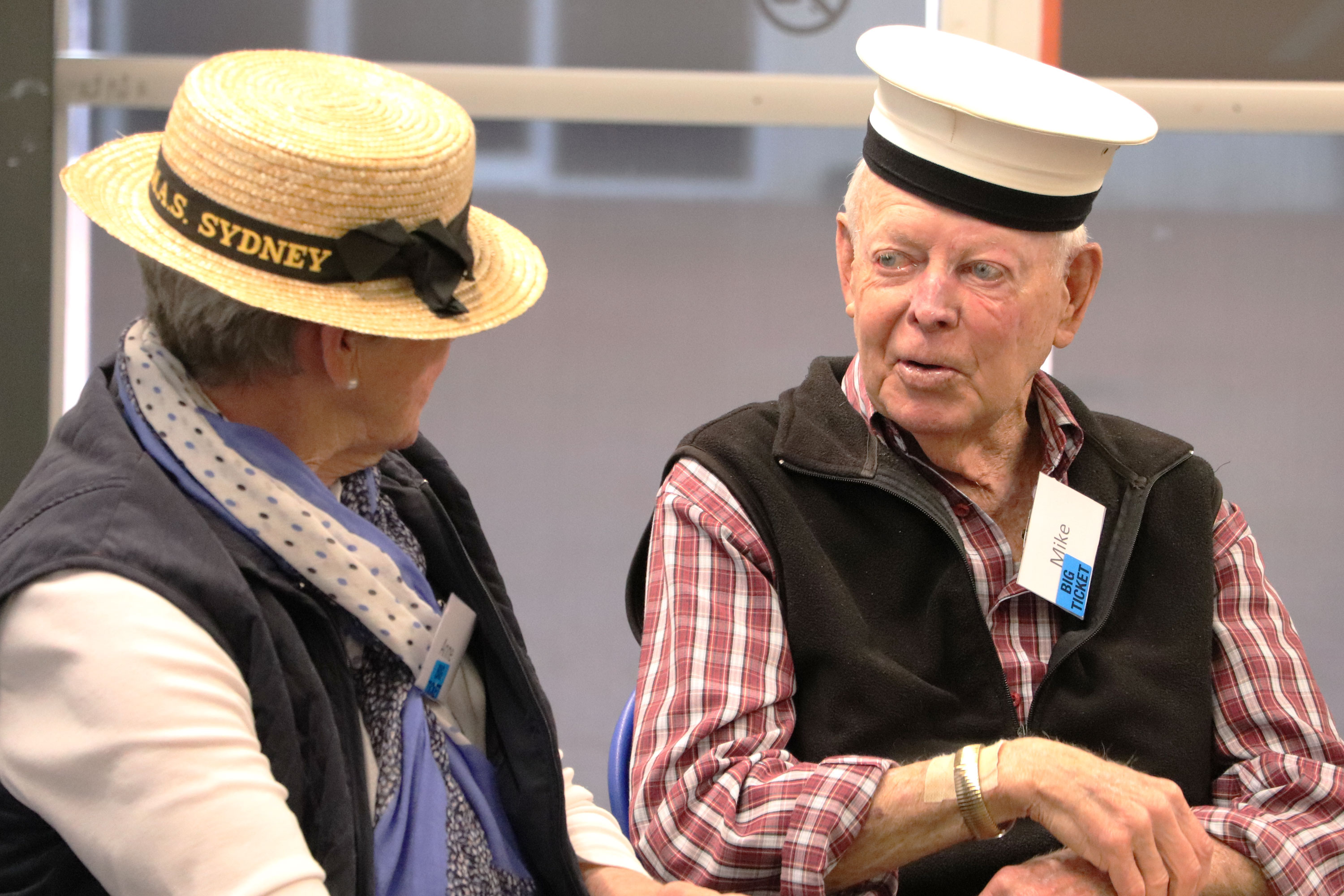
Bones play an important role in our health – here’s how to keep them strong

Just as our muscles lose strength as we get older, so do our bones. This can have a serious effect on our lifestyle, and boosts risk of fractures – which are linked with an increased risk of death. Fortunately, just as we can build the strength in our muscles, we can build strength in our bones.
Bones are far more than a simple scaffold within our bodies. Bone is a complex organ which comes in a multitude of shapes and sizes. It’s made up of a diverse mixture of organic and inorganic components – such as collagen and calcium. Combined together, these components create a structure that’s malleable enough that muscle can pull against it so we can move, while simultaneously being strong enough to protect critical organs.
Bone is not the solid, immovable, permanent structure that many might assume it to be. Healthy, living bone remains strong because it’s constantly being turned over, with old and damaged bone being excavated out and replaced with fresh bone.
This internal quality control sees our skeleton being replaced approximately every ten years in healthy people – though this is slower in people who are older or sick. Certain health conditions can also cause excessive bone loss – such as cancer and hormonal changes during the menopause.
Unlike many other tissues, such as cartilage, tendon and muscle – where only a small number of different cell types occur – bone is comprised of a multitude of different cells. These include bone cells, immune cells, fat cells, nerve cells and blood cells, to name a few.
The combined action of these cell types help our body maintain adequate bone volume throughout life, so we can continue to be active.
Specialised bone cells (called osteoblasts and osteoclasts) help modify our bones to repair damage and increase volume depending on the demands placed on them. So a tennis player who repeatedly serves with the same arm will have higher bone volume in their serving arm as a result.
Looking After Your Bones
Maintaining your bones throughout life is essential for good health and wellbeing. A sudden loss in mobility as a result of fracture has considerable knock-on effects to lifestyle – where walking around the shops, visiting friends and performing even the smallest daily tasks around the house can be painful.
Bone density (strength) can be preserved no matter your age with good diet and exercise.

A balanced diet rich in calcium (a crucial mineral within your bone) is recommended. Aim to consume 700mg a day. Milk, yoghurt and cheese are all great sources of calcium. If you’re vegan, foods such as tofu, beans and lentils all contain calcium. You may need to take a supplement if you aren’t able to get the recommended amount of calcium in your diet.
Importantly, our bodies need vitamin D to fully absorb calcium, so spending time outside is key as our skin makes vitamin D when exposed to the sun. Try to get up to ten minutes twice a day. In the winter, when there tends to be less sunlight, you may want to consider a vitamin D supplement.
Exercise is another way you can keep bones strong – specifically weight-bearing exercises. Walking and climbing the stairs are great options to begin with if you don’t regularly exercise. But more rigorous activities – such as jumping rope or weight training – are better, as they stimulate more bone growth. This is because when the muscles pull hard on the attached bone, it stimulates growth.
These kinds of exercises can be done by anyone of any age. Just be sure to adapt the exercise you do to your fitness level and ability. It’s also recommended you gradually build up the amount you exercise to avoid injury.
Reducing pollutants in your body (such as smoking and alcohol) will also help give your bone cells the best chance of working properly throughout life.
If you’re concerned about how strong your bones are – or if you have certain health conditions that may decrease your bone mineral density (such as coeliac disease, inflammatory bowel disease, diabetes and cancer) – you can always speak to your GP about your concerns. They will be able to give you personalised advice on the best ways of looking after your bones.![]()
James Edwards, Associate Professor of the Oxford Skeletal Ageing and Regeneration Group, University of Oxford
This article is republished from The Conversation under a Creative Commons license. Read the original article.
New Campaign Shines A Spotlight On Safe Drinking This Summer
- Don’t accept drinks from others. Always buy your own and watch it get made. Never leave your drink unattended and avoid batch drinks like punches that may have unknown ingredients and alcohol content.
- Pace yourself. Count your drinks, try a low-alcohol alternative, or have a ‘spacer’ of water between alcoholic drinks. Don't let people continually top up your drink, as it’s hard to keep track of your alcohol consumption and be aware that different drinks have different strengths. Set a timer on your phone to help you pace your drinks.
- Avoid shouts, drinking games or shots. Drink at your own pace, you don’t have to join in every round and consider buying a non-alcoholic drink when it's your turn. Don't be pressured into drinking more than you want or intend to.
- Eat before or while you are drinking. If you have a full stomach, alcohol will be absorbed more slowly. Avoid salty snacks, as these make you drink more.
- Stay busy. If you have something to do, you tend to drink less, so have a game of pool or hit the dance floor.
- Trust your feelings and instincts. If you feel unsafe, uncomfortable, or worried for any reason, try to get somewhere safe and find someone you trust who can help you, like a friend, bar staff, security or police. You won’t get in trouble.
- Have a ‘plan B’. Plans change quickly, ensure you have multiple options to get home safely. Remember you may still be over the limit the next morning.
- Always tell your mates where you’re going. Let someone know which venue you’re drinking at. If you go to another location, particularly with someone you don’t know well, send the address to a trusted friend. If you decide to go home early, leave the group or even just go to the bathroom, let your mates know.
- Keep an eye on your mates! If you are going out in a group, plan to arrive together and leave together. Never leave a friend who's been drinking on their own. If you’re at a party, check in with them during the night to see how they’re doing. If something doesn’t look right, let a friend know you are uncomfortable or worried about their safety.
- Sometimes sticking together isn't enough, you need to recognise when you might need to call for help.
- Consent and boundaries. Alcohol can lower your inhibitions. Be aware of this and set boundaries for yourself before going out. Remember if someone seems drunk, they probably can’t consent. Instead, trade numbers.
- Drink spiking. Many drugs and alcohol used to spike drinks are tasteless. If there’s a change in your drink’s flavour or if it tastes or smells stronger than what you were expecting, get rid of it and let a trusted person know. Know the signs and symptoms of drink spiking: feeling dizzy, faint, ill, sleepy, incoherent, confused or drunk even though you’ve consumed a small amount of alcohol. If you experience these, let someone know. If you see a friend experiencing these symptoms, check in and stay with them until they recover. Call TripleZero (000) in an emergency.
Police Given Power To Issue On-The-Spot Fines With Health Intervention For Small Quantity Drug Possession
- Drug supply, dealing or trafficking; or
- Drug production or manufacture; or
- Previously convicted drug dealers; or
- People who have large quantities of drugs; or
- People who have already received two Criminal Infringement Notices for drug possession offences.
Be Prepared For The Asthma Season
- if you have ever been diagnosed with asthma or have hay fever, ensuring you have an up-to-date action plan in place, including how you should manage your symptoms if you experience a flare-up due to bushfire smoke or pollen
- if your child has asthma, providing any updated asthma action plans to your child's preschool, childcare centre or school
- checking that your and/or your child's asthma reliever medication and spacer is up-to-date and stored in an easy spot for you or a responsible adult to get quickly
- if you have hay fever or asthma, knowing the warning signs of asthma like wheezing, breathlessness, feeling tight in the chest or persistent cough and when to seek advice from your doctor or urgent emergency care
- during times of high pollen, bushfire smoke or thunderstorms, where possible remaining inside and keeping windows and doors closed.
Ministerial Advisory Panel To Focus On Regional Health
- Dr Richard Colbran (Chair) – Sydney Dr Colbran is Chief Executive Officer of the NSW Rural Doctors Network. He is an experienced executive officer of not-for-profit (NFP) and charity organisations that specialise in health and social services and an advocate for social leadership.
- Mrs Anna Barwick – Walcha Mrs Barwick is a practising pharmacist, diabetes educator, asthma educator researcher and pharmacist immuniser. She was the Pharmaceutical Society of Australia 2021 NSW Pharmacist of the Year, the 2022 NSW Premier's Woman of the Year.
- Ms Karen Booth – Sydney Ms Booth is the President of the Australian Primary Health Care Nurses Association. She is a Registered Nurse working as a primary healthcare nurse and manager in general practice for 25 years. She has held multiple ministerial appointments to federal government health policy groups.
- Mrs Christine Corby AM – Walgett Mrs Corby is the Chief Executive Officer of Walgett Aboriginal Medical Service and Brewarrina Aboriginal Medical Service. In these roles she is responsible for the day to day staff management, service delivery and the development of future programs.
- Cr Rick Firman OAM – Temora Cr Firman has a passion for rural and regional health. Having been in local government for 19 years, as Mayor of Temora since 2012, he has immersed himself in enhancing local health services from a Council perspective and as chair of the Temora Local Health Advisory Committee.
- Ms Kelly Foran – Glen Innes Ms Foran is founder and Chief Executive Officer of the Friendly Faces Helping Hands Foundation and Community Innovation Coordinator (Glen Innes and Tenterfield) for Hunter New England Health. She sits on a number of boards and is involved with community consultation.
- Mrs Louise Fox – Goulburn Mrs Fox has 18 years’ experience working in regional and rural health with a background in Allied Health. She is the District Director – Integrated Care and Allied Health for Southern NSW Local Health District.
- Ms Laura Hand-Ross – Deniliquin Ms Hand-Ross has 14 years’ experience working in the Mental Health Drug and Alcohol landscape across several levels of management and clinical leadership. She is the Aboriginal Coordinator – Toward Zero Suicides and Mental Health Drug and Alcohol for Murrumbidgee Local Health District.
- Prof Jennifer May AM – Tamworth Prof May is a practising rural clinician who has worked in rural general practice in remote, rural and regional locations. She works as a GP VMO at Tamworth and Tamara Hospitals and is the current Director University of Newcastle Dept of Rural Health.
- Ms Shana Quayle – Dapto Ms Quayle is the Acting Chief Executive Officer of the Aboriginal Health and Medical Research Council of NSW. She has held various policy and program management positions with AH&MRC.
Builder Appointed For $53 Million Gunnedah Hospital Redevelopment

Millions Of Dollars To Be Saved With Reform To Delivery Of Out-Of-Hospital Care: AMA
 Millions of dollars can be saved, and tens of thousands of hospital beds freed up, if more out-of-hospital care is delivered in Australia’s private health system.
Millions of dollars can be saved, and tens of thousands of hospital beds freed up, if more out-of-hospital care is delivered in Australia’s private health system.How should I add sunscreen to my skincare routine now it’s getting hotter?

Sun exposure is the number one cause of skin cancer – including the most deadly form, melanoma. High levels of sun exposure cause an estimated 7,200 melanomas in Australia each year.
Too much sun exposure can also lead to premature ageing, resulting in wrinkles, fine lines and age spots.
Can a tweak to your skincare routine help prevent this?
When Should I Start Wearing Sunscreen?
In Australia, we are advised to wear sunscreen on days when the ultraviolet (UV) index reaches three or higher. That’s year-round for much of Australia. The weather forecast or the Cancer Council’s free SunSmart app are easy ways to check the UV Index.
Besides “primary sunscreens”, which are dedicated sun-protection products, a sun protection factor (SPF) is also found in many beauty products, such as foundations, powders and moisturisers. These are called “secondary sunscreens” because they have a primary purpose other than sun protection.
Primary sunscreens are regulated by the Therapeutic Goods Administration and the SPF must be determined by testing on human skin. SPF measures how quickly skin burns with and without the sunscreen under intense UV light. If the skin takes ten seconds to burn with no sunscreen, and 300 seconds to burn with the sunscreen, the SPF is 30 (300 divided by 10).
Is The SPF In Makeup Or Moisturisers Enough To Protect Me The Whole Day?
Simple answer? No. SPF 30 mixed into foundation is not going to be as effective as a primary SPF 30 sunscreen.
Also, when people use a moisturiser or makeup that includes SPF, they generally don’t do the three key steps that make sunscreens effective:
- putting a thick enough amount on
- covering all sun exposed areas
- reapplying regularly when outdoors for a sustained amount of time.
One study had 39 participants apply their usual SPF makeup/moisturisers and photographed them with UV photography in the morning, then again in the afternoon, without reapplying during the day. The UV photography allowed the researchers to visualise how much protection these products were still providing.
They found participants missed some facial areas with the initial application and the SPF products provided less coverage by the afternoon.

Another consideration is the product type. Liquid foundation may be applied more thickly than powder makeup, which is generally lightly applied.
The Therapeutic Goods Administration tests primary sunscreens so they’re effective when applied at 2mg per 2 square centimetres of skin.
For the face, ears and neck, this is about one teaspoon (5mL) – are you applying that much powder?
It’s unlikely people will cake on their moisturiser thickly and reapply during the day, so these products aren’t effective sun protection if outdoors for a sustained amount of time when used alone.
If Skin Products With SPF Aren’t Giving Me Better Protection, Should I Stop Using Them?
These products can still serve a protective purpose, as some research suggests layering sunscreen and makeup products may help to cover areas that were missed during a single application.
When layering, SPF factors are not additive. If wearing an SPF 30 sunscreen and makeup with SPF 15, that doesn’t equal SPF 45. You will be getting the protection from the highest product (in this scenario, it’s the SPF 30).
A good metaphor is SPF in makeup is like “icing on the cake”. Use it as an add-on and if areas were missed with the initial sunscreen application, then there is another chance to cover all areas with the SPF makeup.
Should I Apply Sunscreen Before Or After Makeup?
It depends on whether you’re using a chemical or physical sunscreen. Chemical sunscreens need to absorb into the skin to block and absorb the sun’s rays, whereas physical sunscreens sit on the surface of the skin and act as a shield.
When the main ingredient is zinc oxide or titanium dioxide, it’s a physical sunscreen – think the classic zinc sticks you used to apply to your nose and lips at the beach. Physical sunscreens are recommended for people with sensitive skin and although they used to be pretty thick and sticky, newer versions feel more like chemical sunscreens.
For maximum sun protection when using chemical sunscreens, apply sunscreen first, followed by moisturiser, then makeup. Give the sunscreen a few minutes to dry and sink into the skin before starting to put on other products. Chemical sunscreen should be applied 20 minutes before going outdoors.

When using a physical sunscreen, first apply moisturisers, followed by sunscreen, and then makeup.
When reapplying sunscreen, it’s recommended to wash off makeup and start fresh, but this isn’t going to be practical for many people, so gently patting sunscreen over makeup is another option. Physical sunscreens will be most effective for reapplication over makeup.
What Type Of Sunscreen Should I Use?
The best sunscreen is the one you actually like to apply. Protecting your skin on a daily basis (and not just for trips to the beach!) is a must in Australia’s high UV climate, and should be done with a primary sunscreen.
Look for sunscreens that have the label “broad spectrum”, which means it covers for UVA and UVB, and has at least SPF30.
Then experiment with features like matte finish, milk texture or fragrance-free to find a sunscreen you like.
No sunscreen provides 100% protection so you should also use other sun protection such as protective clothing, hats, sunglasses, using shade and avoiding the sun during peak UV hours.
Skin care and makeup products with SPF is better than nothing, but don’t rely solely on your morning makeup for sun protection the entire day.![]()
Monika Janda, Professor in Behavioural Science, The University of Queensland; Caitlin Horsham, Research Manager, The University of Queensland, and Katie Lee, PhD Candidate, The University of Queensland
This article is republished from The Conversation under a Creative Commons license. Read the original article.
Innovative Vaccination Strategies Save Lives: AMA NSW

Sidelined no longer, Claudia Goldin wins the 2023 Nobel Prize in Economics for examining why gender pay gaps persist
Leonora Risse, RMIT UniversityIn an astonishing act of timing, Harvard University’s Professor Claudia Goldin published a paper on Monday titled Why Women Won. It mapped milestone moments in women’s rights in the United States from 1905 to 2023.
A few hours later, she was awarded the 2023 Nobel Prize in Economics “for having advanced our understanding of women’s labour market outcomes”.
Goldin became only the third woman to win the Nobel Memorial Prize in Economic Sciences, and the first to win it in her own right, not sharing it with a man.
For countless women in economics, and for advocates of gender equality more broadly, her recognition adds to the milestone moments she has documented in her own work.
Decades of research have seen Goldin methodically collate data and archival stories, detective style, to uncover explanations for the rise and fall (and rise again) of women’s paid employment over the centuries, including:
the empowering effect of the contraceptive pill
the removal of legal restrictions on the employment of married women
the influx of women into higher education
the shift towards a services economy.
Uncovering reasons for the gender gaps that remain, Goldin has scrutinised contemporary work culture to identify the unhealthy phenomenon of “greedy work” in which employers demand excessive hours and 24/7 availability.
This creates a gender divide by penalising those workers – predominantly women – whose caregiving role collides with excessive employer expectations.
A practical takeaway from Goldin’s research is that gender gaps in economic outcomes can’t be merely attributed to women’s “choices” or “preferences”.
Her comprehensive account of women’s experiences shows these gender gaps arise from an interplay of wider factors; among them, societal norms, technological breakthroughs, institutional structures, and policy settings that push or pull women’s workforce participation in different directions.
Why Goldin’s Nobel Matters
These insights are critical for policymakers, as they point to the need to improve systems and cultures, rather than placing the onus on individual women to change their behaviour.
This recognition is also a validation of Goldin’s style of research.
The Economics Nobel prize is not usually awarded for the generation of new knowledge, but instead prioritises new theoretical and conceptual methods.
Goldin contributes both new insights and innovative methods through her investigation style, where she combs through historical archives and pays attention to the personal stories of women in order to make sense of the data.
Lived experiences and personal stories are often squeezed out of science. Goldin’s work affirms that economics – as a social science – requires them.
It Also Matters To Economics Itself
Goldin’s research carries important implications for addressing gender equality within the economics profession.
Economics has a longstanding history as a male-dominated discipline.
Despite improvements in recent years, women are still underrepresented in economics and a growing body of evidence shows that gender bias persists.
The research questions that Goldin has dedicated her career to are topics that have long been sidelined in mainstream economics, labelled by many in the profession as “special interest” topics not to be taken seriously.
In my earlier review of Goldin’s book, Career and Family : Women’s Century-Long Journey Toward Equity, I reflect on the importance of Goldin’s pioneering role for gender equality researchers like myself:
“As an economist who also researches gender equality issues – and is similarly motivated by the simple quest to better understand the reasons why we see such stark gender disparities in our economy – I find myself often confronted by accusations that my research is subjectively motivated by an ideological agenda; accusations designed to denigrate its value and question my research integrity.
"I am aware that other researchers in the field of gender equality, particularly women, encounter these disparaging blights on their professionalism too.
"The rich wealth of research and insights that Goldin has contributed to the economics profession throughout her career – arguably worthy of Nobel recognition – affirms that this stream of work is important.”
Goldin’s contribution extends beyond her academic papers.
In her role as President of the American Economic Association in 2013, Goldin put in place initiatives to more fully understand women’s low numbers in economics and to support more to join and stay in the field.
She did not merely research gender inequity from afar – she recognised where it prevailed within her own discipline and (as would be expected of an economist) took evidence-based action to address it.
While we have not yet achieved gender equity, awarding the Nobel to a female economist for dedicating her career to understanding gender inequity – and helping to solve it – counts as a win for women in economics.![]()
Leonora Risse, Senior Lecturer in Economics, RMIT University
This article is republished from The Conversation under a Creative Commons license. Read the original article.
Does your employer have to tell if they’re spying on you through your work computer?

The COVID pandemic stimulated an irreversible shift in where, when and how we work. This 21st-century model of working – dubbed the “new normal” – is characterised by increased flexibility and productivity gains.
Yet this reshaping of work, underpinned by technology, has also eroded our work-life boundaries – and persisting 20th-century attitudes are preventing us from successfully managing the new normal.
We find ourselves struggling with “productivity paranoia”: a term used to describe managers’ concerns that remote and hybrid workers aren’t doing enough when not under supervision.
As a result, we’re seeing a surge in the use of electronic monitoring and surveillance devices in the workplace. These devices allow managers to “watch over” employees in their absence. This practice raises serious legal and ethical concerns.
Big Bossware Is Here
In a survey of 20,000 people across 11 countries, Microsoft reported 85% of managers struggled to trust their remote-working employees. In Australia, this figure was 90%.
In 2021, American research and consulting firm Gartner estimated the number of large firms tracking, monitoring and surveilling their workers had doubled to 60% since the start of the pandemic.
Electronic monitoring and surveillance technology can capture screenshots of an employee’s computer, record their keystrokes and mouse movements, and even activate their webcam or microphones.
On one hand, these “bossware” tools can be used to capture employee and production statistics, providing businesses with useful evidence-based analytics.
The other side is much darker. These devices are indiscriminate. If you’re working from home they can pick up audio and visual images of your private life.
Managers can be sent notifications when data “indicate” an employee is taking breaks or getting distracted.
Some aspects of electronic monitoring and surveillance are legitimate. For instance, it may be necessary to safeguard an organisation’s data access and transfers.
But where are the boundaries? Is your organisation legally obliged to tell you about electronic intrusions? Alternatively, what can you do if you find out you’re being watched without being informed?
The Legal Framework
A complex array of regulation governs workplace privacy and surveillance in Australia. Proposed reforms to the Privacy Act 1988 are set to strengthen privacy protections for private-sector employees.
However, this legislation doesn’t specifically cover workplace surveillance. Instead, a patchwork of laws in each state and territory regulate this matter.
Specific legislation regulates the surveillance of workers in New South Wales and the Australian Capital Territory. Importantly, surveillance must not be undertaken unless the employer has provided at least 14 days’ notice. This notice must include specific details about the surveillance that will be carried out. Employers must also develop and adhere to a surveillance policy.
In both states, employers can only record visual images of an employee while they’re “at work”. This is broadly defined to capture any place where work is carried out.
Covert surveillance is prohibited unless the employer has obtained a court order. In this case it’s restricted to situations where the employee is suspected of unlawful activity.
Even then, a covert surveillance order would not be granted where this unduly intrudes on the employee’s privacy. Covert surveillance for the purpose of monitoring work performance is expressly prohibited.
Other states and territories don’t have specific electronic workplace surveillance laws. Employers must instead comply with more general surveillance legislation.
Broadly speaking, employees must give consent, express or implied, to any surveillance. In practice, such consent is usually obtained through the implementation of a workplace surveillance policy, which employees must agree to when they accept the job. So if you’ve signed a contract without reading the fine print, you may have agreed to being surveilled via electronic monitoring tools.
Currently, Queensland and Tasmania provide the most limited protection for employees. Their surveillance legislation is limited to the regulation of listening devices.
Enterprise agreements, employment contracts and workplace policies may also limit or prohibit the use of surveillance devices. In practice, however, most employees will lack the bargaining power to negotiate the inclusion of any such terms in their employment contract.
The Law Is Failing To Keep Up
In 2022, a parliamentary select committee reporting on the future of work in NSW observed the current regulatory framework is failing to keep pace with rapid advancements in electronic monitoring and surveillance.
The report criticised legislation that simply allows an employer to notify workers surveillance will be carried out, with no mechanism for this to be negotiated or challenged. The situation is slightly better in the ACT, where employers must consult with workers in good faith about any proposed surveillance activities.
Workers who suspect their employer is spying on them should review their workplace surveillance policies. They may need to reflect carefully on how they use their work computer.
Where an enterprise agreement applies, the Fair Work Commission can arbitrate surveillance disputes. A worker who is dismissed following intrusive surveillance may be able to challenge the dismissal on the basis of it being unfair.
Workers who haven’t been informed of their employer’s surveillance practices can also lodge a complaint with the relevant authority or regulator, who may have powers to investigate and prosecute offences.
To thrive in our “new normal” work landscape, we’ll need to address the gap between the existing legal protections and the capabilities (and potential harms) of electronic monitoring and surveillance. For now, it remains a significant legal and ethical challenge. ![]()
Jacqueline Meredith, Lecturer in Law, Swinburne University of Technology and Peter Holland, Professor in Human Resource Management and Employee Relations, Swinburne University of Technology
This article is republished from The Conversation under a Creative Commons license. Read the original article.
‘I can’t argue away the shame’: frontier violence and family history converge in David Marr’s harrowing and important new book

Cultural capital is a rare and precious commodity. It is earned by doing – with wit, rigour and imagination. Being born to privilege may help in its accumulation, but that is not sufficient. These days, especially, privilege can be an impediment.
The advantages of David Marr’s birth proved more complicated than they first seemed, but attuned him to hypocrisy and made him a better observer. For five decades, he has honed his skills as an eloquent writer, dogged researcher and witty interlocutor with a strong moral core.
As a journalist and author of acclaimed biographies of Sir Garfield Barwick and Patrick White, he has become a trusted guide in the endless quest for public sense-making. His journey from a privileged son of upper middle class Sydney to wise national witness is captured in the 567 pages of My Country, the compelling collection of a “few” of his speeches and articles.
Over a lifetime, Marr has earned a fortune in cultural capital. He has now decided to spend some of it.
Review: Killing for Country – David Marr (Black Inc.)
The release of his harrowing and important book Killing for Country was timed to influence the nation-defining referendum on October 14. Four years ago Marr discovered another complication of his privilege: his forebears’ role in murdering scores of First Peoples during the land grabs that preceded the creation of Australia.

When Marr learned of this history, it was as though he had stepped into quicksand. Killing for Country is not the generic “why weren’t we told?” cry that has echoed around the continent for decades, and still resonates, but something personal. And as Marr discovered over years of painstaking research, the truth was much more brutal than he could have imagined. “I can’t argue away the shame that overcame me,” he writes.
Like most Australians of his generation, Marr grew up in a family and a nation that were good at secrets. Making your own life was a virtue, curiosity about those who came before was neither encouraged nor rewarded. In this, as he writes, “my blindness was so Australian”.
The killings that soaked the Great South Land with blood were documented in official memoranda tied with ribbon and shipped back to London, reported extensively in the press, and described in diaries and letters. They were the subject of periodic court cases and public inquiries.
Yet these records were persistently ignored. Many were destroyed. The public inquiries were rarely acted upon. Diligent historians like Noel Loos, Henry Reynolds and Raymond Evans were undertaking important work, scrolling through old newspapers in obscure country towns, but for most such a task was impossibly daunting. As a result, the trail died with time.
Crucially, many of the descendants of those First Peoples who survived and remembered often also chose to try to forget. The weight of the horror was too great.
This was perfect terrain for the myth of a dying race to take root and flower. And so it did. The newly minted Australians of the 20th century convinced themselves the killings that had once filled the pages of newspapers, and even became the subject of bestselling novels, were either necessary or not that bad, really. A poem that featured in many newspapers a decade before Federation included the lines:
We have no record of a bygone shame
No red-writ histories of woe to weep.
At the time, the killings in northern Australia were ferocious.
Secrecy and denial were baked into the founding of the nation, from the shame of convict origins to the violence of settlement. Australia was shaped with bloodshed and trauma.
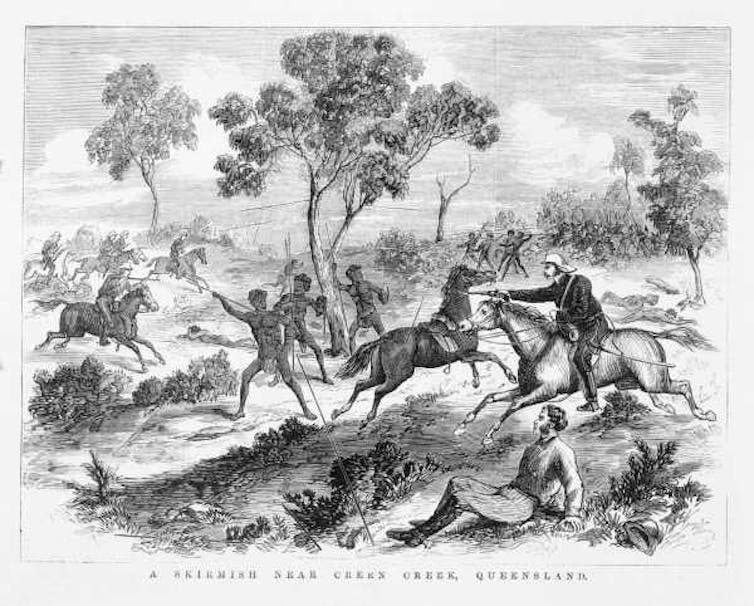
Historical Quicksand
Marr found himself sinking into the historical quicksand of the violent reality after he tried to answer a question from an elderly uncle about his great grandmother Maud. There seemed to be a connection to the Queensland Native Police, and Jim Graham turned to his brilliant nephew to learn more. It seemed that Maud’s father Reg Uhr and his brother D’arcy had been vigilant members of the force. That fact was in Wikipedia, but there was much more to learn.
As Marr soon discovered, the scale and details were mind boggling.
The Blackfella Films series The Australian Wars for SBS brought some of this to our screens last year and is now finding global audiences, scooping national and international awards. The violence of the Queensland frontier was even more vicious and protracted than in Tasmania. Native Police had first been used in New South Wales, but the unprecedented violence in Queensland was applied across northern Australia
In the last decade, scholars including Raymond Evans, Robert Orsted-Jensen, Jonathan Richards, Heather Burke, Lynley Wallis, Timothy Bottoms and others, have reassessed the number of lives lost.
The 442 officers and 927 troopers of the Queensland Native Police are now considered responsible for the deaths of 41,040 Indigenous people in that colony between 1859 and 1897, and approximately 3,500 in the decade before Queensland became a separate colony.
If the 20,640 Aboriginal people killed by private sorties, using guns and poison, and the estimated 1,500 colonisers killed by Aboriginal attacks are added, a horrifying tally of 66,681 is reached – in Queensland alone. At federation, its settler population was 498,129. It is now estimated that the Indigenous population of Queensland before the colonialists arrived was at least 350,000.
Developing a narrative of the role one’s forebears played in this murderous business is not a task to be taken on lightly. These stories mess with the heads of even the most experienced and detached researchers. If it is your own family, even if they were people you never knew, it has an even more troubling quality. An Indigenous colleague put it simply:
Your mob wrote down the colonial records, the diaries, and newspapers. You do the work. You tell that story. It’s your story.
Republic Of Newspapers
In many ways, the newspapers hold the key. They are a dominant source in Marr’s long, eloquent and detailed book. Using them is the perfect match of author and subject.
As a journalist, Marr is alert to the limits of his profession. His retelling of the battle to maintain the integrity of the Gazette – one of the several important early papers in Sydney – by Anne Howe, the widow who inherited it in 1829, glistens on the page.
In the 19th century, the colonies that later became a nation were distinguished by the vigour of their newspapers. The production of newspapers went hand in glove with the establishment of towns and regions. Most towns had at least one. Their owners were often prominent businessmen with local authority. The print culture was so vibrant that one British observer, R.E.N. Twopeny, described antipodean society in his influential report Town Life in Australia as a “land of newspapers”.
The newspapers of the day were often partisan, never shy of a fight. They could be eloquent and sarcastic. They were ready to settle scores, advance the interests of their owners, and blacklist journalists like Carl Feilberg and Arthur Vogan who challenged the prevailing established viewpoint.

But the newspapers also reported what was happening in unflinching language. Marr has drawn on this to recreate the business of claiming land, filling it with sheep and cattle, establishing towns and businesses, and “dispersing” (killing) those who had always been there.
Marr acknowledges the role his partner Sebastian Tesoriero played in finding and testing many of these sources. As archives closed during the COVID years, Tesoriero scoured Trove and became expert in tracing and interpreting the events reported in their pages. Trove keeps the focus tight. The digitised records of old newspapers, searchable in many ways, makes the task of following the story more straightforward than it was in the days of yellowing collections of bound newspapers or infuriatingly wobbly microfiche.
Killing for Country reverberates with details like this one, from the Brisbane Courier in 1874, about Native Police assaults at Skull Camp on the Palmer River goldfields:
A day or so after the murders [of three members of the Straher family] had been committed, Mr Inspector Coward, with Sub Inspectors Townshend and Douglas, came upon the black vagabonds and “quietly dispersed” them.
Killing for Country bristles with similar snippets from newspapers that not only provide insights into the thinking of the time, but underline the point that this was not happening in secret. In the land of newspapers, anyone who was paying attention knew what was going on in their name. The secrecy came later.
Marr supplements newspaper reports with diary entries and official reports, drawing on the support of a team of skilled archivists. But Killing for Country is very much a bottom-up, close-focus history, driven by story and character. It is primarily the story of Marr’s forebears. This provides him with a powerful field of vision, though it sometimes means the reader needs to deduce the wider context.
The machinations in official circles are rarely foregrounded, but they are there, shaping the way his protagonists behave. This is a deliberate and effective technique. There are many reports of the snide judgements of officials who were critical of the squatters, but who invariably eventually acquiesced to their demands.
Marr notes changing policies from London, their interpretation by local officials, and the efforts of the squatters to ensure their interests prevailed. As this is primarily a rich work of narrative, not analysis, readers are invited to draw their own conclusions.
Queensland was a violent place, less a product of London than the other colonies. In 1867, the Port Denison Times advocated that for every white life lost “we take, say fifty”. The Native Police in the new colony were given a mission, headed by Commissioner David Seymour, who also ran the constabulary police for nearly 30 years. They were led by privileged white men who had little training, and were often fuelled by alcohol. They used Aboriginal men from distant communities, enticing them into service with money, guns, food and horses.
Fine words from officials were of little consequence in such circumstances. Raymond Evans has highlighted this in an exchange between a Catholic missionary and the Minister for Lands in 1876:
Sometimes this [struggle] is styled war, although mere disparity of forces, especially of weapons and the helplessness of the black in such a contest suggests “massacre” as the appropriate term.
It is little wonder that many of the officers died young, drank to excess and that the periods of service of those on the ground in these ferociously hot and remote areas were often short. As Jonathan Richards has documented, mass desertions by Aboriginal troopers were common.

On-The-Ground Colonialism
Marr’s account is no ordinary exercise in family history, not a simple who-do-you-think-you-are in search of a few skeletons and the odd black sheep. It develops into a monumental study of the on-the-ground nature of colonisation in New South Wales and Queensland, revealed through the stories of settlers who came in search of fortune for themselves and their extended families.
The complicated family genealogy Marr uncovers reveals a rich cast of individuals who grabbed the chances the new colony offered: buying and selling, whaling, importing shiploads of sheep to fill the vast acres they claimed, working their way into the centres of political and commercial power, making and losing fortunes.
A key character is Richard Jones, a self-interested man who arrived in New South Wales in 1809 as a clerk. He thrived, learning how to use his power for self-advancement, becoming a member of the Legislative Council and president of the Bank of NSW. Sometimes his pragmatic Christianity helped him draw the line, but he had no sympathy for Aboriginal people. As Marr writes,
Many dismissed him in his own day as pious and penny pinching. But Richard Jones was a great white carp in the colonial pond, half-hidden in the weeds, always feeding and always dangerous.
Marr’s forebears, the Uhrs, became part of Jones’ world through marriage. The links are clear, but the narrative includes a lot of people across several generations often with similar names. At times, I wished for a sketch of a family tree to help keep the characters in place and supplement the maps and fine drawings of individuals.

When Jones was declared bankrupt in Sydney in 1843, with debts of more than £48,000, he evaded most of his creditors. He set up shell companies and made his way north. Before he left, he secured his brother-in-law, “Edmund Blucher Uhr of Brisbane River Moreton Bay”, the position of Magistrate of the Territory and its Dependencies in 1845. It was typical of the way he used his personal capital to benefit his family. When times got tough, Jones and the Uhrs were always ready to use the special pleading their status bequeathed them to seek the security of a government job – as a magistrate, sergeant at arms, and as officers in the Native Police.
Before long, Jones had built another empire. His extended family claimed land and established businesses that depended on removing the people who had always been there. Their role in the violent creation of Maryborough is captured with an unflinching eye.
At the core of this narrative is a simple truism of colonialism: land is the ultimate commodity, the raw material of wealth. They were among the 450 squatters who had seized an area larger than Victoria before Queensland’s separation in 1859.
By the time the Native Police were disbanded, decades after Reg Uhr died and D’arcy had moved on to other battles in the Northern Territory and Western Australia, the land-owning squatters had lost much (but not all) of their power. By federation most of the properties claimed with such brutal force were owned by enterprises based in Sydney, Melbourne and London.
Australian Secrecy
Killing for Country begins with Marr’s quest to learn more about his great grandmother – an old lady with a crumpled face whom he last saw when he was eight, even though she lived for another decade. But she remains mysterious.
We learn that Maud’s grandmother appealed to the Colonial Secretary for her father Reg – who, after leaving the Native Police, had become a disreputable Cloncurry police magistrate and drunk for 20 years – to be transferred south. She wrote,
he has three children whom he is anxious to have Educated but he cannot afford to send them down here to school, so I do earnestly trust you will have him removed as soon as opportunity offers for my sake as well as his.
Reg died of a stroke a few days later, in August 1888, at just 44. The Western Champion described him as “a white man in every sense”.
What became of Maud and her siblings remains a mystery. How did she land in Sydney? What did she know of her father’s and uncle’s activities? Marr writes that no one told stories about her. She became invisible and silent.
This is the bedrock of Australian secrecy. Thousands of little stories that never made the newspapers or official reports. The First Peoples of this continent have, despite the catastrophic ruptures of forced relocation and child removal, nurtured their ancient and family storytelling; those who came later failed to even tell their stories to their children. This fostered a century of silence that made it possible for myths to flourish unchallenged, as the referendum “debate” has demonstrated in recent months.
Killing for Country does brilliantly for one group of families and a vast swathe of Queensland and New South Wales what a robust, locally grounded truth-telling process might do for the whole nation: it shines a light into the dark shameful corners of our collective national experience. What we will find when we look and listen won’t be pretty, but it is necessary to confront – not to be captives of history, but to learn from it and transcend it.
The Yolngu word is Makaratta: to come together after struggle.
An earlier version of this article mistakenly referred to Professor Heather Burke as Helen Burke.![]()
Julianne Schultz, Professor Emeritus of Media and Culture, Griffith University, Griffith University
This article is republished from The Conversation under a Creative Commons license. Read the original article.
Disclaimer: These articles are not intended to provide medical advice, diagnosis or treatment. Views expressed here do not necessarily reflect those of Pittwater Online News or its staff.